Foreword by Christine Lagarde, President of the ECB

The year 2020 was marked by the coronavirus (COVID-19) pandemic and the sharp economic contraction that followed. The ECB, European banking supervision and national governments worked together to deliver a coordinated response to the crisis, providing an unprecedented amount of support to keep people, firms and the economy as a whole afloat during this difficult time.
The current crisis has shown the benefits of having a single European rulebook and a single supervisor for the banking union. By holding the entire banking system to a higher common supervisory standard, ECB Banking Supervision has made sure that banks are in a better position to withstand severe shocks such as this one. In this context, I am also glad to have welcomed Croatia and Bulgaria into the banking union last year. I look forward to seeing them reap the benefits that harmonised rules and, ultimately, a single currency can have for financial stability, resilience, and economic growth.
European banks entered this crisis with sound capital and liquidity buffers and a robust operational capacity. And they have shown great resilience so far. They have been able to withstand losses, keep the credit supply broadly stable and, in doing so, prevent a large increase in corporate and household defaults.
However, once the support measures begin to expire in various European countries, more vulnerabilities are likely to emerge, as the rising indebtedness of the economy becomes apparent. As a consequence, banks will be more exposed to credit risks, which, coupled with potential market adjustments, may impair their capital positions.
At the same time, this crisis will exacerbate the structural problems that have hindered the efficiency of the European banking sector in recent years. European bank profits have been subdued for a long time and will likely remain so in 2021, with credit losses set to increase. Coupled with the current overcapacity in the banking system, this will require banks to continue to strengthen their governance, improve cost efficiency and diversify their sources of revenue in order to better support the economic recovery.
Finally, we must continue to look towards the future. In 2020 we published the ECB Guide on climate-related and environmental risks, which has put us at the forefront of addressing climate change risk at the global level. In addition, this pandemic has provided a decisive push towards digitalisation. In this context, keeping abreast of cyber and IT risks will have to be a priority.
Last but not least, we need to complete the banking union. Strengthening common European approaches wherever possible proved effective in dealing with the challenges of 2020 and will play a vital role in bringing about a sustainable recovery in the coming years.
Introductory interview with Andrea Enria, Chair of the Supervisory Board

2020 was a year like no other. What are your main takeaways from it?
It was an extraordinary and very challenging year. Not only were we faced with the unprecedented economic shock triggered by the pandemic, we also – like everybody else in Europe – suddenly found ourselves confined to our homes and only able to contact colleagues virtually. Many of us have had a relative, friend or colleague who has had the coronavirus (COVID-19). And sadly, we also lost colleagues in the pandemic.
But, despite the difficulties, we all rose to the challenge. We worked together and we delivered a swift European response to the unfolding crisis. We announced our first decisions on 12 March 2020, just three days after the first nationwide lockdown in Europe.
I was impressed by the shared sense of purpose that inspired our work. It was present at all levels: in the Supervisory Board, within and across departments, when collaborating with the national competent authorities, in the Joint Supervisory Teams (JSTs) and more broadly. This challenging year reminded us how important our role is and how fulfilling it is to work together for the public good – to safeguard financial stability in times of heightened uncertainty and considerable anxiety.
How exactly did European banking supervision contribute to the global response to the pandemic?
Our immediate goal was to ensure that banks could continue providing financial support to viable households, small businesses and corporates to avoid the devastating second-round effects of a credit crunch. This required us to shift our supervisory focus rather rapidly: we offered temporary capital and operational relief to banks to create a bit of breathing space so that they could continue lending to households, small businesses and corporates and absorb the losses generated by one of the harshest recessions on record.
These relief measures were seen as a desire to be less tough. Do you agree with this view?
In no way do the relief measures contradict our mandate to deliver stringent, high-quality banking supervision. After the crisis of 2008-09, we worked hard to ensure that banks built up capital and liquidity buffers in good times that could then be used in bad times. With the COVID-19 crisis, those bad times have come. Therefore, our actions have been in line with the letter and the spirit of the financial reforms enacted after the great financial crisis.
Moreover, we maintained our close supervisory scrutiny at all times, asking banks to properly measure and manage risks and continuously challenging their assessments to ensure a level of prudence commensurate with the heightened uncertainty generated by the pandemic.
And where does the pragmatic SREP come in?
As supervisors, we must be agile. We must adapt to the situation and adjust our actions to be more effective. While continuing to follow the European Banking Authority’s Guidelines, we decided to focus the 2020 Supervisory Review and Evaluation Process (SREP) on how banks were handling the challenges and risks to capital and liquidity arising from the crisis. At the same time, we kept Pillar 2 requirements (P2R) and Pillar 2 guidance (P2G) stable and decided not to update the SREP scores, unless changes were justified by exceptional circumstances affecting individual banks. We mainly communicated our supervisory concerns to banks through qualitative recommendations and adopted a targeted approach to collecting information for the internal capital and liquidity adequacy assessment processes. If we had conducted the SREP as in previous years, using what would have been outdated, backward-looking information, we would not have fulfilled our supervisory purpose in the extraordinary environment brought about by COVID-19.
How has the COVID-19 crisis affected European banks?
Banks entered the pandemic crisis in much better shape than at the start of the previous crisis. As the crisis took hold, some banks found themselves overwhelmed with very high levels of loan requests, particularly when State aid programmes for state-guaranteed loans and repayment moratoria were introduced. But these banks managed to adapt quickly and helped to ensure a smooth flow of credit to firms and households. Lending to firms and households continued to grow in 2020, even though we saw a slowdown in the third quarter. And compared with what happened during the great financial crisis, banks reported a much more moderate tightening of credit standards following the first wave of the pandemic.
In the second quarter of 2020 we analysed the potential vulnerabilities of our banking sector under different scenarios. We found that under a central scenario involving a very harsh recession, with euro area GDP falling by 8.7% in 2020, followed by a fairly robust recovery in 2021-22, the banking sector would be able to withstand the effects of the shock on its asset quality and capital.
Which risk emerged as the most pressing for banks during the pandemic?
The COVID-19 crisis has heightened the risk of a further build-up of non-performing loans (NPLs) through a deterioration in the asset quality of banks’ balance sheets. The high aggregate level of NPLs in the euro area had already been identified as a matter of supervisory concern going into 2020, so before the COVID-19 crisis, and there is now an added risk of severe cliff effects when public support measures start to expire.
How does ECB Banking Supervision plan to address this risk?
At the beginning of the crisis we signalled to banks that we would exercise flexibility in several areas when implementing the ECB Guidance on NPLs, so as to help them cope with the impact of the economic downturn. We also gave banks with high levels of NPLs more time, until March 2021, to submit their NPL reduction strategies.
At the same time, we sought to obtain clarity on the quality of banks’ assets and to make sure that they proactively tackle emerging NPLs. Banks must have tight loan deterioration monitoring and management strategies in place so that they are able to identify risks at an early stage and actively manage exposures to distressed customers. We will continue to keep a close eye on how effective banks are in implementing such strategies during this crisis, and we will continue to engage with banks to come up with ways of swiftly tackling impaired bank assets.
What other banking risks have emerged during the crisis?
The European banking sector was already suffering from structural inefficiency when the crisis hit. European banking supervision had already identified low profitability, low cost efficiency and concerns about the sustainability of banks’ business models as the main priorities to be addressed. The crisis has further highlighted these weaknesses as well as the urgent need to address them.
Last year you said that consolidation was one of the ways to address low profitability. Has any progress been made in this area?
Yes, it has. I think the ECB and banks have been taking steps in the right direction.
In 2020 we launched a public consultation on the Guide on the supervisory approach to consolidation in the banking sector. The final Guide, which was published at the beginning of 2021, clarifies our approach and confirms that we are supportive of well-designed and well-executed business combinations.
We are also seeing an encouraging trend of banks engaging in consolidation. Intesa Sanpaolo and UBI Banca, CaixaBank and Bankia, and Unicaja Banco and Liberbank – these banks have all been proactive in this regard, which has prompted new discussions within the boards of other banks. Not only can well-planned business combinations help banks become more cost-efficient, invest more in digital transformation and, ultimately, boost their profitability, they can also help to remove the excess capacity in the banking system that was generated in the run-up to the great financial crisis.
How is ECB Banking Supervision addressing climate-related risks?
Banks should take a strategic, forward-looking and comprehensive approach to considering climate-related risks. European supervisors are going to focus on whether banks are aligned with the expectations set out in the ECB Guide on climate-related and environmental risks, which was published in November 2020 following a public consultation. In 2021 we will be asking banks to conduct a self-assessment in the light of the supervisory expectations outlined in the Guide and to draw up action plans on that basis. We will then benchmark the banks’ self-assessments and plans and we will challenge them in the supervisory dialogue. In 2022 we will conduct a full supervisory review of banks’ practices and take concrete follow-up measures where needed.
The new Vice-Chair of the Supervisory Board, Frank Elderson, is Chair of the Network for Greening the Financial System and co-Chair of the Basel Committee on Banking Supervision’s Task Force on climate-related financial risks. He intends to harness the synergies between these roles and the work of the ECB.
In July 2020 the ECB adopted decisions to establish close cooperation with the central banks of Bulgaria and Croatia. What does this mean for European banking supervision?
For the first time, two non-euro area Member States joined the Single Supervisory Mechanism. This is an important milestone for Bulgaria and Croatia as it paves the way for the introduction of the euro in these countries.
For us it means that as of October 2020, after concluding the relevant comprehensive assessments, the ECB started directly supervising five banks in Bulgaria and eight banks in Croatia. Bulgarian and Croatian supervisors became members of the relevant JSTs and representatives of the countries’ central banks became members of the Supervisory Board with the same rights and obligations as all other members, including voting rights. We were very pleased to welcome them to the family!
In 2020 the ECB contributed to the policy discussion on a European crisis management framework. What were your main points?
We highlighted some of the issues that arose in our practical experience. One example is the overlap between supervisory and early intervention measures. This has generated confusion and meant that the latter measures are rarely activated. The legislation should clearly differentiate between the two sets of tools and the ECB’s early intervention powers should be included in an EU regulation, which would prevent the unwarranted differences that arise when rules are transposed into national laws. We also raised the issue of banks that are declared “failing or likely to fail” but that, under national law, do not fulfil the criteria to trigger liquidation and licence withdrawal procedures and are thus left in a sort of limbo.
More generally, we argued that bolder steps should be taken to complete the banking union, namely by establishing a European deposit insurance scheme (EDIS) and granting broader administrative powers to the Single Resolution Board (SRB) in relation to bank liquidations. The US Federal Deposit Insurance Corporation can be a useful blueprint here. However, until then, further harmonisation at national level and more centralised coordination at the European level (for example through the SRB) would already be a step in the right direction.
Finally, in our joint blog post, Edouard Fernandez-Bollo and I proposed a more efficient approach to managing difficulties in cross-border banks. If subsidiaries and parent companies of banking groups could enter into a formal agreement to provide each other with liquidity support, which would be linked to their group recovery plans, it would help to map out how group entities could support each other when difficulties arise, taking into account local needs and restrictions. It would also make it possible to establish the appropriate triggers for providing the contractually agreed support at an early stage. This could also support more integrated management of liquidity in good times.
Enhancing the transparency and predictability of European banking supervision has been one of your main objectives since the beginning of your term. What progress has been made here?
Well, I certainly think that we have made supervisory outcomes and our policies more transparent.
Transparent supervisory outcomes are good for markets. We received positive feedback when we first published the bank-specific P2R in January 2020. Individual requirements provide a concrete and comprehensive insight into the supervisor’s view of a bank in terms of overall riskiness, which can help investors to take more informed decisions. And it helps banks to better assess where they stand in relation to their peers. We continued this practice in January this year.
Being transparent about our policies is good for our effectiveness and, in turn, our reputation. Supervised banks need to understand what drives our decisions and we should be consistent in our approaches so that they can form reliable expectations. I think that we were able to achieve a good level of transparency on the COVID-19 relief measures through our written and oral communications with banks and our communication with the public. This level of transparency should become our new normal.
Towards the end of 2020 ECB Banking Supervision made changes to its organisational structure. Why did you do this?
After six years, it was time for ECB Banking Supervision to change from a start-up to a more mature organisation with more risk-focused supervision and increased collaboration between different teams.
To achieve this goal we structured the directorates general for bank-specific supervision according to the business models of supervised banks. We introduced a new Directorate Supervisory Strategy and Risk, which is responsible for strategic planning, proposing supervisory priorities and ensuring consistent treatment of all banks. We created a specific directorate general for on-site supervision functions and tasked the Directorate General Horizontal Line Supervision with strengthening the risk expertise of JSTs, conducting benchmarking assessments, developing policies and maintaining methodologies. A separate directorate general, called SSM Governance and Operations, supports supervisory decision-making and innovation and manages authorisation procedures. The reorganisation was driven by the desire to simplify our processes and incorporate technological innovations into supervision across different departments.
I am really proud that we were able to design and implement these changes through internal discussions and by listening to staff. Around 60 supervisors acted as change agents who, together with senior management, helped their colleagues adapt to the changes and played a large part in making the reorganisation a success.
1 Banking supervision in 2020
1.1 Supervised banks in 2020: performance and main risks
1.1.1 Resilience of the euro area banking sector
Significant institutions entered the COVID-19 crisis with stronger capital positions compared with the last financial crisis
Euro area banks entered the coronavirus (COVID-19) crisis with stronger capital positions compared with the great financial crisis. Their aggregate Common Equity Tier 1 (CET1) ratio at the end of 2019 stood at 14.9% (Chart 1) and remained broadly stable throughout 2020, standing at 15.2% in the third quarter of 2020. This was partly a result of the extraordinary supervisory, regulatory and fiscal relief measures taken in response to the crisis. Banks were also temporarily recommended not to distribute dividends or buy back shares until 1 January 2021 and to exercise extreme prudence regarding dividends, share buy-backs and variable remuneration until 30 September 2021.[1]
Chart 1
Capital ratios of significant institutions (transitional definition)
(left-hand scale: EUR billions; right-hand scale: percentages)
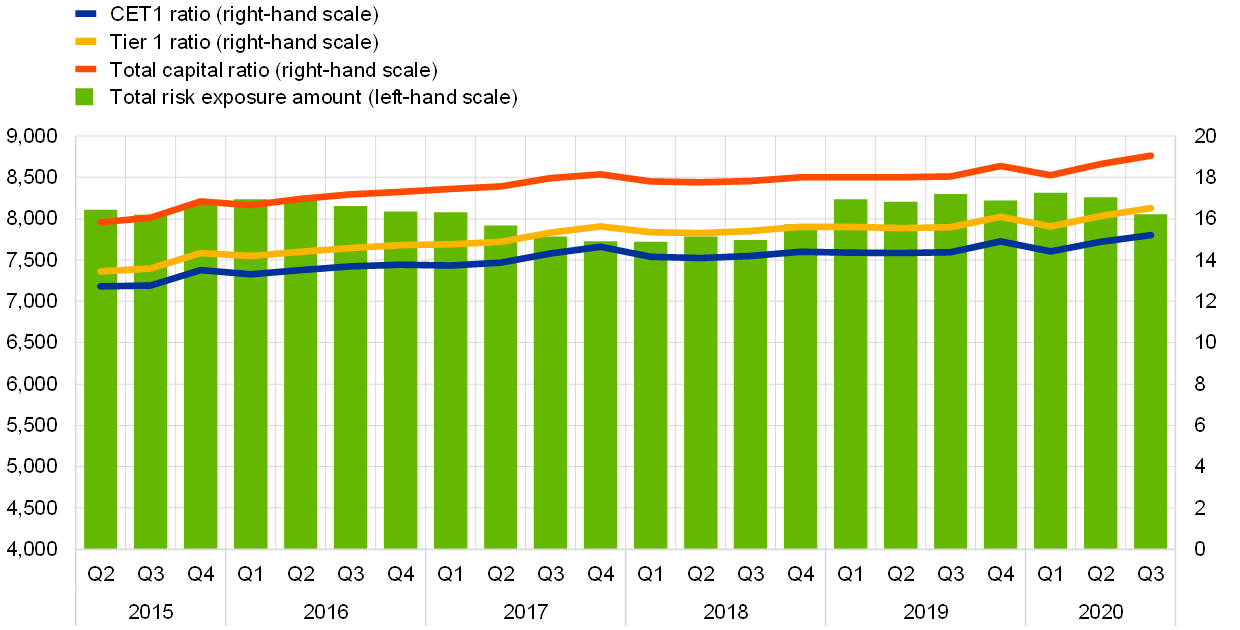
Source: ECB.
The aggregate leverage ratio has also proven robust throughout the pandemic, standing at 5.6% in the third quarter of 2020, compared with 5.7% at the end of 2019. However, risks to capital adequacy may only materialise on banks’ balance sheets later and could be amplified by cliff effects resulting from the expiry of the support measures put in place in 2020, such as moratoria, furlough schemes, government guarantees and other transitional regulatory arrangements.[2]
Chart 2
Leverage ratio of significant institutions
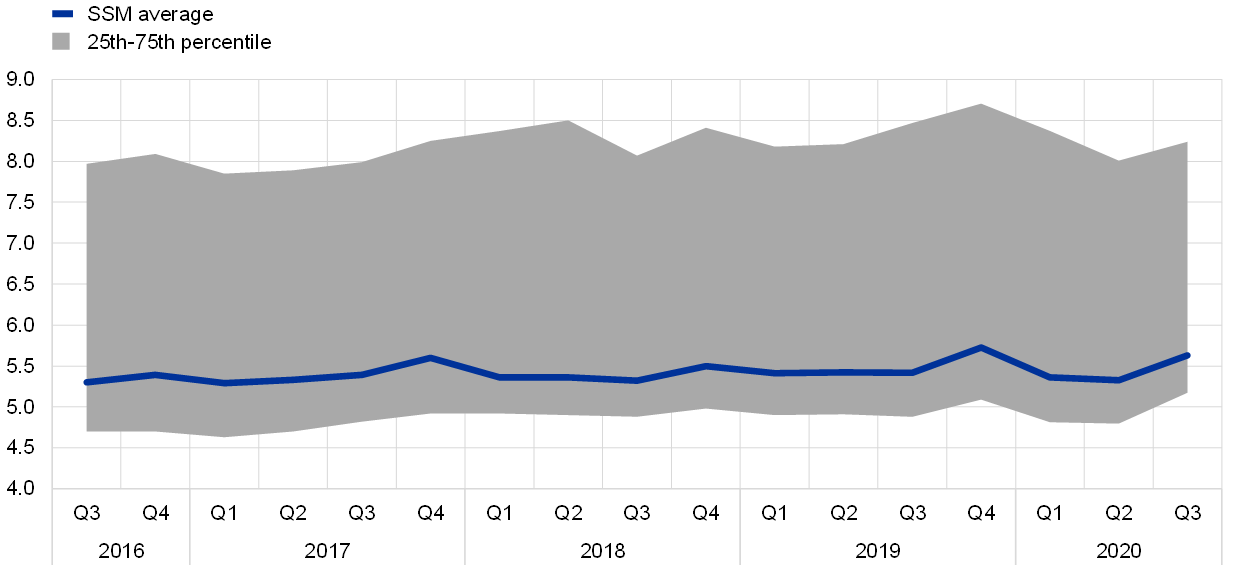
Source: ECB.
Euro area banks started the year with comfortable liquidity buffers. However, in March, severe pressure from the COVID‑19 shock started to materialise.
Euro area banks started the year with larger liquidity buffers compared with the start of the great financial crisis, as a result of the Basel III reforms. However, in the course of March 2020, severe pressure from the COVID-19 shock started to materialise. On the demand side, corporate customers from sectors affected by the crisis requested significant funding support from the banking sector by drawing down their existing committed credit lines. In addition, major volatility spikes in most financial markets triggered margin calls from central clearing counterparties, while money market funds faced unprecedented outflows and required some internationally active banks to buy back their outstanding commercial paper.
On the supply side, banks’ liquidity was constrained as well. Key funding markets dried up during March, preventing banks from issuing paper on the unsecured segment of the market, regardless of the maturity, while they were able to raise funds on the secured segment (repo) only for very short maturities. Against this background, offshore US dollar funding markets became particularly expensive when available, which further exacerbated banks’ reliance on internal liquidity buffers and on additional credit from the ECB.
As part of its response to the COVID-19 crisis, ECB Banking Supervision also allowed banks to make use of their regulatory liquidity buffer, operating temporarily below the liquidity coverage ratio (LCR) requirement.[3] In parallel, a highly accommodative monetary policy stance, including an easing of collateral eligibility rules, ensured broad access to central bank funding for banks under European banking supervision. The average outstanding credit provided by the Eurosystem increased from €659 billion in the fourth quarter of 2019 to €1,605 billion in the third quarter of 2020 (Chart 3).
Chart 3
Evolution of Eurosystem outstanding credit
(EUR billions)
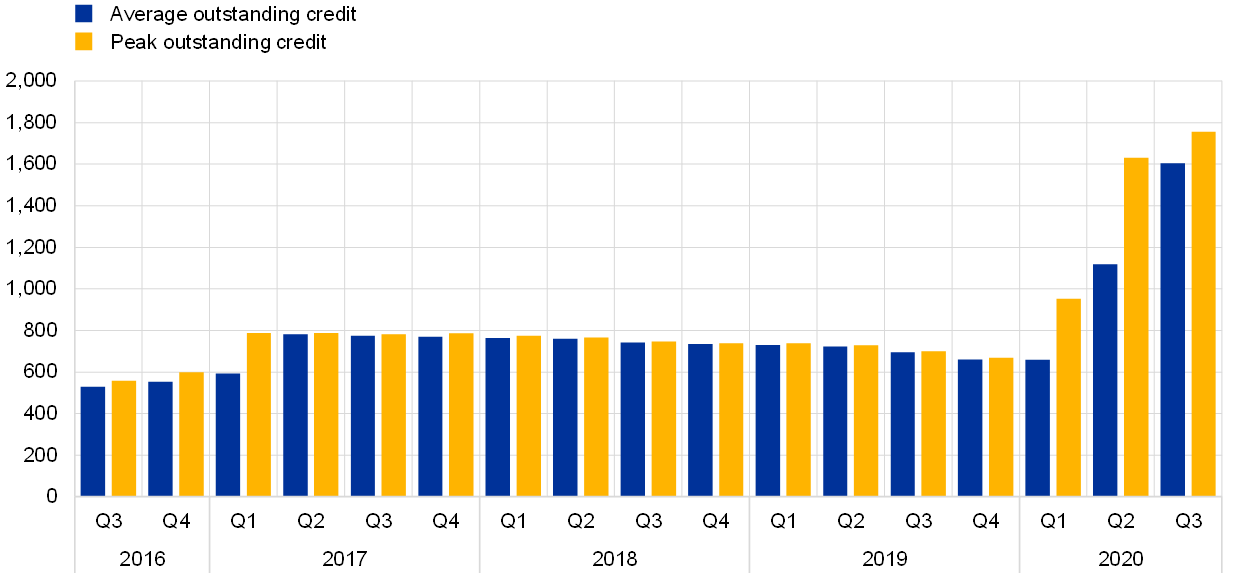
Source: ECB.
As a result of a strong and concerted policy response, market strains gradually eased in the second quarter of the year. As of April 2020, banks’ funding conditions started to improve. Some banks were again able to issue unsecured instruments, including on the subordinated segment of the market, although at higher yields with respect to pre-crisis levels; at the same time, an increase in customers’ deposits, largely driven by precautionary savings from households, provided extra liquidity buffers across the board. Overall, significant institutions (SIs) increased their liquidity buffers, as illustrated by an average LCR ratio of 170.94% in the third quarter of 2020, up from 145.91% in the fourth quarter of 2019.
Chart 4
Evolution of liquidity buffer and net liquidity outflows and LCR
(left-hand scale: EUR billions; right-hand scale: percentages)
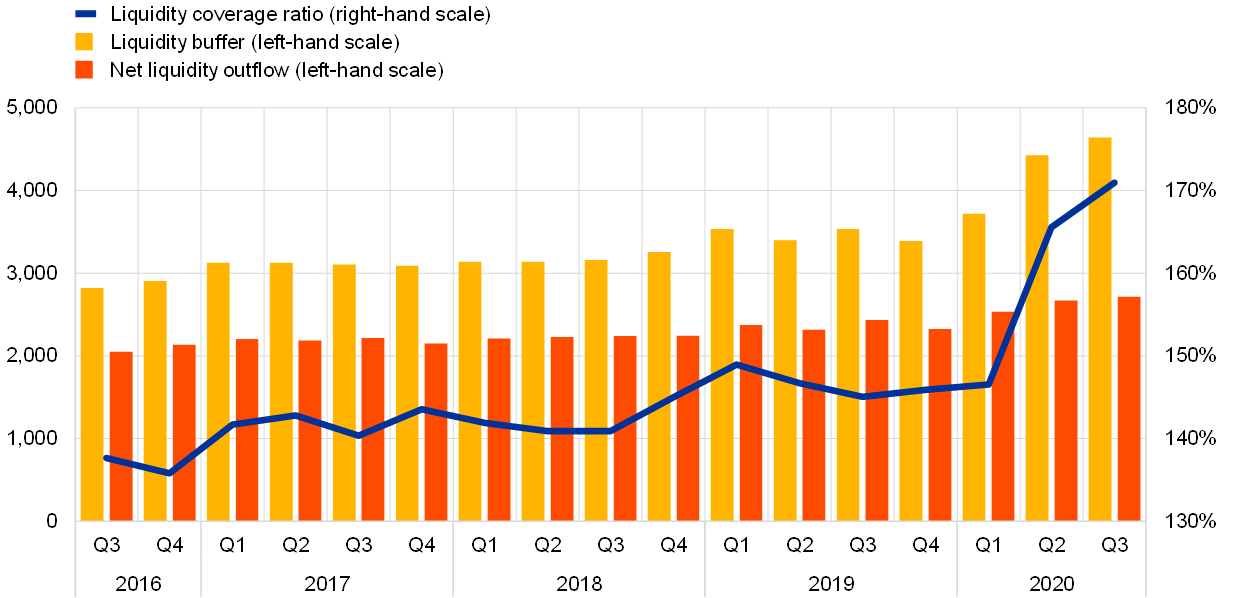
Source: ECB.
The collapse of stock prices in March had a negative impact on banks’ market risk positions
The outbreak of the COVID-19 pandemic in Europe and the United States led to a collapse in stock prices, a surge in volatility and a generalised widening of sovereign and corporate credit spreads throughout March. This had a negative impact not only on banks’ balance sheets, but also on their capital requirements for market risk based on internal models as well as their prudent valuation adjustments (especially for market price uncertainty and model risk), which are correlated with recent volatility. In response to the shock, supervisory relief measures were taken to limit the procyclical effects of the crisis on capital requirements for market risk and valuation adjustments (e.g. exclusion of certain instances of overshooting in the back-testing of internal models, increase in diversification benefits for prudent valuation adjustments). Additional relief came when market conditions improved in the second and third quarters.
Chart 5
Evolution of risk-weighted assets and prudent valuation adjustments for market risk
(EUR billions)
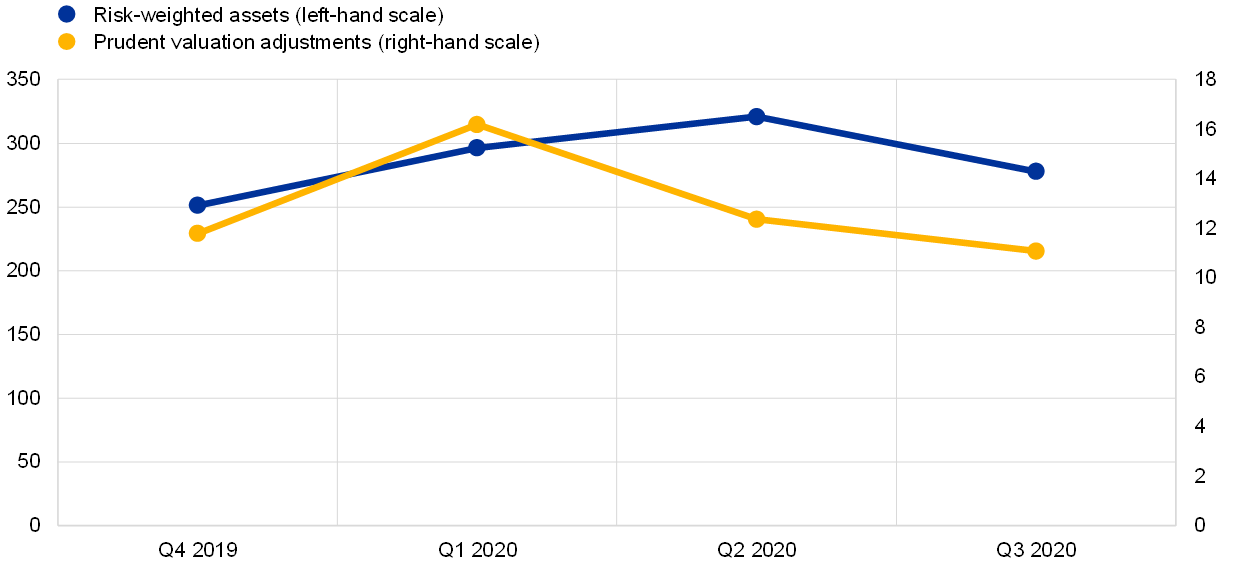
Source: ECB.
Overall, the capital and liquidity measures put in place, in combination with the extraordinary public support measures adopted by the authorities in the early stages of the COVID-19 pandemic, allowed banks to smooth out credit risk developments and continue to provide funding to the real economy. Loans and advances to households and non-financial corporations (NFCs) remained broadly stable from the outbreak of the COVID-19 pandemic onwards (-1.3% for NFCs and +0.8% for households from March to September 2020). Public guarantees were particularly relevant to the provision of funding to NFCs (€260 billion as at September 2020).
The extraordinary measures put in place to ease financing conditions and support households, small businesses and corporates also contributed to keeping the overall amount of non-performing loans (NPLs) on banks’ balance sheets broadly stable throughout the year. However, NPLs are expected to increase in the future as support measures expire. In this context, ECB Banking Supervision highlighted, in its July and December communications[4], that it is key for banks to provide appropriate solutions to viable distressed debtors in a timely manner, and thus help contain the build-up of problem assets at banks and minimise cliff effects where possible. To this end, banks should ensure that risk is adequately assessed, classified and measured on their balance sheets. They should have effective risk management practices in place to identify, assess and implement solutions which can best support these debtors while protecting banks against any negative credit risk effects. At the same time, banks should continue to effectively manage the stock of NPLs that already existed prior to the outbreak of the pandemic.
Chart 6
Evolution of SIs’ NPLs (total loans)
(left-hand scale: EUR billions; right-hand scale: percentages)
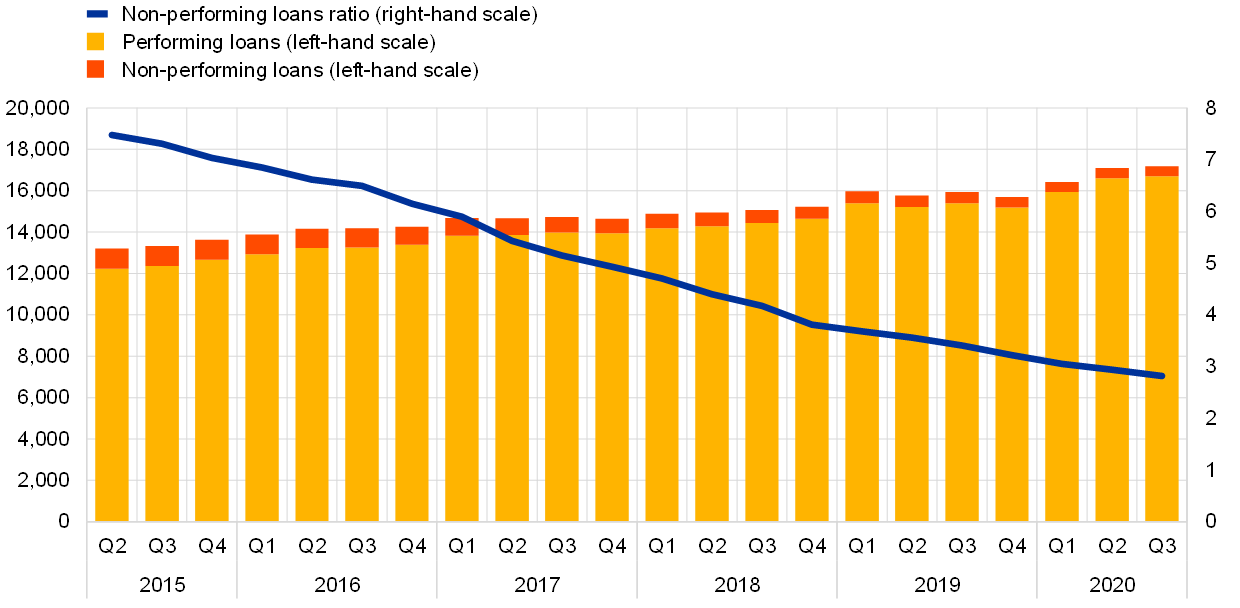
Source: ECB.
Chart 7
Loans subject to support measures as share of total loans
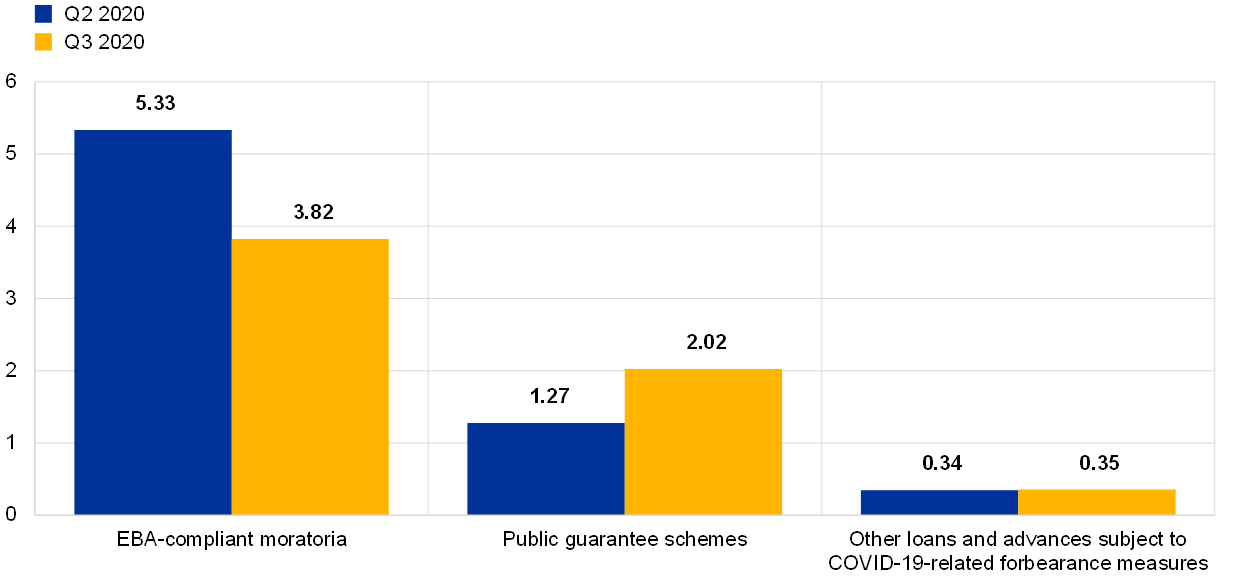
Source: ECB.
Operational risks have increased since the outbreak of the COVID-19 pandemic. However, no major operational or IT-related incidents were reported by supervised banks in 2020.
Operational risks have increased since the outbreak of the COVID-19 pandemic, reflecting the changes in banks’ operating models and additional complexities stemming from the implementation of government relief programmes. Notwithstanding this, no major operational or IT-related incidents were reported by supervised banks in 2020. Although there was an increase in the number of cyberattack attempts, in particular distributed denial of service (DDoS) and phishing attacks on banking customers facilitated by the pandemic, this had a very limited impact on the availability of ICT systems and on the amount of losses caused by these attacks.[5] At the early stages of the pandemic, SIs activated their business continuity plans, with the percentage of staff teleworking increasing notably (Chart 8). During the summer, banks started to move towards “new normal” governance arrangements, including a gradual return to the office; the renewed rise in infection rates that began in the autumn, however, reversed this trend, with many banks making remote working the preferred or mandatory solution again.
Chart 8
Remote working at SIs
(percentage of workforce working remotely)
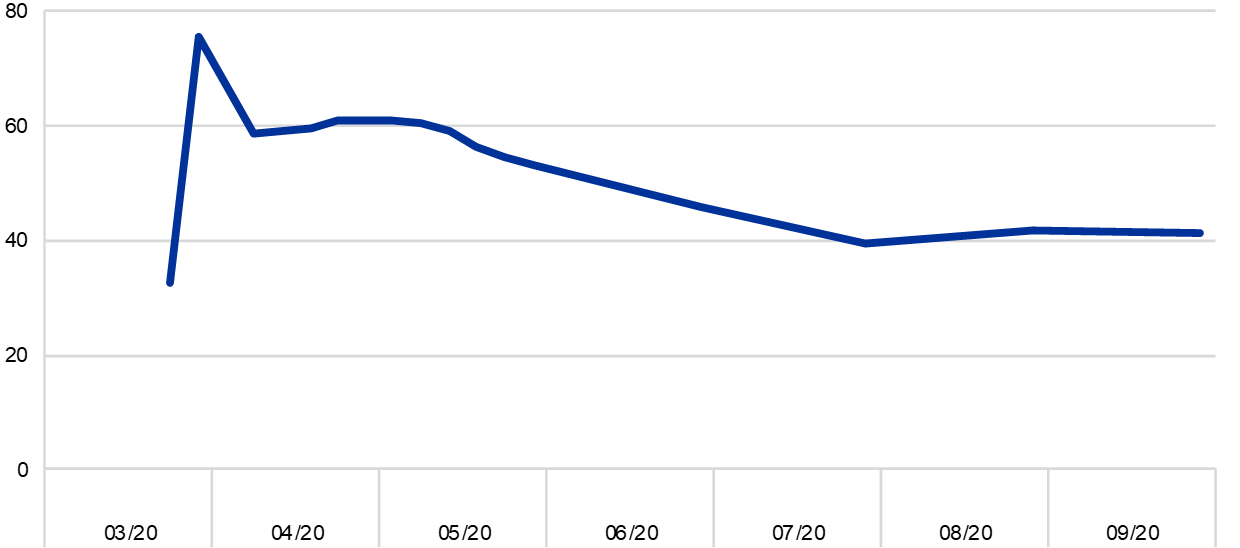
Source: ECB.
Note: A consistent sample of SIs which reported all data points in the period considered was used.
In 2020 ECB Banking Supervision conducted a vulnerability analysis (VA) of 86 SIs to estimate the impact that the COVID-19 crisis may have on the euro area banking sector. The aggregate results were published on 28 July 2020.[6] In the same way, an assessment of the credit and liquidity risk vulnerabilities that could be driven by a worsening of the economic situation has been performed for the less significant institutions (LSIs) sector.[7]
The results of this exercise showed that the euro area banking sector can broadly withstand the pandemic-induced stress. But there is still material uncertainty about the extent to which asset quality will deteriorate once the moratorium measures are lifted, particularly within the most affected economic sectors. This uncertainty around the trajectory of asset quality is reflected in the different provisioning policies adopted by banks and remains a matter of supervisory concern.
The VA tested two pandemic-related scenarios that included, to a large extent, the impact of the monetary, supervisory and fiscal relief measures taken in response to the COVID-19 crisis. In the central scenario – the one most likely to materialise according to Eurosystem staff – SIs’ average CET1 ratio dropped from 14.5% to 12.6%, confirming that banks under European banking supervision are currently sufficiently capitalised to withstand a short-lived deep recession. The existing capital buffers would broadly enable the sector to withstand also the impact of the severe scenario which assumed a deeper recession and a slower economic recovery, reducing the banks’ average CET1 ratio from 14.5% to 8.8%. Nevertheless, in this scenario some banks would need to take action to continue to meet their minimum capital requirements.
The outcome for the two scenarios confirmed that euro area banks entered the COVID-19 crisis with significantly higher capital levels and far greater resilience to withstand unexpected financial stress than was the case at the time of the great financial crisis. The results of the VA fed into the Supervisory Review and Evaluation Process (SREP) in a qualitative manner in order to help supervisors to challenge banks’ capital projections, foster consistency in the assessment of risks and promote prudent provisioning policies.[8]
Chart 9
2022 transitional CET1 ratio projections across scenarios
(percentages)
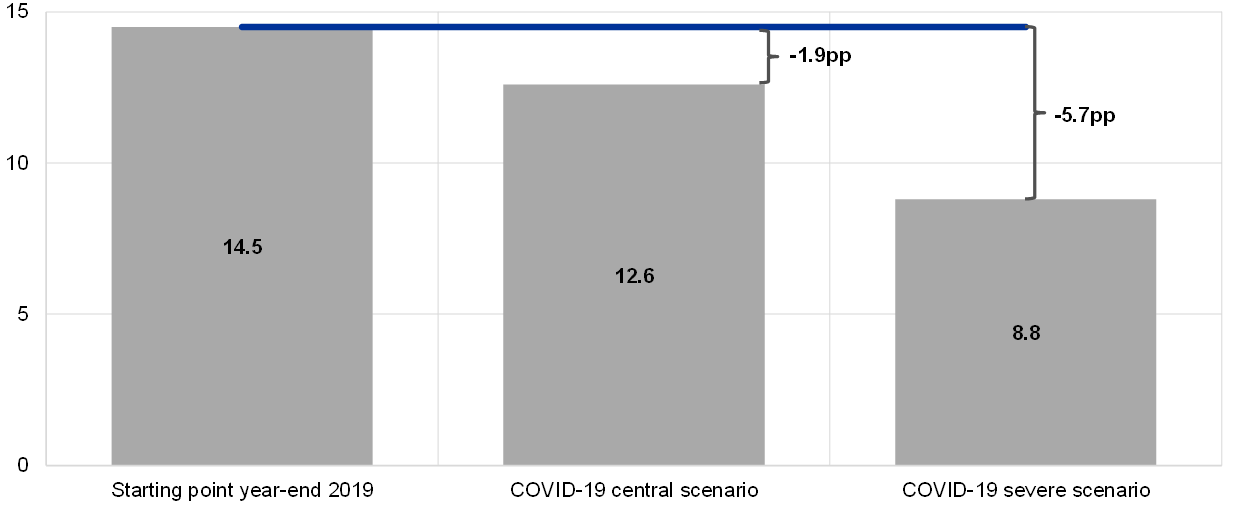
1.1.2 General performance of euro area banks
The pandemic had a negative impact on the profitability of SIs in 2020, mainly owing to a surge in impairments and provisions
In 2020 the profitability of euro area SIs declined substantially as a result of the COVID-19 pandemic, with the aggregate annualised return on equity standing below banks’ self-reported cost of equity and decreasing to 2.1% in the first three quarters of 2020[9], from 5.2% at the end of 2019 (Chart 10). The decline in profitability was also reflected in a further drop in banks’ price-to-book ratios, which hit a new low median value of 0.3 in April 2020, making it hard for SIs to tap equity markets without significantly diluting existing shareholders.
Chart 10
SIs’ aggregate return on equity broken down by income/expense source
(percentage of equity)
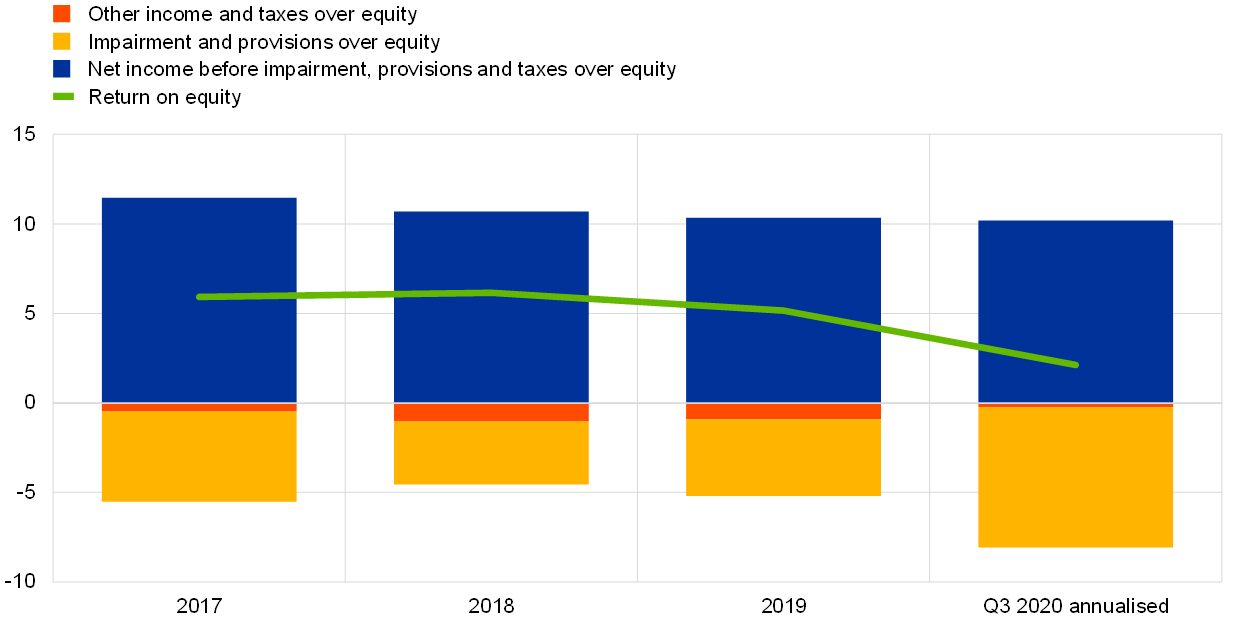
Source: SSM Supervisory Statistics, for the unbalanced sample of all SIs.
The increase in loan loss impairments resulting from the deterioration of the macroeconomic environment was the main driver of the decrease in profitability. This was not accompanied by a rise in NPLs, but merely reflected the increased credit risk of many exposures. Large one-off impairment of goodwill and deferred tax assets in certain SIs accentuated the reduction in aggregate profitability.
Chart 11
SIs’ cost-to-income ratios and indexed components
(percentages)
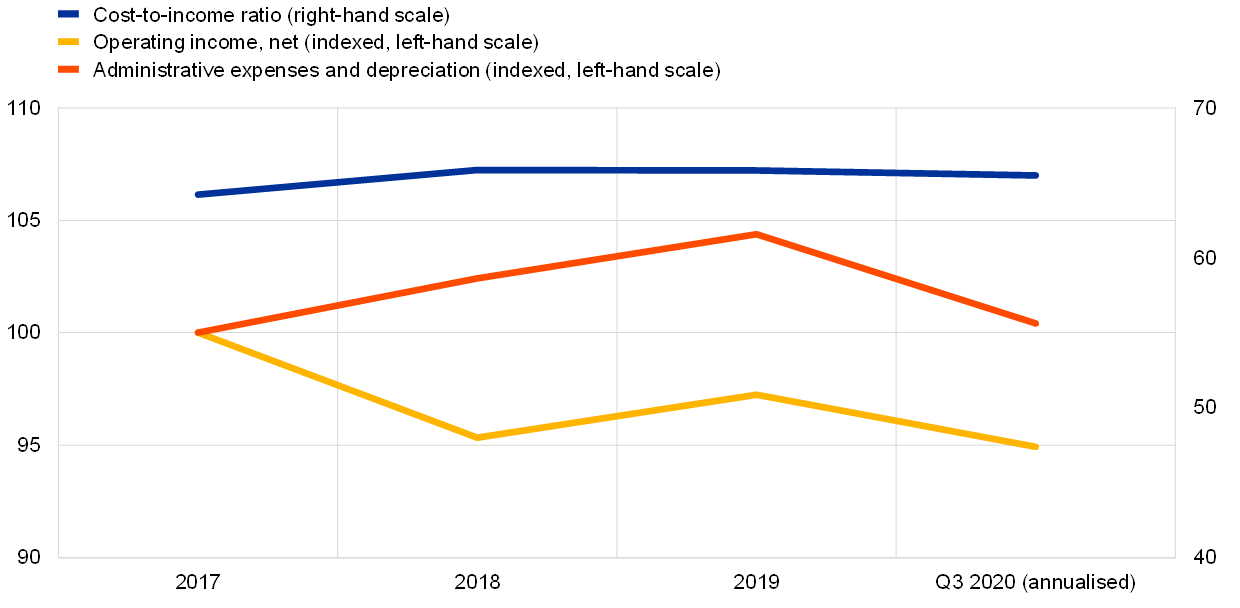
Source: SSM Supervisory Statistics, for the unbalanced sample of all SIs.
In 2020 banks’ aggregate cost-to-income ratio remained unchanged from the high level of the previous years (Chart 11). Declines on the income side were partly offset by cost reductions, so that operating income before impairment, provisions and taxes remained rather stable. On a positive note, the crisis allowed banks to increase the pace of digitalisation, which could lead to more efficient cost structures in the medium term.
To preserve operational continuity and competitiveness in the face of COVID-19 developments, SIs expanded their digital outreach to clients and increased their range of services, including online advisory services and more contactless payments. This digitalisation push, which aimed to respond to customer demand, facilitated cost reduction. Cost reductions were also a result of branch closures, reduced travel expenses and other temporary factors. Despite the increase in lending and historically low funding rates offered by the recent targeted longer-term refinancing operations, SIs’ net interest income declined further in 2020. Net fee and commission income also decreased across most of the fee-generating activities.
The profitability of LSIs in 2020 was also negatively affected by the increased level of impairments
In the same way as it did for SIs, the profitability of LSIs declined in 2020 mainly owing to increased impairments and provisions as a result of deteriorated macroeconomic conditions. The average return on equity for LSIs in June 2020 was 3.5%, down from 5.1% at the end of 2019. Interest revenues, which represent the largest income component for LSIs, remained relatively stable in the first half of 2020 with respect to the previous year (Chart 12). However, net interest income decreased slightly, owing to an increase in interest expenses. Finally, LSIs’ cost of risk, measured as the ratio of financial impairments to pre-provision profits, increased sharply from 12.4% at end-2019 to 22.4% in June 2020.
Chart 12
Evolution of LSIs’ interest income, interest expenses and net interest income
(EUR billions)
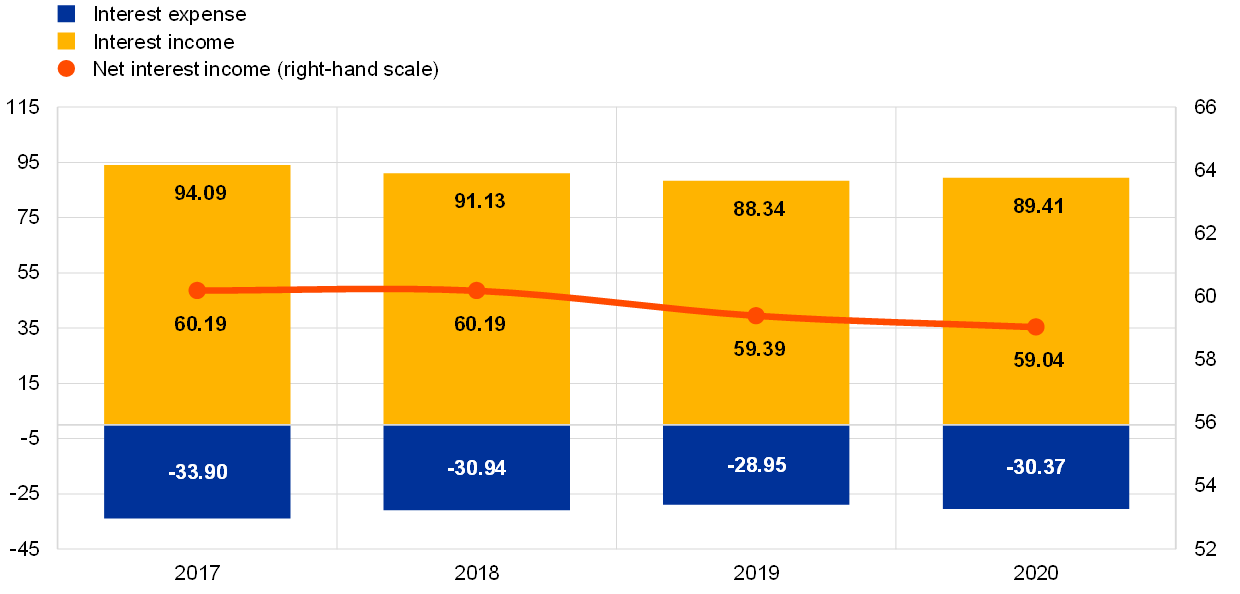
Source: ECB supervisory banking statistics.
Notes: The chart is based on a changing sample of LSIs. Data for the second quarter of 2020 are annualised using a four‑quarter trailing method.
On the cost side, LSIs continued their efforts to reduce overall expenditure mainly by minimising their administrative expenses (Chart 13). The cost-to-income ratio of LSIs at the end of June 2020 was 72%, slightly higher than it was at the end of 2019 (70%). The gross NPL ratio of the LSI sector increased slightly, to 2.1%, as of the second quarter of 2020, up by 20 basis points from December 2019.
Chart 13
Overview of LSIs’ costs
(left-hand scale: EUR billions; right-hand scale: percentages)
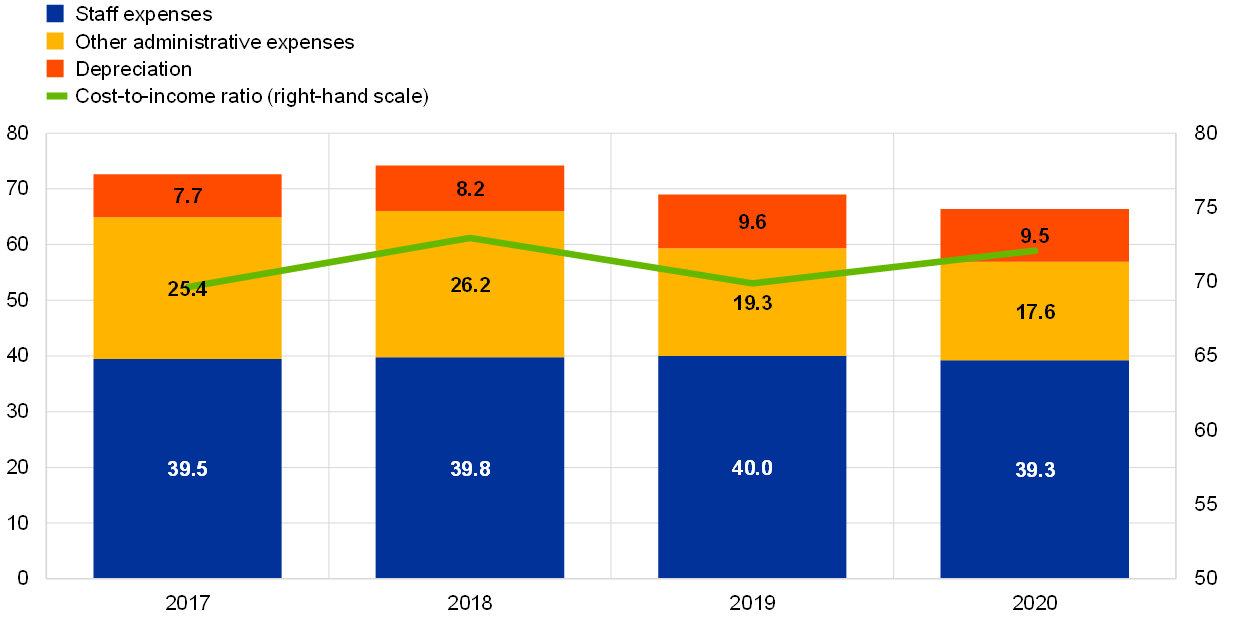
Source: ECB supervisory banking statistics.
Notes: The chart is based on a changing sample of LSIs. Data for the second quarter of 2020 are annualised using a four‑quarter trailing method.
1.1.3 Main risks in the banking sector
In close cooperation with the national competent authorities (NCAs), every year ECB Banking Supervision identifies the key risks for banks in the short and medium term (over a horizon of two to three years). The 2019 exercise had originally identified the following key risk drivers for the years 2020 and beyond: (i) business model sustainability, (ii) cybercrime and IT deficiencies, and (iii) resurfacing economic, political and debt sustainability challenges in the euro area. Other risk drivers identified included the execution risk attached to banks’ strategies for NPLs, misconduct, money laundering and terrorism financing, Brexit, and climate change.
The structural weaknesses in banks’ profitability were aggravated by the pandemic-related downturn in 2020
The COVID-19 pandemic required ECB Banking Supervision to shift its supervisory focus onto the more pressing challenges stemming from the crisis and to take ad hoc measures to strengthen banks’ ability to operate in a new environment.[10] But beyond the immediate burden created by the highly uncertain economic outlook, the COVID‑19 crisis ultimately exacerbated what had already been identified as the most prominent risks to the euro area banking sector even before the outbreak of the pandemic.
The low profitability of euro area banks and the sustainability of their business models had also been a supervisory concern in past years, mainly owing to many SIs’ rigid cost structures and general difficulties in generating adequate profit margins in the context of the prolonged low interest rate environment and excess capacity in the European banking sector. The economic downturn caused by COVID‑19 pressured banks’ profitability further, owing to an increase in impairments and provisions, thus increasing the urgency for them to address structural weaknesses and accelerate the future-proofing of their business models.
The deterioration of asset quality in banks’ balance sheets is a concern as the COVID-19 crisis progresses
The still high aggregate level of NPLs in the euro area at the end of 2019 was also a matter for supervisory concern going into 2020. In this context, the COVID-19 crisis heightened the risk of further build-up of NPLs in the future, reflecting the negative effect of the pandemic on the solvency of bank borrowers.
At the start of European banking supervision, the ECB identified the need for improvements to the governance frameworks of euro area banks, and this was still the case at the end of 2019. The functioning of banks’ boards and their organisational frameworks, internal control functions, data aggregation capabilities and the quality of their data were among the areas in which shortcomings had been identified and were therefore areas of supervisory focus.
The COVID-19 crisis exacerbated weaknesses in several governance and risk management areas, most of which had been identified before the outbreak of the pandemic
The COVID-19 crisis provided further evidence of these weaknesses, namely: (i) shortcomings in reporting and data aggregation, potentially hampering banks’ decision-making processes; (ii) low involvement of the management body in its supervisory function in strategic decisions in the areas seriously affected by the crisis, such as credit risk and capital planning, and insufficient scrutiny of those decisions; (iii) insufficient proactivity of the control functions, especially risk management and compliance, in coping with the crisis, with some banks continuing to be understaffed and lacking adequate IT tools and processes to identify, measure and monitor risks.
The market turmoil observed in the first quarter of the year also exposed the market risks that banks are more susceptible to, and which prove challenging to quantify and manage, especially in times of high volatility. Losses incurred in the trading book were often a result of downward adjustments in the valuation of derivative positions, especially credit valuation adjustments and funding valuation adjustments, and an increase in basis risk embedded in arbitrage trades, such as equity arbitrage transactions. Furthermore, falling equity prices and widening credit spreads had a material impact on instruments in the banking book accounted for at fair value, while low interest rates had a negative impact not only on the profitability of the core business, but also on the quantification of pension liabilities.
Box 1
Measures taken by ECB Banking Supervision to address the COVID-19 pandemic
Since 12 March the ECB has taken a series of supervisory and operational relief measures to preserve financial stability while ensuring that banks continue to fulfil their role in funding the real economy.
Since the outbreak of the COVID-19 pandemic, ECB Banking Supervision has adopted comprehensive measures aimed at providing temporary capital and operational relief for banks in participating countries. On 12 March it decided to allow banks to operate temporarily below the level of capital defined by the Pillar 2 guidance (P2G) and the combined buffer requirement, as well as the level of liquidity defined by the liquidity coverage ratio (LCR). These temporary measures were complemented by the appropriate relaxation of the countercyclical capital buffer (CCyB) by the national macroprudential authorities. Banks were also allowed to use capital instruments that did not qualify as Common Equity Tier 1 (CET1), such as Additional Tier 1 (AT1) or Tier 2 (T2) instruments, to meet part of their Pillar 2 requirements (P2R). This brought forward the change in the capital composition of banks’ P2R that was initially scheduled to come into effect only in January 2021, as part of the latest revision of the Capital Requirements Directive (CRD V). In addition, the ECB informed banks about the measures they could take to increase operational flexibility in the implementation of their bank-specific supervisory measures. The ECB also fully supported the decision of the European Banking Authority (EBA) to postpone the EU-wide stress test by one year and extended the postponement to all banks subject to the 2020 stress test.
To ensure that banks in the banking union were able to continue to fulfil their role in funding households and corporations amid the COVID-19 shock, on 20 and 27 March ECB Banking Supervision provided further details on the operationalisation of the measures announced on 12 March and announced additional measures, such as providing further flexibility in the prudential treatment of loans backed by public support measures and offering guidance to banks on how to avoid excessive procyclical effects when applying the IFRS 9 accounting standards. In exercising flexibility, the ECB sought to balance the need to help banks absorb the impact of the current downturn on the one hand, and the need to maintain correct risk identification practices and risk management incentives on the other, as well as ensuring that only sustainable solutions for viable distressed debtors were deployed.
In response to the extraordinary levels of volatility recorded in the financial markets, on 16 April the ECB also provided clarifications on how banks could avoid an unwarranted increase in capital requirements for market risk by temporarily adjusting the supervisory component of those requirements. As well as smoothing procyclicality, this measure aimed to maintain banks' ability to provide market liquidity and to continue market-making activities. The amendment to the Capital Requirements Regulation[11] (CRR II “quick fix”) published on 26 June 2020 introduced, inter alia, additional flexibility for the competent authorities to address the extreme market volatility observed during the COVID-19 pandemic by enabling the ECB to allow banks to exclude any market risk internal model overshootings occurring between 1 January 2020 and 31 December 2021 that do not result from deficiencies in internal models.
To facilitate the implementation of monetary policies in exceptional circumstances, the CRR II “quick fix” also granted the competent authorities the discretion to temporarily allow the exclusion of certain central bank exposures from the leverage ratio total exposure measure, after consulting the relevant central bank. On 17 September the ECB exercised this discretion and announced that banks under its direct supervision were allowed to exclude certain central bank exposures from the leverage ratio total exposure measure until 27 June 2021. This decision followed the determination by the Governing Council that there were exceptional circumstances due to the COVID-19 pandemic.
Through the summer of 2020, the ECB continued to encourage banks to use their capital and liquidity buffers for lending purposes and loss absorption. In its communication in July the ECB stressed that it would not require banks to start replenishing their capital buffers before the peak in capital depletion was reached. Specifically, the ECB committed to allowing banks to operate below the P2G and the combined buffer requirement until at least end-2022, and below the LCR until at least end-2021, without automatically triggering supervisory actions. It clarified that the exact timeline would be decided on following the 2021 EU-wide stress test, and, as in every supervisory cycle, on a case-by-case basis according to the individual situation of each bank.
As the euro area banking sector had shown sufficient operational resilience throughout the spring and early summer of 2020, in July 2020 the ECB decided not to extend the six-month operational relief measures it had granted to banks in March 2020, with the exception of the submission of NPL reduction strategies for high-NPL banks. These banks were nevertheless expected to continue to actively manage their NPLs. The ECB also resumed the follow-up with banks on remedial actions following earlier SREP decisions, on-site inspections and internal model investigations. It also resumed the issuance of decisions following the targeted review of internal models (TRIM), on-site follow-up letters and internal model decisions and sent letters to banks communicating its expectations that they should have in place effective management practices and sufficient operational capacity to deal with the expected increase in distressed exposures.[12]
At the end of 2020 the ECB continued to closely monitor the COVID-19 crisis and its implications for the banking sector, in close contact with other authorities and supervised banks, standing ready to use the flexibility within its supervisory toolkit to take further action where necessary.
Recommendations on dividends
Alongside the capital relief measures taken in March, ECB Banking Supervision took steps to ensure that banks conserved capital in the light of the extraordinary uncertainty caused by the COVID-19 pandemic. On 27 March the ECB issued a Recommendation to banks on dividend distributions. To boost banks’ capacity to absorb losses and support lending to households, small businesses and corporates, banks were recommended not to pay dividends for the financial years 2019 and 2020 until at least 1 October 2020, and to refrain from share buy-backs aimed at remunerating shareholders. This was to give banks additional capacity to lend or absorb losses at a time when it was particularly needed.
On 28 July the ECB extended its Recommendation on dividend distributions until 1 January 2021, while stressing that the measures remained temporary and exceptional and were aimed at preserving banks’ capacity to absorb losses and support the economy in an environment of exceptional uncertainty. As demonstrated by the vulnerability analysis, the level of capital in the system could decline significantly if a severe scenario were to materialise. The ECB also issued a letter to banks asking them to be extremely moderate with regard to variable remuneration payments, for example by reducing the overall amount of variable pay. Where this was not possible, banks were recommended to defer a larger part of the variable remuneration and consider payments in instruments, such as own shares. As usual, the ECB continued to assess banks’ remuneration policies as part of its SREP, in particular the impact that such policies might have on banks’ ability to maintain a sound capital base. The ECB’s approach to dividends and remuneration was aligned with the related European Systemic Risk Board (ESRB) Recommendation.
Ample capital buffers remained available as of the third quarter of 2020, partly thanks to the various capital relief measures taken by the ECB and macroprudential authorities. Aggregate capital headroom increased from 2.8% to 5.3% as of the third quarter of 2020, with P2G relief contributing 1.1%, P2R frontloading adding 0.5% and dividend restrictions, IFRS 9 transitional arrangements and macroprudential buffer relief providing 0.3% each according to estimates.
The ECB reviewed its stance on dividends and remuneration in the fourth quarter of 2020. On 15 December 2020 it issued a revised Recommendation that called on banks to exercise extreme prudence on dividends and share buy-backs. To this end, the ECB asked all banks to consider not distributing any cash dividends or conducting share buy-backs, or to limit such distributions, until 30 September 2021. Given the persisting uncertainty over the economic impact of the COVID-19 pandemic, the ECB expects dividends and share buy-backs to remain below 15% of the cumulated profit for 2019-20 and not higher than 20 basis points of the CET1 ratio, whichever is lower. The ECB communicated its expectation that only profitable banks with robust capital trajectories should consider paying dividends or buying back shares, and that banks considering such distributions should contact their Joint Supervisory Team (JST) to discuss whether the level of intended distribution would be prudent. The ECB also reiterated its position on variable remuneration in a further letter to banks. The recommendation reflected an assessment of the stability of the financial system and was made in close cooperation with the ESRB.
1.2 Supervisory priorities and projects in 2020
1.2.1 Supervisory priorities for 2020 and the pragmatic approach to the SREP
In 2020 the COVID-19 outbreak prompted the ECB to review its supervisory priorities, processes and activities, so as to support banks’ ability to serve the economy while addressing the operational challenges triggered by the pandemic. In this context, JSTs reprioritised their actions and shifted their focus towards banks’ ability to cope with the impact of the pandemic.
Against this background, supervisors engaged proactively with banks in order to discuss individual measures such as adjusting timetables, processes and deadlines for on-site inspections and internal model investigations. In addition, supervisors extended the deadlines for certain non-critical supervisory measures and data requests.
In the same vein, ECB Banking Supervision took a pragmatic approach to implementing its annual core activity – the Supervisory Review and Evaluation Process (SREP) – in line with the EBA Guidelines[13].
In 2020 the COVID-19 outbreak prompted the ECB to review its supervisory priorities, processes and activities. ECB Banking Supervision took a pragmatic approach to implementing its annual core activity, the SREP.
Under the 2020 pragmatic approach to the SREP, the ECB focused on banks’ ability to handle the challenges and risks to capital and liquidity arising from the ongoing crisis. As a general rule, the ECB decided to keep the capital add-ons (P2R and P2G) unchanged and not to update SREP scores, unless changes were justified by exceptional circumstances affecting an individual bank. Moreover, the ECB decided to address supervisory concerns via qualitative recommendations. In addition, the results of the ECB’s vulnerability analysis were used by JSTs to identify new vulnerabilities and to challenge banks’ financial and capital projections and were subsequently incorporated into the SREP assessments.
In line with the previous year’s drive to provide more transparency to banks and investors with the publication (in January 2020) of the supervisory capital requirements resulting from the SREP, in January 2021 the ECB published the aggregate SREP results with a breakdown by business model and bank-by-bank P2R with the related capital composition.[14] In this regard, in 2020 the SREP requirements and guidance for total capital, excluding systemic buffers and the countercyclical buffer, were kept stable on average at around 14%, while the CET1 capital requirement dropped from 10.6% in 2019 to 9.6% owing to the new criteria on the quality of capital for P2R. Banks were also allowed to partially use capital instruments that do not qualify as CET1 capital to meet the P2R, bringing forward a measure that was initially scheduled to come into effect in January 2021, as part of the latest revision of the Capital Requirements Directive (CRD V). In addition to capital requirements and guidance, in 2020 all banks received qualitative recommendations. Most recommendations were focused on the area of internal governance (mainly on internal control functions, the management body and new and old data aggregation issues) and credit risk (mainly regarding loan classification, provisioning and cliff effects). Compared with the previous SREP cycle (in 2019), findings on the credit risk and business model components increased significantly while findings related to internal governance and capital remained broadly stable, although the internal governance-related findings continued to be the most numerous in absolute numbers in 2020.
1.2.2 Work on credit underwriting criteria
To assess the quality of banks’ credit underwriting criteria, in 2019 ECB Banking Supervision launched a dedicated project to collect data on new loans granted by euro area banks between 2016 and 2018. The results were published in June 2020.[15] ECB Banking Supervision’s work on credit underwriting complements the ongoing strategic efforts to tackle existing NPLs.
The report on SIs highlighted some weaknesses in the way banks have granted and priced new loans in recent years; in particular, banks have been loosening their lending standards for loans to households. The analysis also found that banks with high levels of NPLs tended to grant housing loans more conservatively than other banks, and that not all banks paid sufficient attention to risk-based pricing, so as to ensure that loan pricing at least covered expected losses and costs. No evidence was found that banks using internal models to calculate capital requirements applied better risk-based pricing.
In 2019 ECB Banking Supervision launched a dedicated project to collect data on new loans granted by euro area banks. The report on SIs highlighted an increase in lending to households, fuelled in part by sharply rising house prices, but not fully backed by an increase in household income.
Lending to households increased markedly between 2016 and 2018, fuelled in part by sharply rising house prices, but not fully backed by an increase in household income (Chart 14). As a result, income-based key risk indicators (KRIs) in the residential real estate (RRE) and credit for consumption portfolios deteriorated, while pricing spreads declined.
New loans granted to NFCs, however, showed a mixed picture. The KRIs for the non-financial counterparties portfolio improved (Chart 15), although loan structures became riskier and pricing spreads decreased in this portfolio. The JSTs are conducting dedicated follow-up assessments in the context of day-to-day supervision.
Chart 14
Residential real estate: loan growth and macroeconomic factors
(compound annual growth rate between 2016 and 2018; percentages)
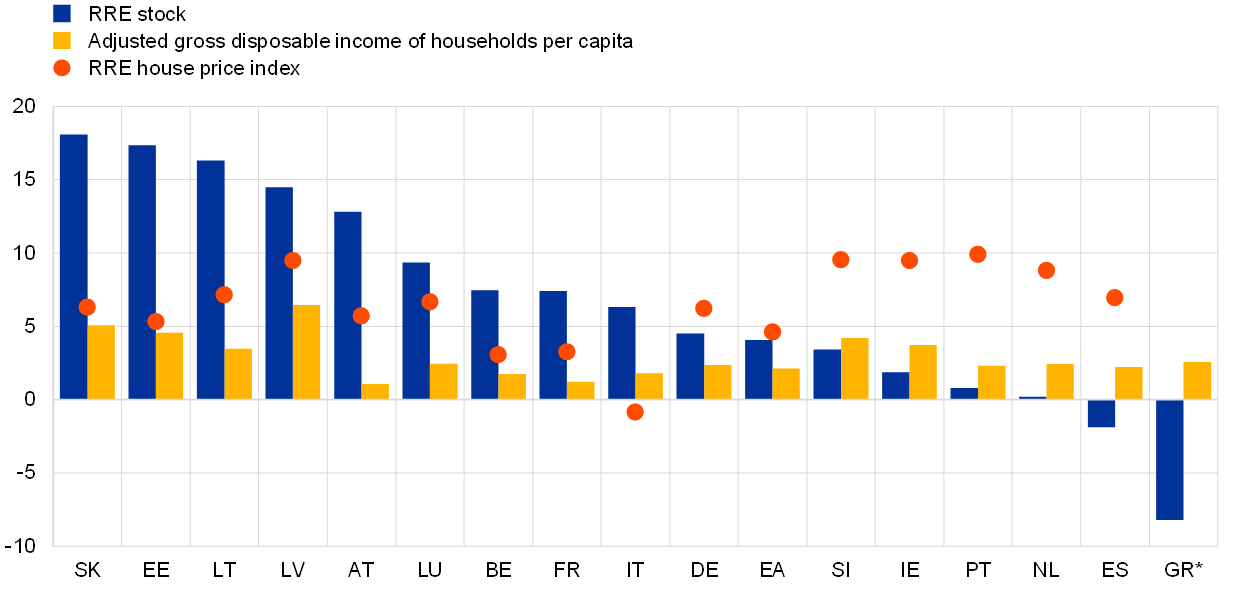
Sources: ECB Banking Supervision credit underwriting data collection 2019, Eurostat.
Notes: Data for the house price index in 2018 were not reported for Greece. Euro area and country averages are based on balanced data.
In parallel to the SI credit underwriting exercise, ECB Banking Supervision, in close cooperation with the NCAs, conducted a horizontal SSM-wide analysis of the loan granting practices of smaller banks based on a sample of LSIs. The LSI data collection took the principle of proportionality into account. The results indicate that most LSIs sampled face significant data availability challenges with respect to credit risk indicators. LSIs exhibited a much higher loan growth than their SI peers, as well as a significant increase in the loan burden of their borrowers. Intense market competition put further pressure on LSIs’ loan margins and forced them to adjust their business and risk strategies. LSIs’ loan pricing showed very weak correlation with the underlying credit risk. The ECB and the NCAs will follow up on the findings of the LSI credit underwriting standards exercise.
Chart 15
Small and medium-sized enterprises (SMEs): improving KRIs
(NBV-weighted average TDER, D/E ratio and ICR)
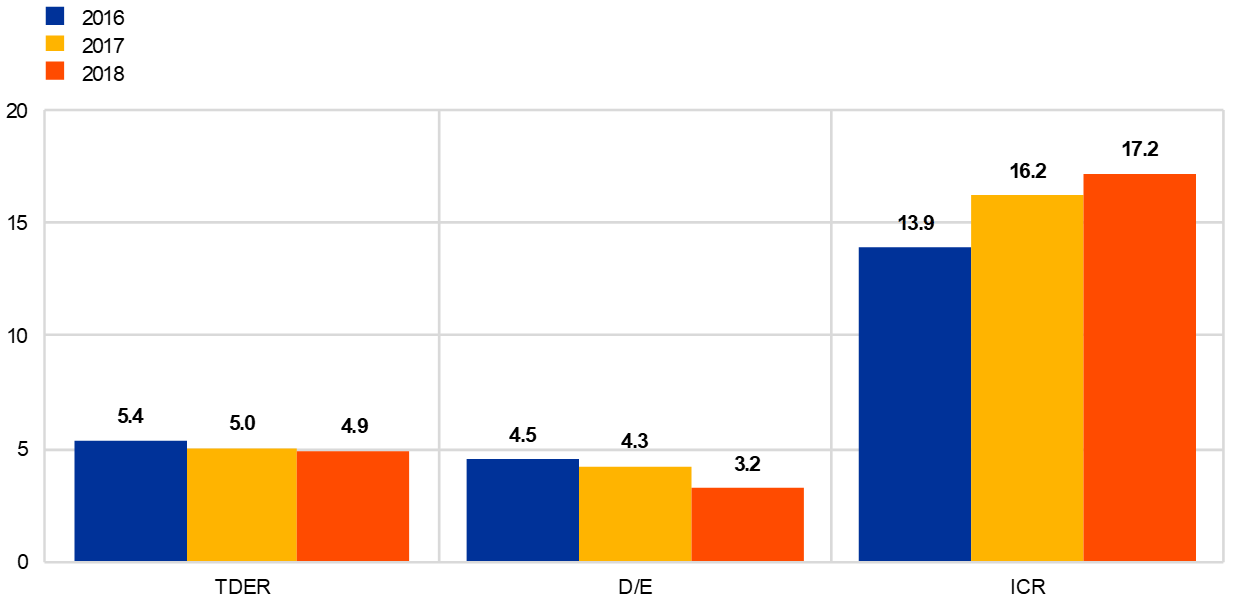
Sources: ECB Banking Supervision credit underwriting data collection 2019; European Commission Annual Report on European SMEs 2017/2018 and 2018/2019.
Notes: NBV = new business volume. TDER = total debt-to-EBITDA ratio. D/E = debt-to-equity ratio. ICR = interest coverage ratio. Averages are weighted by each institution’s SME stock or available data on NBV and are based on balanced data.
1.2.3 Work on NPLs
The stock of NPLs held by SIs decreased by about 50% between 2014 and 2020
The volume of NPLs held by SIs decreased from around €1 trillion (an NPL ratio of 8%) at the start of European banking supervision at the end of 2014 to €485 billion (an NPL ratio of 2.82%) at the end of September 2020, which corresponds to a reduction of around 50% (Chart 16). Similarly, for LSIs the NPL ratio has been decreasing since 2016, from 4.4% to 2.1% in June 2020.
Chart 16
Evolution of SIs’ NPLs
(left-hand scale: percentages; right-hand scale: EUR billions)
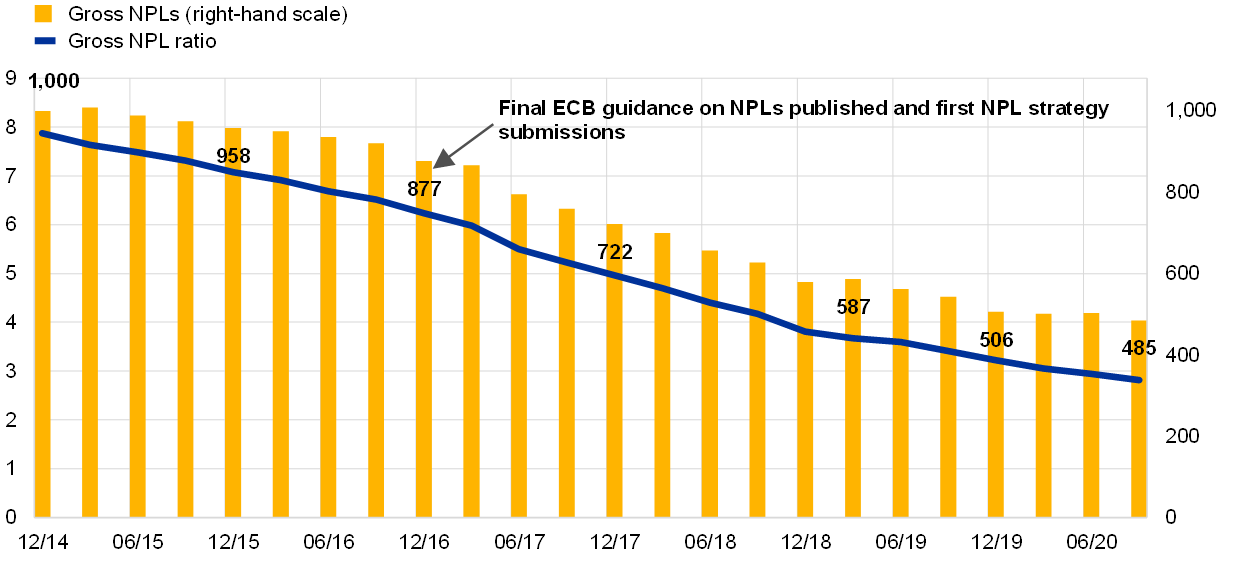
Source: ECB.
In 2019 high-NPL banks[16] reduced their NPL stock by 23%, exceeding their annual reduction target.
Chart 17
Planned NPL reduction for high-NPL banks for the full year 2019 against actual reduction in the year
(x-axis: sources of NPL increase and reduction; y-axis: EUR billions)
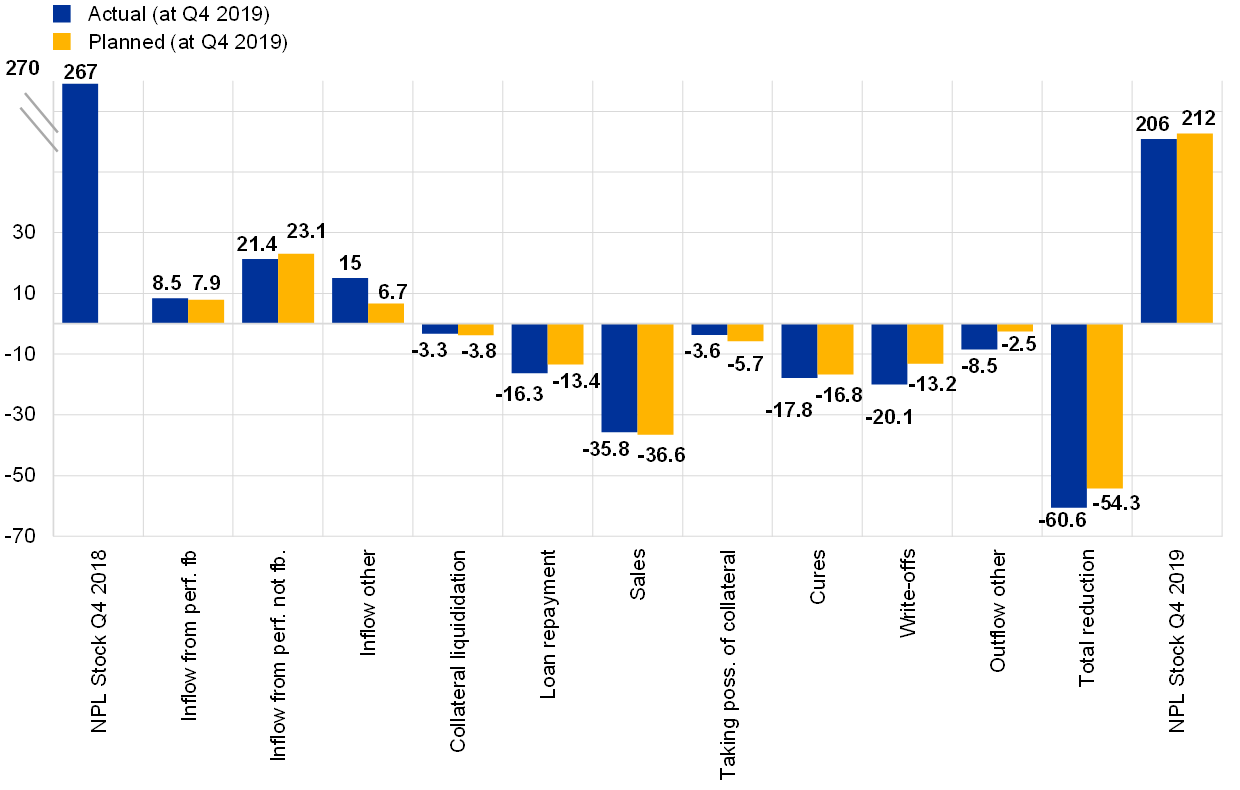
Source: ECB.
Note: Sample of 30 SIs.
The outbreak of the COVID-19 pandemic poses significant challenges for banks. First, SIs are expected to have to make additional efforts to further reduce their stock of NPLs, although this remained broadly stable until June 2020 and then decreased from €503 billion to €485 billion in the third quarter of 2020. Second, the adverse effects of the pandemic on the economy are expected to result in an increase of NPLs in the future. In this context, it is crucial that SIs strike the right balance between avoiding excessive procyclicality and ensuring that the risks they are facing are adequately reflected in their balance sheets.
In particular, there is a risk of severe cliff effects occurring when public support measures start to expire. Against this background, it is crucial that banks correctly identify and reflect credit risk on their balance sheets and are operationally prepared to deal with an increase in distressed debtors: a delay in recognising and acting to tackle the deterioration of asset quality would amplify procyclical effects and hamper the ability of the banking sector to support the economic recovery.
Timely and viable restructuring maximises recovery value and prevents the piling up of NPLs. High levels of NPLs lead to increased funding costs and a lower capacity to generate income, which also impair banks’ ability to support the economic recovery.
Postponing reclassification and adequate provisioning until the expiry of moratoria measures would lead to cliff effects, stronger deleveraging and, as a consequence, amplified procyclicality. Perceived inadequacy of banks’ loan valuation and classification policies would undermine the trust of investors in the banking sector and lead to increased funding costs. Strong deleveraging and increased funding costs reduce banks’ capacity to support the economic recovery.
ECB Banking Supervision responded to the outbreak of the COVID-19 pandemic with an extensive range of credit risk initiatives and external communications.[17] By complying with the EBA Guidelines on legislative and non-legislative moratoria on loan repayments[18], the ECB also offered banks flexibility on forbearance classification and assessment of distressed restructuring for exposures under moratoria that meet the criteria of the EBA Guidelines.
The ECB’s supervisory initiatives and communications are aimed at ensuring that SIs have in place effective credit risk management practices and sufficient operational capacity to ensure that credit risk is adequately assessed, classified and measured on their balance sheets. This should help to contain the deterioration of asset quality at banks, thus mitigating cliff effects wherever possible. The JSTs are engaging with SIs to follow up on their implementation of these credit risk supervisory expectations.
In addition, the ECB decided to postpone the deadline for the submission of NPL reduction strategies by high-NPL banks by 12 months, to March 2021. ECB Banking Supervision also clarified that the NPE coverage expectations remained fully in place for the stock of NPLs that had accumulated prior to the outbreak of the pandemic.
In its LSI oversight capacity, the ECB continued to assess the NCAs’ implementation of the EBA Guidelines on management of non-performing and forborne exposures[19]. Furthermore, with the support of the NCAs the ECB performed a credit risk vulnerability analysis to better understand the potential impact of the COVID-19 crisis on LSIs, also taking into account the mitigating effects of national measures. In 2021 follow-up activities will be focused, inter alia, on assessing the impact of the wind-down of national support measures on LSIs’ credit risk profiles, as well as LSIs’ readiness to deal with a potential increase in defaulting exposures.
1.2.4 Targeted review of internal models
A project spanning 2016 to 2020, the targeted review of internal models (TRIM) was designed to assess the adequacy and appropriateness of institutions’ internal models and harmonise supervisory practices relating to internal models across the Single Supervisory Mechanism (SSM). This resulted in an SSM-wide common understanding of the regulatory requirements related to internal models – the ECB Guide to Internal Models – and thus contributed to the reduction of unwarranted (i.e. non-risk-based) variability in risk-weighted assets (RWA) and a level playing field across banks in participating countries.
Under TRIM, 200 on-site model investigations were performed across 65 SIs
Four years on, the project is now approaching its conclusion. Under TRIM, 200 on-site model investigations were performed across 65 SIs between 2017 and 2019, covering internal models for credit, market and counterparty credit risks. A common methodological approach, based on standardised data requests and inspection techniques and tools, was developed for these investigations. In addition, several layers of quality assurance, cross comparisons and horizontal analyses were carried out in order to ensure the consistency and comparability of the outcomes of TRIM investigations.
Cases of non-compliance with regulatory requirements identified in the context of TRIM resulted in over 5,800 findings across all risk types, of which about 30% had a high severity.
As a consequence, the TRIM project entails an intense supervisory follow-up with the institutions involved, which are expected to address the shortcomings identified in combination with the implementation of new regulatory products over the coming years. Following the TRIM investigations, 179 decisions had been issued as at end-2020, containing different supervisory measures – in the form of obligations, recommendations and limitations – some of which have a substantial quantitative impact on RWA amounts.
TRIM will now be completed in the first half of 2021
The operational relief granted to institutions in March 2020 by ECB Banking Supervision in response to the COVID-19 outbreak included a six-month postponement of the issuance of TRIM decisions, on-site follow-up letters and internal model decisions not communicated to institutions by that date. As a result, the conclusion of the TRIM project was postponed from 2020 to the first half of 2021.
1.2.5 Work on ICAAP and ILAAP
Robust internal capital adequacy assessment (ICAAP) and internal liquidity adequacy assessment (ILAAP) processes are key to strengthening the resilience of banks and allowing them to continue to operate through the business cycle and withstand economic shocks. Both the ICAAP and the ILAAP aim to ensure that banks adequately measure and manage capital and liquidity risk in a structured, institution-specific way.
Capital and liquidity are key to ensuring the resilience of banks
ECB Banking Supervision has taken several measures to support banks in establishing their ICAAPs and ILAAPs as valuable risk management frameworks. Banks’ ICAAPs and ILAAPs are regularly reviewed as part of the SREP. In 2018 the ECB published guides to ICAAP and ILAAP to clarify its expectations regarding these processes. In 2019 it carried out a comprehensive analysis of the ICAAP practices of 37 SIs against the supervisory expectations it had set forth. The findings from this analysis were published in August 2020 in the ECB Report on banks’ ICAAP practices and they reveal that, while banks have significantly improved their ICAAPs in recent years, more work needs to be done, particularly in three main areas.
First, many banks still have in place inadequate data quality frameworks, which could hamper their ability to make well-informed decisions using reliable, quickly retrievable data.
Second, many banks do not account for the full set of risks that may have a material impact on their internal capital. Weaknesses were identified, for example, in how banks evaluate AT1 and T2 instruments when determining their internal capital needs to ensure business continuity (continuity assumption), and, more broadly, in how banks define the true economic value of their capital when covering their economic risks (economic value considerations), as Chart 18 shows. When combined with a failure to identify and quantify all material economic risks, banks’ ability to ensure their economic capital adequacy may be hampered and, as a result, their overall financial resilience may be weakened.
Third, stress testing has yet to become an effective, integral component of banks’ risk management practices, as Chart 19 shows. The COVID-19 pandemic has highlighted that banks are exposed to a wide range of threats that may materialise unexpectedly; however, many institutions do not systematically monitor the economic environment to identify new threats, and their stress-testing scenarios and capabilities are not regularly reviewed. This can seriously compromise banks’ ability to effectively respond to stress situations.
Chart 18
Consideration of continuity assumptions and economic value considerations in internal capital definition
Continuity assumption and economic value consideration
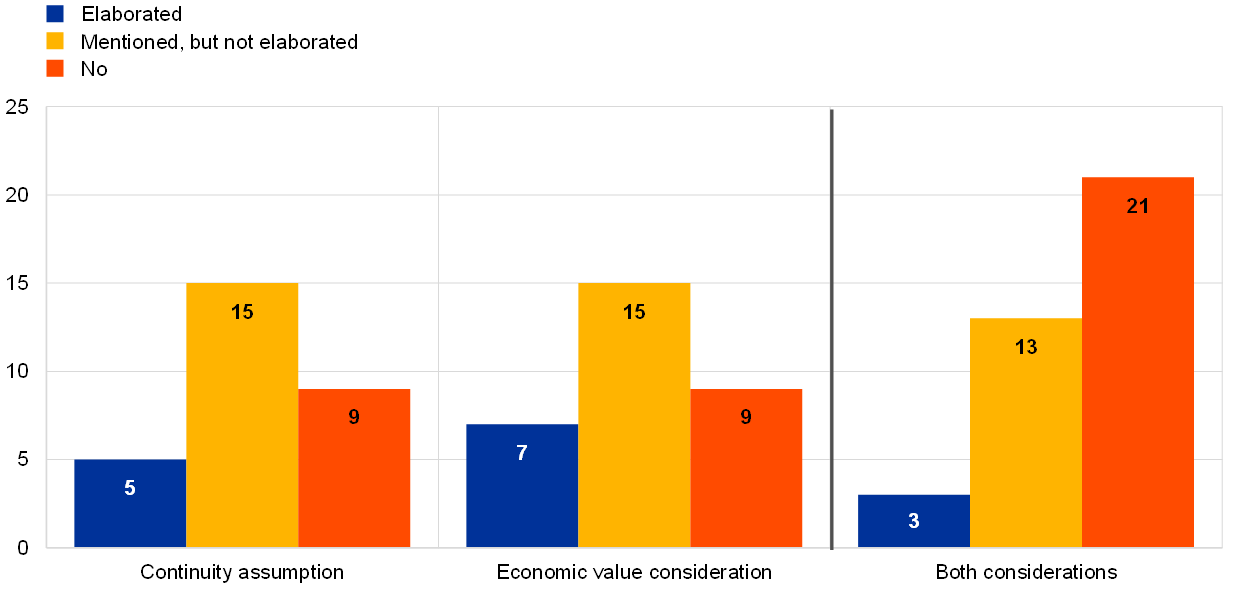
Source: ECB report on banks’ ICAAP practices, Chart 26.
Chart 19
Stress-testing process for identifying new threats to capital adequacy
Does the bank have a process for monitoring and identifying new threats, vulnerabilities and changes in the environment?

Source: ECB report on banks’ ICAAP practices, Chart 43.
Good ICAAP practices are as relevant in a crisis as they are in normal times
Although the above-mentioned analysis was carried out before the outbreak of COVID-19, the ECB believes that good ICAAP practices are as relevant in times of severe stress as they are in normal times. Well-designed ICAAPs are key to effective risk management, financial soundness and long-term sustainability.
The 2020 SREP assessment revealed weaknesses in banks’ stress-testing practices and in capital and liquidity planning
In the context of the 2020 pragmatic approach to the SREP, ECB Banking Supervision identified weaknesses in banks’ ICAAP and ILAAP practices that compromise the reliability of their forward-looking projections and may impair their ability to successfully manage their capital and liquidity positions through the COVID‑19 crisis. Banks are encouraged to rigorously capture the impact of and potential for more severe outcomes from COVID-19-related developments in their baseline and adverse scenarios.
In the future, the ICAAP and ILAAP will play even bigger roles in the SREP
In the future, the ICAAP and ILAAP will play a bigger role in the SREP, which should incentivise banks to keep improving these internal processes. Furthermore, ECB Banking Supervision’s approach to determining P2R will more closely account for risk drivers, which is expected to incentivise banks to better identify the different risks they are exposed to.
1.2.6 IT and cyber risk
In 2020 cybercrime and IT deficiencies were again identified as one of the main drivers of risk to the banking sector. To strengthen banks’ resilience in this field, one of ECB Banking Supervision’s priorities in 2020 was to assess IT and cyber risk to banks by way of supervisory actions such as on-site inspections, the annual SREP, the SSM cyber incident reporting process, and other bank-specific and horizontal activities.
The reliability of IT systems became essential when banks started closing branches and moving to remote working arrangements. In this context, ECB Banking Supervision identified IT and cyber risk as one of the most prominent risks associated with COVID-19. Indeed, the number of significant cyber incidents reported to the ECB by supervised institutions increased in 2020, particularly those with an adversarial intent.[20] So far, these incidents have mostly resulted in service unavailability by banks or by banks’ providers. But the increase in cyber incidents highlights the need for banks to step up their IT resilience and address deficiencies such as overly complex IT architecture and reliance on a high number of end-of-life information and communications technology (ICT) systems to carry out critical business functions.
In June 2020 ECB Banking Supervision published its Annual report on the outcome of the SREP IT Risk Questionnaire (ITRQ)[21], developed in cooperation with the NCAs and based on the ITRQ self-assessment by banks. The report presents key observations about banks’ IT risk practices as of the first quarter of 2019. Banks’ outsourcing budgets continued to increase throughout 2018 and until the beginning of 2019, with cloud services becoming more relevant. Worryingly, the number of end-of-life systems supporting business critical activities also continued to increase, and data quality management remains the least mature risk control domain.
ECB Banking Supervision has also contributed to publications by international working groups on these topics, namely the Financial Stability Board’s effective practices for cyber incident response and recovery[22], the Basel Committee on Banking Supervision’s consultative document on principles for operational resilience[23], and the EBA Guidelines on ICT and security risk management[24], which entered into force in June 2020.
1.2.7 Brexit
ECB Banking Supervision will continue to monitor banks’ implementation of their post-Brexit target operating models
The United Kingdom left the European Union on 1 February 2020, entering a transition period in which EU law continued to apply within and to the United Kingdom. This transition period ended on 31 December 2020. In 2020 ECB Banking Supervision worked to ensure that banks and supervisors were prepared for the end of the Brexit transition period and closely monitored banks’ implementation of their post-Brexit plans.
Throughout the year, ECB Banking Supervision followed the political negotiations between the EU and the United Kingdom and assessed their implications from a supervisory perspective. The ECB also provided technical input to the work of the European supervisory authorities, ensuring that key supervisory issues were taken into consideration.
As part of the ongoing supervision of SIs, ECB Banking Supervision continuously updated its assessment of the impact that a potential no-deal, no-equivalence scenario at the end of the transition period would have on SIs in a number of areas, such as investment services and trading venues. ECB Banking Supervision advised banks to continue preparing for all possible Brexit outcomes, and asked them to implement mitigating measures to address possible cliff-edge risks. Overall, banks’ preparations for the end of the transition period were deemed to be sufficient and no market disruptions in the area of financial services were observed at the beginning of January 2021.
ECB Banking Supervision continued to monitor the implementation of the Brexit plans of SIs affected by the United Kingdom’s departure from the EU to ensure they progressed in line with the time frames previously agreed for implementing their post-Brexit target operating models (TOMs). Horizontal monitoring exercises were complemented by bank-specific follow-ups, and supervisory actions were taken when shortcomings were identified. To fully meet the ECB’s supervisory expectations, some banks will still need to take action in the areas of internal governance, business origination, booking models and funding, repapering of EU clients and intragroup arrangements, as well as IT infrastructure and reporting.
Throughout 2020 ECB Banking Supervision continued to communicate its supervisory expectations related to Brexit in several articles in the Supervision Newsletter, posts on the Supervision Blog and via bilateral discussions with the supervised entities.[25]
Post-Brexit, ECB Banking Supervision will continue to monitor banks’ implementation of their TOMs and focus on key supervisory issues that may arise from the transition to the new regime. Under the new cooperation framework concluded in 2019, ECB Banking Supervision and the UK supervisory authorities will continue to cooperate in supervising banks that are active in both the participating countries and the United Kingdom.
1.2.8 Fintech and digitalisation
Throughout 2020 ECB Banking Supervision continued working on its approach to the supervision of the use of fintech by SIs and LSIs. Work has been conducted to develop a common understanding of fintech-related risks and provide methodological support and tools to supervisors.
ECB Banking Supervision continued to engage with NCAs, SIs and LSIs, and other relevant market participants to deepen the understanding of how banks are using innovative technologies and what the implications are for their business models and risk management frameworks. In this context, it continued monitoring market developments and emerging risks, including the impact of the COVID-19 pandemic on digitalisation and innovation across banks. The pandemic has shown that banks under European banking supervision are able to remain operationally resilient, even as reliance on remote working has increased significantly. Going forward, digital transformation and innovation will remain crucial for banks to navigate a highly competitive environment, given the role digitised systems can play in reducing costs and meeting the expectations of increasingly digitally oriented banking customers.
On 27 August 2020 the ECB published the ESCB/European banking supervision response to the European Commission’s consultation on digital finance, which included detailed answers to questions on the various elements to be addressed in the Commission’s strategy. The ECB broadly supports the priority areas identified by the Commission to foster the development of digital finance in the EU, which gained even more importance after the COVID-19 outbreak. While the ECB recognises that digitalisation and innovation can bring significant benefits for financial institutions, the financial system and the broader economy, the digital transformation of the banking sector must also consider all the related risks. While the pandemic has accelerated the digitalisation efforts of banks and highlighted the importance of investing in innovation, it has also shed light on additional challenges that require further monitoring and must be addressed in banks’ risk appetite frameworks.
The ECB is a member of various international and European groups and networks, to which it contributes its experience and its opinions on the development of the regulatory and supervisory frameworks in the area of fintech and digitalisation. As well as continuing this involvement, in 2020 ECB Banking Supervision also contributed to the ECB’s work on crypto-assets and central bank digital currencies, addressing aspects relevant for banking supervision. It also engaged in internal and external workshops, training courses and seminars to foster a common supervisory approach and keep abreast of the various developments in the field of fintech and digitalisation.
Box 2
Supervisory technology
The rapid increase in the amount of available data and computing power and the fast-paced adoption of new technologies are transforming the global financial landscape more than ever, creating opportunities and challenges for supervisors and supervised entities. The COVID-19 pandemic has intensified this trend, further increasing the speed of digital transformation.
In response to this, in 2019 the ECB created a dedicated hub for supervisory technologies (known as “suptech”). This hub brings internal and external stakeholders together to explore the potential of artificial intelligence and other pioneering supervisory technologies.
SSM Digitalisation Blueprint
The SSM Digitalisation Blueprint, which was jointly shaped by the NCAs and the ECB, provides a long-term vision and concrete action plan on the use of technology and digitalisation in the SSM. The projects identified in the Blueprint are clustered around six areas: (i) improving supervisory reporting and exchange with banks via end-to-end digitalisation; (ii) harnessing the power of data, with advanced analytics and a cutting-edge data architecture; (iii) boosting SSM IT systems by fostering user-orientation, connectedness and suptech integration; (iv) processing documents and unstructured data via AI-driven textual analysis; (v) reducing manual tasks and increasing information control through process automation; and (vi) providing smart collaboration tools for SSM-wide digital exchange.
The Blueprint also defines key enabling factors for unleashing the SSM’s full innovative potential, such as a state-of-the-art innovation management framework; the most agile collaboration modalities for SSM-wide projects; a powerful innovation ecosystem; and initiatives to foster a digital culture, including a digitalisation training programme. The Blueprint also covers aspects related to the ethical and transparent use of new technologies and the compliance of their use with the data protection framework.
SSM-wide bodies driving the Digital Agenda
In 2020 the Steering Committee in its Digital Agenda composition (SCDA) was set up from among Supervisory Board members to facilitate the discussion on digital strategic matters. In parallel, the SuperVision Innovators Forum, gathering together supervisors and IT experts from NCAs and the ECB, was established. The Forum played a key role in the identification of supervisory needs and concrete applications of new technologies for banking supervision. The Suptech Hub further established new ways of working by bringing together ECB and NCA staff with multidisciplinary backgrounds (e.g. IT, supervision, data science) to form agile innovation teams. The first four of such teams were set up in September 2020 and up to ten additional teams are planned for 2021.
Large-scale awareness-raising events
As part of the Blueprint objective of fostering a digital culture, a series of large-scale events took place in 2020. The Suptech Virtual Meet-Up and the Supervision Innovators Conference, held in June and November respectively, brought together supervision innovators from around the world to foster collaboration and present cutting-edge developments in artificial intelligence tools.
New suptech tools
In 2020 the ECB made significant progress in developing a machine reading tool for fit and proper questionnaires and network analytics for private equity ownership in supervised entities. New suptech tools continue to be explored. These include a prototype of a speech-to-text tool to provide automatic transcripts based on voice recognition and an automated topic modelling and sentiment analysis tool to allow analysis of qualitative data and news. New technologies such as natural language processing and machine learning will be used to revolutionise the analysis of text and unstructured data in many supervisory tasks from on-site missions to horizontal functions. Furthermore, one of the flagship suptech projects, the virtual lab, will provide a modular platform for digital collaboration and exchange within the SSM, allowing, for instance, for code and model sharing.
1.3 Direct supervision of significant institutions
1.3.1 Off-site supervision
ECB Banking Supervision strives to supervise SIs in a proportionate and risk-based manner that is both demanding and consistent. To that end, it defines a set of core ongoing supervisory activities for each year. These activities draw on the existing regulatory requirements, the SSM Supervisory Manual and the SSM supervisory priorities, and are included in the ongoing supervisory examination programme (SEP) for each SI.
In addition to these centrally defined core activities, other supervisory activities that are tailored to banks’ specificities can be included in the SEP, leaving room for JSTs to analyse and address idiosyncratic risks.
The off-site SEP activities include (i) risk-related activities (e.g. the SREP), (ii) other activities related to organisational, administrative or legal requirements (e.g. the annual assessment of significance), and (iii) additional activities planned by JSTs to further tailor the ongoing SEP to the specificities of the supervised group or entity (e.g. analyses of the bank’s business model or governance structure). While the first two sets of activities are defined centrally, the third is bank-specific and defined by the respective JST.
Being proportionate
Planned supervisory activities in 2020 followed the principle of proportionality, tailoring the intensity of supervision to the systemic importance and risk profile of the supervised bank
The SEP follows the principle of proportionality, i.e. the intensity of the supervision depends on the size, systemic importance and complexity of each institution. In 2020 the average number of planned supervisory activities per SI was rather similar to the previous year (Chart 20), ensuring that JSTs continued to have sufficient leeway to address institution-specific risks.
Chart 20
Average number of planned tasks per SI in 2019 and 2020
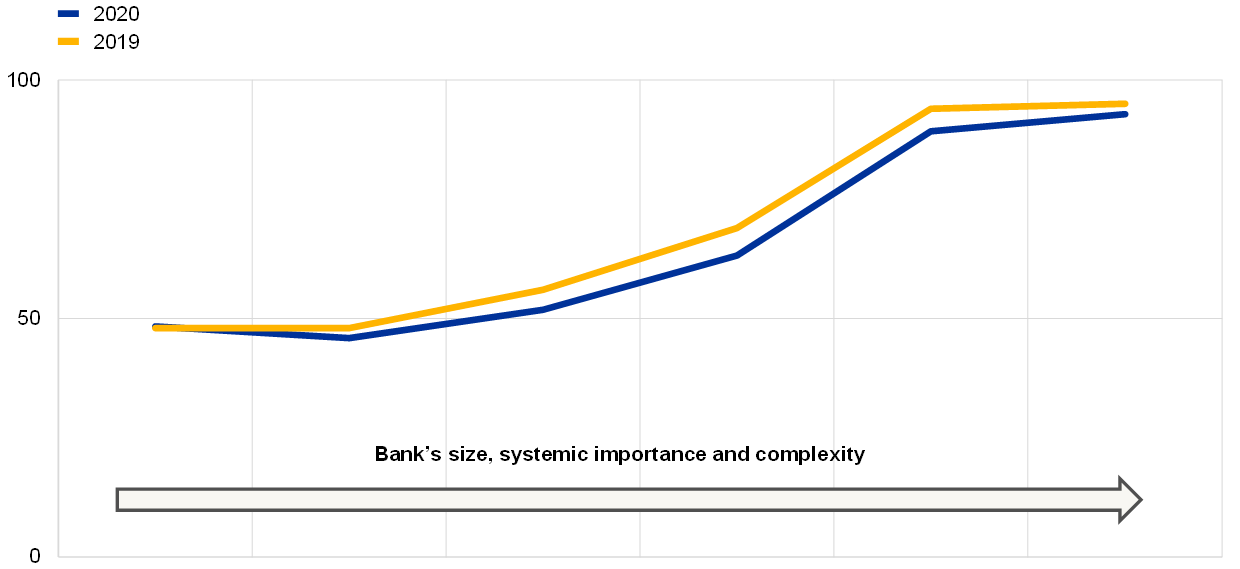
Source: ECB.
Note: Data extracted as at 31 December.
Taking a risk-based approach
The SEP takes a risk-based approach, focusing on the most relevant risk categories for each SI. For example, the percentage of tasks related to credit risk is greater for high-NPL banks than it is for the average bank, and the percentage of tasks relating to market risk is higher for banks with large exposures to market and trading activities than it is for the average bank (Chart 21).
Chart 21
SEP activities in 2019 and 2020: credit and market risk activities as a share of all activities
Credit risk
(percentages)
Market risk
(percentages)
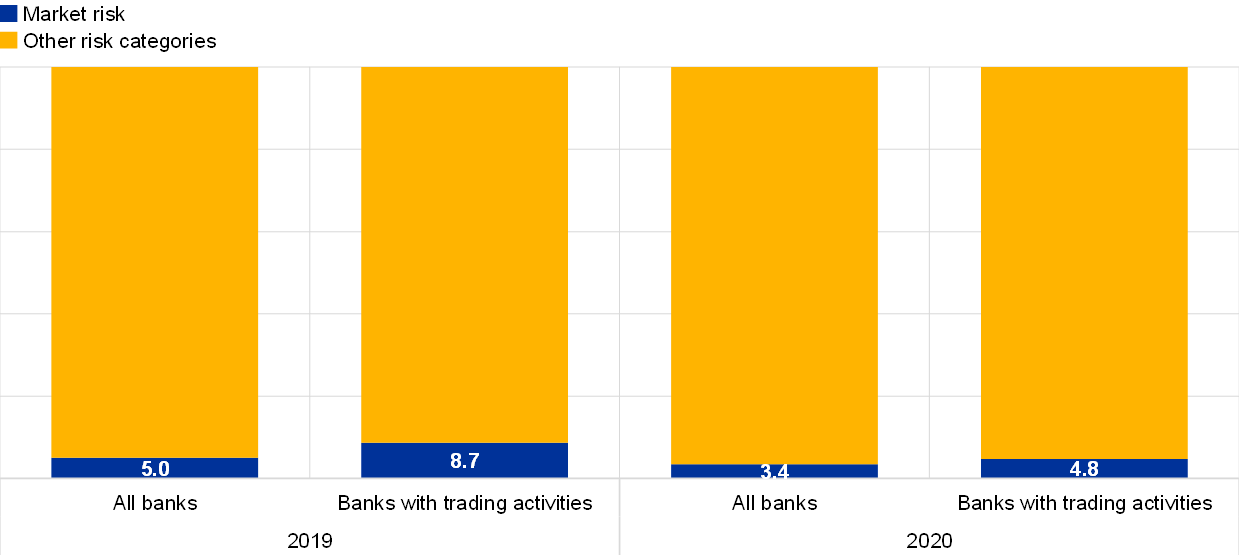
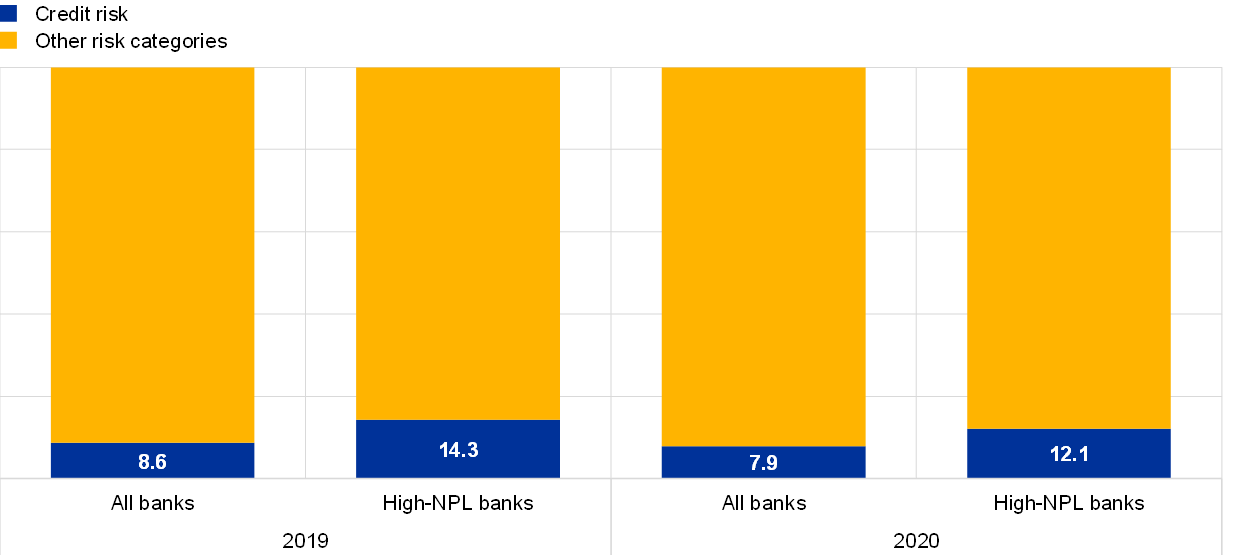
Source: ECB.
Notes: Only planned activities related to risk categories were considered. Data extracted as at 31 December.
Highlights of off-site supervision in 2020
As a result of the COVID-19 pandemic, ECB Banking Supervision reviewed its supervisory processes and activities to provide banks with sufficient operational relief and ensure that JSTs could adequately focus on monitoring the banks’ ability to deal with the crisis.
The planned set of off-site activities for 2020 was thus reviewed, with activities cancelled, simplified or postponed. Key changes included (i) the postponement of the 2020 EU-wide stress test exercise to 2021 and its replacement with a desktop-based vulnerability analysis aiming to assess particular risks stemming from the COVID-19 crisis; (ii) the adoption of a pragmatic approach for the SREP (see Section 1.2); (iii) the introduction of a process for monitoring the impact of COVID‑19 on banks’ risk profiles (entailing more interaction with banks); and (iv) the extension by six months of the deadlines for all supervisory measures whose deadlines had not yet expired.
These efforts – together with the actions undertaken by JSTs on bank-specific measures and the shift of focus towards banks’ ability to cope with the crisis –resulted in a slightly reduced number of activities performed with respect to what was originally planned at the beginning of 2020 (Chart 22).
Chart 22
Average number of tasks per SI in 2020
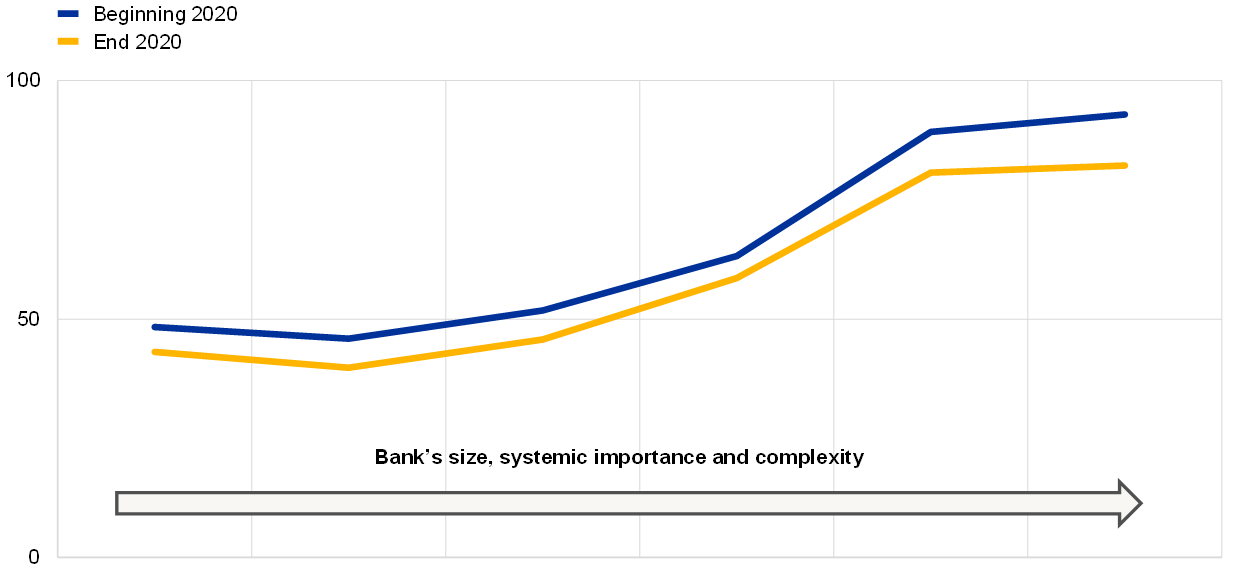
Source: ECB.
Note: Data extracted as at 31 December.
Supervisory findings
“Supervisory findings” are one of the main outcomes of the regular supervisory activities and reflect shortcomings that need to be remedied by banks. The JSTs are responsible for monitoring how banks follow up on these findings. As of 31 December 2020, the overall number of registered findings fell by comparison with previous years, mainly owing to the reduction of on-site inspections and internal model investigations linked to the COVID-19 crisis. The majority of the findings originated from on-site inspections, internal model investigations and activities related to authorisations. The largest number of findings were made in the area of credit risk (Chart 23).
Chart 23
Supervisory findings
Number of findings year-on-year
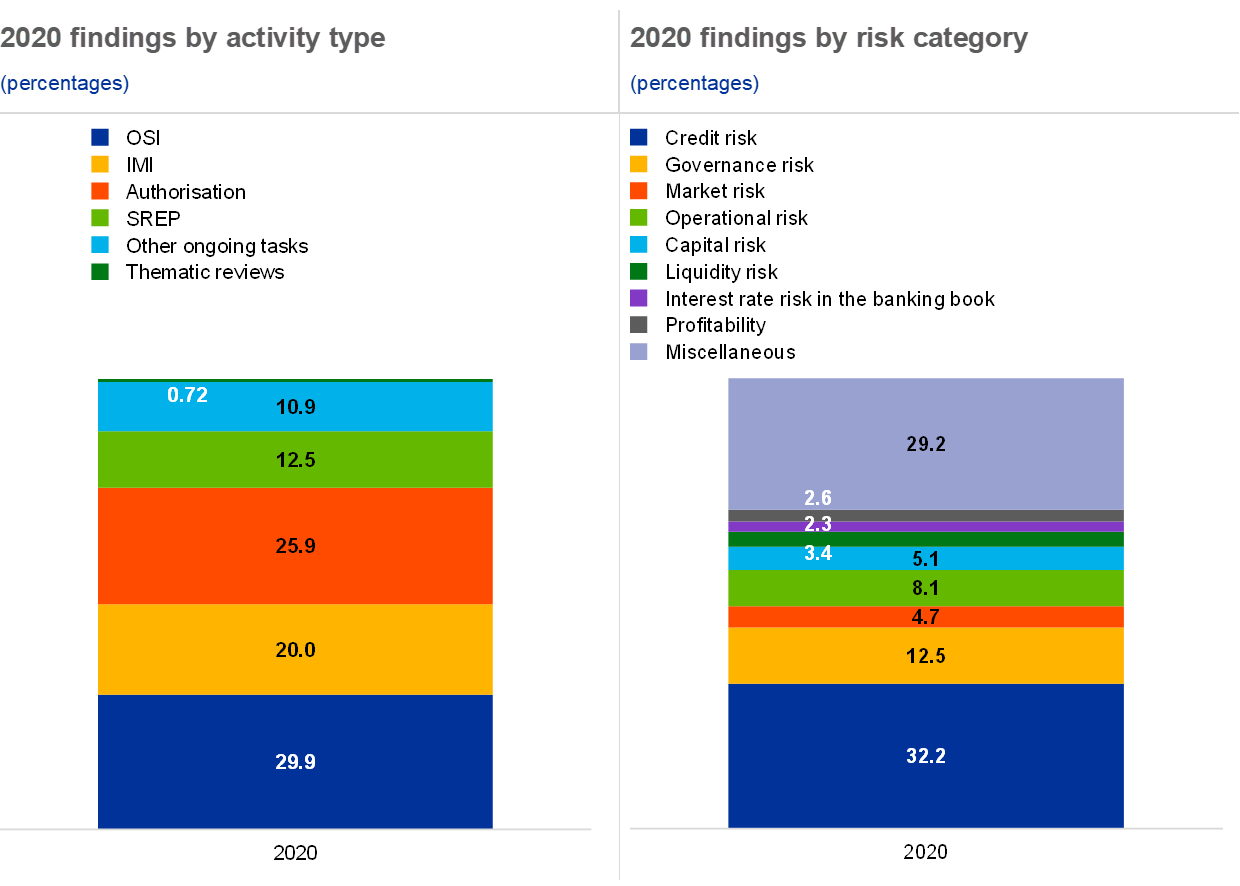
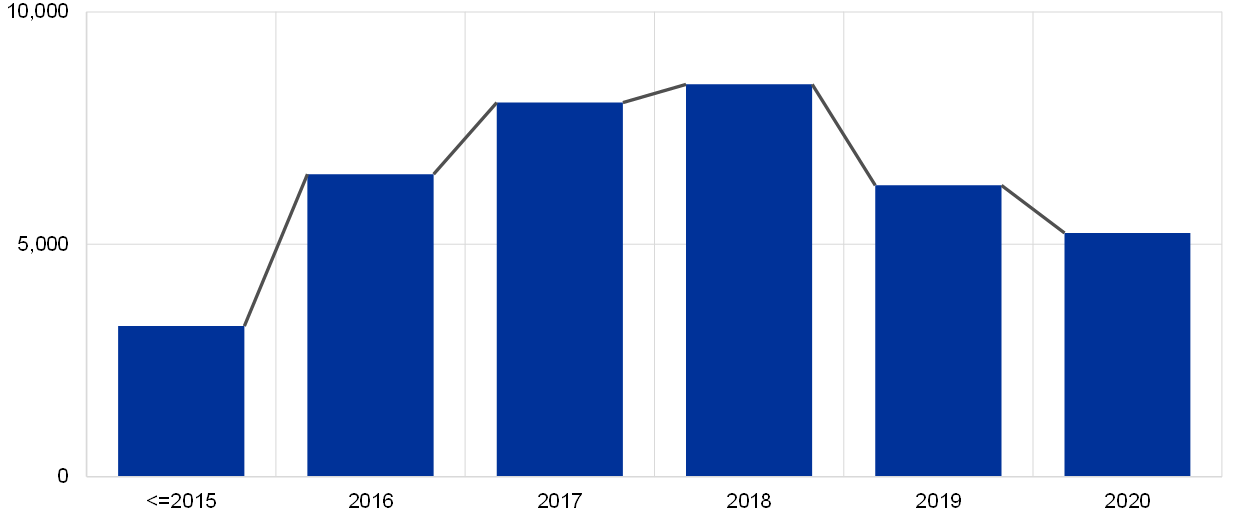
Source: ECB.
Note: 58 findings from old JSTs have been excluded.
1.3.2 On-site supervision
As part of the changes to the organisational structure of the ECB announced in July 2020, a structurally independent on-site supervision function was created: the Directorate General On-site and Internal Model Inspections (DG/OMI). Its responsibilities are described in Section 5.1 – Organisational set-up of ECB Banking Supervision.
A safe, reactive and proportionate approach to on-site supervision has been deployed in response to COVID-19
The travel restrictions implemented in response to the COVID-19 pandemic significantly affected on-site inspections (OSIs) and internal model investigations (IMIs) in 2020. In March 2020 the Executive Board of the ECB decided to suspend all business travel and all OSIs and IMIs that were in a preparatory phase. OSIs and IMIs that were in an investigation phase were resumed off-site when possible, while those that were in the final reporting phase were finalised as foreseen.
The temporary concept of “off-site investigations” was implemented to assess risks remotely
To maintain appropriate supervisory scrutiny, ECB Banking Supervision developed a temporary concept of “off-site investigations” to remotely investigate the most prominent risks raised by the COVID-19 crisis, for example by conducting remote interviews with banks and using remote collaborative tools. The aim is to return to traditional on-site practices when the health situation improves. Nevertheless, useful lessons can be drawn from the experience of off-site inspections and these will feed into ECB Banking Supervision’s future on-site supervisory methodology.
The JSTs reprioritised the OSIs and IMIs initially scheduled for 2020 based on their assessment of banks’ most prominent risks in the COVID-19 context, as well as on banks’ own capacity to support investigations. As a result, the 2020 programme consisted of 96 OSIs and 83 IMIs, the majority of which had to be performed off-site due to the safety requirements related to the COVID-19 pandemic.
A total of 168 supervisory decisions on IMIs[26] were issued in 2020.
Chart 24
Decrease in investigations in 2020 owing to COVID-19
(number of investigations)

Source: ECB Banking Supervision.
The 2020 training programme for SSM staff involved in OSIs was mostly conducted remotely and consisted of 15 training sessions covering all major SREP risk types and processes relevant for inspections. The online delivery of the courses allowed for a higher number of participants, with more than 586 inspectors and supervisors benefiting from this programme.
1.3.2.1 Key findings from OSIs
The following analysis provides an overview of the most critical findings identified in OSIs.[27]
Internal governance
The most critical findings revealed deficiencies in the following governance areas:
- Internal control functions (including compliance, risk management and internal audit): severe shortcomings in independence, resources and the scope of activity of all internal control functions.
- Corporate structure and organisation: lack of transparency in the organisational structure of banks owing to inadequate allocation of responsibilities and unclear reporting lines, deficiencies in internal control frameworks and inadequate human and technical resources.
- Implementation and oversight of governance processes: insufficient oversight by the management body over the implementation of banks’ business and risk strategies.
- Risk data aggregation and risk reporting: insufficiently comprehensive risk data aggregation and risk reporting framework, weaknesses in data architecture and IT infrastructure.
Credit risk
Around half of the credit risk inspections targeted the quality of banks’ assets and were conducted by reviewing credit files. This revealed additional provisioning needs from the prudential perspective of more than €2.3 billion and reclassifications from performing to non-performing status amounting to around €3.1 billion.[28] The remaining inspections focused on the qualitative aspects of the credit risk management process. The most critical findings included:
- Underestimation of expected credit losses (ECL): overvaluation of collateral and cure rates, inappropriate ECL calculation due to shortcomings in applied methodology and provisioning parameters.
- Inappropriate classification of debtors: shortcomings in defining or identifying defaulted or non-performing exposures, underestimation of gross exposures in stages 2 and 3, and deficiencies in the processes for identifying forbearance.
- Weak monitoring processes: shortcomings in identifying early signs of credit deterioration and inadequate rating systems, often driven by low data quality and data inconsistencies between different IT systems and by over-reliance on manual adjustments.
IT risk
The majority of high-severity findings revealed deficiencies in:
- IT continuity management: inadequacy of IT continuity; ineffective or substandard IT continuity plans.
- Cybersecurity management: inability of cybersecurity measures to ensure the confidentiality, integrity and availability of critical data and the timely detection of cybersecurity incidents.
- IT risk management: insufficient integration of IT risk into the overall risk management framework.
Regulatory capital and ICAAP
The main findings on regulatory capital (Pillar 1) concerned deficiencies of the control framework in identifying the incorrect use of risk weights for exposures for all Pillar 1 risks, and the underestimation of RWAs as a result of the incorrect allocation of exposure classes. Other findings relate to a failure to identify speculative immovable property financing and to the use of ineligible collateral for credit risk mitigation techniques.
The most severe issues identified in ICAAP inspections relate to (i) internal quantification weaknesses, mainly for participation risk, pension risk, market and credit risk modelling; (ii) the absence of robust multi-year and forward-looking capital planning; and (iii) inconsistent interlinks between strategic planning processes and the risk appetite framework, mainly due to the inexistence of consistent and granular risk appetite limits.
Market risk
The most severe findings concerned the measurement and management of valuation risk, including material shortcomings in fair value measurement (insufficient independent price verification coverage, inadequate fair value hierarchy methodologies, inappropriate day one profit recognition practices, missing fair value adjustments), and in the implementation of the EBA’s Regulatory Technical Standards on prudent valuation.
Interest rate risk in the banking book (IRRBB)
The majority of critical findings concerned the measurement, management and monitoring of IRRBB: inadequacy of the quantification methods, use of assumptions and parameters that are not adequately justified or robust, lack of solid grounds for the modelling of non-maturing deposits and absence of regular validation of IRRBB models.
Liquidity risk
The majority of high-severity findings were related to weaknesses in the stress-testing framework (stress test scenario framework insufficiently conservative, deficiencies in the setting of assumptions and parameters used to quantify stress-testing impacts) and in risk measurement and monitoring (deficiencies in the estimation of the run-off profile of financial products and errors in the calculation of the LCR).
Operational risk
The most severe findings were related to the management of operational risks (deficiencies in the operational risk data collection process, inadequate risk prevention and remediation actions when dealing with operational risk events), and their identification (incomplete coverage and definition of significant operational risks).
Business models and profitability
The most critical findings related to deficiencies in product pricing (failure to include relevant costs and risks in pricing tools, pricing rates unable to generate sustainable profitability), strategic steering capabilities (insufficient management control activities in terms of implementing business strategy) and allocation of income, costs and capital (deficiencies in profit, cost and capital allocation leading to a distorted view of profitability).
1.4 Indirect supervision of LSIs
Following the outbreak of the COVID-19 pandemic, the ECB intensified and refocused its LSI oversight activities in order to address mounting risks proactively. At the same time, the ECB and the NCAs agreed to apply some flexibility in the implementation of certain activities initially planned in 2020.
Intensified and refocused LSI oversight activities to address risks stemming from the COVID-19 crisis
Assessing LSIs’ vulnerabilities to the current crisis
The ECB intensified its cooperation with the NCAs throughout the year, at both the technical and managerial level, in order to proactively address the risks stemming from the COVID-19 crisis. In particular, the ECB assessed the credit and liquidity risk vulnerabilities at LSIs that could be driven by a worsening of the economic situation. This assessment covered the concentration of LSIs’ exposures to economic sectors more exposed to the consequences of the pandemic (e.g. transport, accommodation, etc.) as well as possible vulnerabilities at LSIs to sudden liquidity needs or shocks to funding sources. In terms of asset quality, the analysis showed that banks exposed to less vulnerable sectors may also be challenged by the fallout from COVID-19, especially if they entered the crisis with high levels of NPLs. In terms of liquidity, a large number of small and medium-sized LSIs remain exposed to liquidity risks. For example, many banks have very high levels of committed credit lines relative to their available high-quality liquid assets, making them vulnerable in the event of a corporate rush for liquidity similar to the one seen during the first phase of the COVID-19 crisis. Another liquidity issue concerns LSIs that rely heavily – or excessively, in some cases – on wholesale funding. This reliance could leave them exposed to volatility in wholesale markets.
In addition, the ECB provided assistance to NCAs to foster a consistent application of several supervisory approaches across the SSM, such as the implementation of the EBA Guidelines on the pragmatic 2020 supervisory review and evaluation process (SREP) in light of the COVID‐19 crisis[29], the EBA Guidelines on legislative and non-legislative moratoria on loan repayments applied in the light of the COVID‑19 crisis[30] and the assessment of significant risk transfer for securitisation transactions with respect to the implementation of public guarantee schemes.
The ECB refined its LSI early warning system, the purpose of which is to identify vulnerable LSIs and support dialogue with the NCAs, by incorporating information on capital and large exposure breaches.
The ECB continued its work on institutional protection schemes
The ECB continued its work on institutional protection schemes (IPS) in 2020. In this context, the ECB supported Banca d’Italia in its assessment of an LSI-only IPS consisting of Raiffeisen banks located in the Trentino-Alto Adige region. The IPS has been recognised for prudential purposes since 4 November 2020. The ECB also conducted further monitoring activities for hybrid IPSs which are partially undergoing considerable changes.
Flexibility to adjust LSI supervisory priorities to the crisis situation
The finalisation of the implementation of the LSI SREP methodology has been postponed to 2021
In 2020 the ECB and the NCAs agreed to postpone to 2021 the roll-out of the new LSI SREP methodology.[31] In those cases where the NCAs decided to apply the methodology to these LSIs in 2020 in line with initial plans, the ECB endorsed the use of a pragmatic approach to SREP in line with the "EBA Guidelines on the pragmatic 2020 SREP in light of the COVID-19 crisis", covering only the assessment of material risks and leaving applicable P2R and P2G broadly unchanged. The LSI SREP roadmap was also adjusted, with some topics being deprioritised.
The COVID-19 crisis has exemplified reliance on IT systems (e.g. remote connections, use of digital channels by banking customers) which involve heightened risks for the bank (system unavailability, increased times of response, lower reactivity of IT support, etc.). For that reason, in 2020 the ECB recommended that NCAs pay due attention to ICT risk and how LSIs are dealing with the current crisis on an operational/IT-related level.
Throughout 2020 the ECB continued preparations for a plan for the gradual roll-out of its information management system with regard to the SREP functionalities, which will allow the NCAs to record the SREP assessment for LSIs in a single system across the SSM going forward.
Owing to the pandemic the use of videoconferences became a meaningful tool for efficient exchange of information with the NCAs.
Other relevant topics for LSI supervision
In 2020 the ECB continued its work on identification of small and non-complex institutions. A stocktake was conducted together with the NCAs to enable the mapping of the new classification across the SSM. The mapping exercise was also indirectly supported by the lists of small and non-complex institutions provided by NCAs in the context of the new FINREP templates on NPLs.
Following the set-up of the EBA Advisory Committee on Proportionality (ACP), the ECB contributed to the first Recommendation letter from the Committee to the EBA Board of Supervisors on how proportionality could be better taken into account by the EBA in five selected topics of its draft work programme for 2021. The Recommendation covered the SREP, internal governance, investment firms, climate-related disclosures and the cost of compliance study. The ECB is currently supporting the EBA in the development of the ACP’s impact assessment methodology.
1.5 Macroprudential tasks of the ECB
Over 100 macroprudential notifications were received from national authorities in 2020
The ECB continued to engage actively with the national authorities in 2020, in accordance with the macroprudential tasks conferred on it under Article 5 of the SSM Regulation[32].
In 2020 the ECB received over 100 macroprudential policy notifications from national authorities, including from Bulgaria and Croatia, following the establishment of close cooperation with these countries. Most of these notifications concerned quarterly decisions on setting countercyclical capital buffers (CCyB) and decisions on the identification and capital treatment of global systemically important institutions (G‑SIIs) or other systemically important institutions (O-SIIs). Some decisions, in particular on setting the CCyB, concerned the freeing up of capital to facilitate the absorption of credit losses and support lending to the economy during the COVID-19 pandemic. Finally, the ECB assessed notifications on other macroprudential measures, for example on the setting of systemic risk buffers or measures introduced under Article 458 of the CRR.
Following the methodology developed by the Basel Committee on Banking Supervision, the ECB and national authorities identified eight euro area G-SIIs[33] that will be required to hold additional capital buffers ranging from 1.0% to 1.5% in 2022. National authorities identified and set capital buffer rates for 124 O-SIIs. These rates were in line with the floor methodology for setting the O-SII capital buffers, which the ECB has followed since 2016.[34]
ECB Banking Supervision also participated actively in several areas of the work of the European Systemic Risk Board (ESRB), which is responsible for the macroprudential oversight of the financial system in the EU. This included the ESRB’s work on restrictions of distributions. On 27 May 2020 the ESRB adopted Recommendation ESRB/2020/7, which called on the relevant authorities to request the financial institutions under their supervisory remit to refrain from paying dividends, buying back ordinary shares or creating obligations to pay variable remuneration to material risk takers until 1 January 2021.[35]
This Recommendation was reviewed and amended in December 2020. As a result of close cooperation between the ESRB and the ECB, the ECB ensured that its own stance on distributions remained fully consistent with the ESRB Recommendation.
1.6 Looking ahead: risks and supervisory priorities for 2021
The risk assessment provides a timely picture of existing and emerging risks and vulnerabilities and helps identify supervisory priorities
To fulfil its supervisory mandate effectively ECB Banking Supervision identifies, assesses and monitors existing and emerging risks and vulnerabilities to the banking sector on an ongoing basis. This allows it to tailor and prioritise its actions and to swiftly shift the supervisory programme and resources to address emerging threats to supervised institutions. In 2020 ECB Banking Supervision had to shift its supervisory focus in response to the extraordinary economic shock resulting from the COVID-19 pandemic, which in turn significantly changed the overall risk landscape of the banking sector. Looking ahead, significant uncertainties remain in the short to medium term given the resurgence of COVID-19 infections at the beginning of 2021. These include the possibility of more episodic lockdowns dampening financial activities as well as the unclear timing for vaccinating the population and, hence, returning to usual economic activity.
The SSM Risk Map for 2021, together with the table of vulnerabilities (Chart 25), provides an overview of the main challenges for the banking sector over the next two to three years, as assessed by ECB Banking Supervision in close cooperation with the NCAs. The SSM Risk Map depicts the most relevant risk drivers, which can affect supervised institutions via existing internal and external vulnerabilities, for example, characteristics of the banking system or the environment in which banks operate. In the context of the current risk picture, the vulnerabilities identified define the focus areas for supervision in 2021.
The high level of uncertainty about the macroeconomic outlook triggered by the COVID-19 pandemic shapes the risk picture for banks
The outbreak of the COVID-19 pandemic and the related containment measures triggered an unprecedented drop in economic activity in the euro area in 2020, with real GDP projected to return only gradually to its pre-pandemic level by mid-2022.[36] The speed of this recovery will depend on the evolution of the pandemic, the duration of containment measures, the potential phase-out of policy support measures as well as the successful implementation and distribution of effective medical solutions. The potential re-emergence of geopolitical tensions related primarily to trade conflicts is one of the most prominent additional downside risks to the economic recovery. Such geopolitical tensions might further result in an abrupt reassessment of risk premia and renewed repricing on the financial markets. The impact of the end of the Brexit transition period on the euro area economy is expected to be contained, and also relatively limited for the banking sector as a result of the preparations made by affected banks, although some are still expected to intensify their efforts in this regard (see Section 1.2.7).
Chart 25
SSM Risk Map and table of vulnerabilities for 2021
The risk picture shaped by the COVID-19 pandemic and the high uncertainty about the macroeconomic outlook…
… will affect banks on account of existing vulnerabilities requiring supervisory action
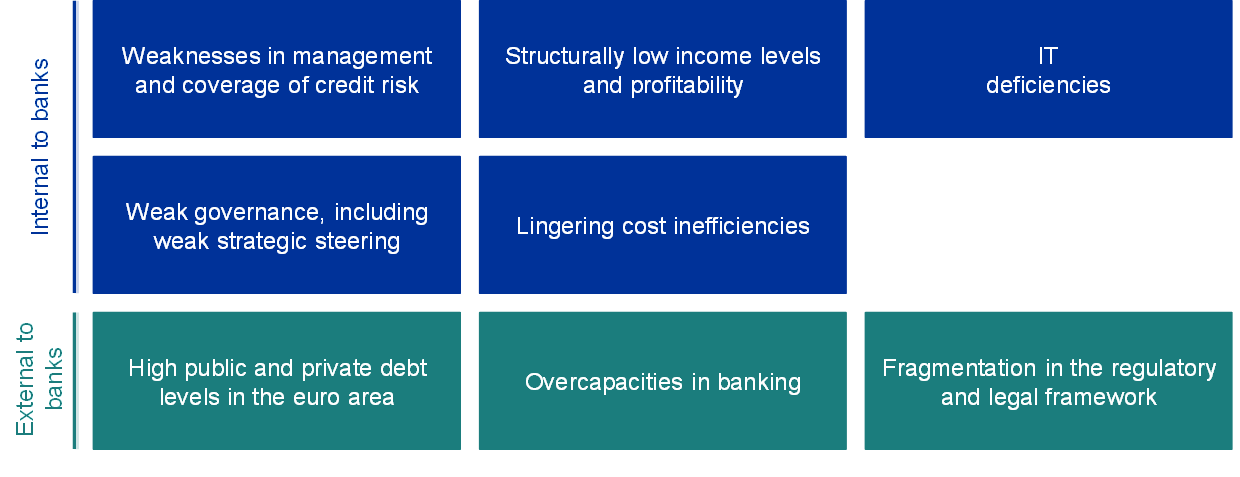

Sources: ECB and NCAs.
Notes: Risk drivers and vulnerabilities should not be seen in isolation, as they may trigger or reinforce each other. In the risk map, dots with a white fill denote risk drivers that are expected to increase significantly over the next five years. “ML/TF” refers to money laundering and terrorist financing; “NPLs” refers to non-performing loans. In the table of vulnerabilities, “internal vulnerabilities” are those that can be addressed by banks themselves, while “external vulnerabilities” refer to the environment in which banks operate.
Deteriorating asset quality is a key risk to the banking sector and might challenge banks’ capital strength
Credit risk is one of the most immediate challenges for the European banking sector. A weaker economic environment is expected to result in a deterioration in asset quality, in particular when government support schemes are ultimately withdrawn. NFCs in many sectors face a heightened solvency risk owing to a sharp deterioration in profits, accelerated in some sectors as a result of changed customer behaviours, while households’ debt servicing capacity might be challenged by a potential worsening of the labour market. Elevated private debt levels carry the risk of an increased negative impact on banks as corporates with higher levels of debt can be rendered less viable even when the economic environment begins to normalise. Risks of correction in commercial and residential real estate markets are increasing as real estate prices continue to show signs of overvaluation. Furthermore, significant increases in banks’ exposures to domestic government debt have the potential to re-activate adverse sovereign-bank feedback loops in some countries should public debt sustainability concerns emerge over the medium term.
Going forward, the potential worsening of asset quality poses a challenge to banks’ capital adequacy. Against this background, banks need to have sound risk strategies in place, specifically structured to strengthen credit risk management practices. Effective risk monitoring, sound identification of credit quality deterioration (forbearance flagging and unlikely-to-pay assessments), transparent and accurate management of distressed assets and, last but not least, adequate and timely coverage of risk through provisioning are all hallmarks of a sound risk strategy.
The current crisis further challenges the sustainability of banks’ business models
The profitability of supervised institutions is projected to rebound only moderately in 2021, to a level that is still low and accompanied by a bleak earnings outlook. Moreover, the effect of the pandemic is likely to lead to the need for increased provisioning, which in turn will weigh further on structurally low profitability in the banking sector. Pressure to address existing vulnerabilities such as overcapacity in the banking sector and lingering cost inefficiencies is likely to intensify. However, consolidation in the banking sector may help address such structural issues and support banks’ business model sustainability. Increasing competition from non-banks and the market shift toward greater digitalisation bring opportunity, but also heighten risks arising from IT system deficiencies, cybercrime and operational disruptions in the banking sector.
The COVID-19 pandemic has highlighted a number of pre-existing vulnerabilities in banks’ governance frameworks
Strong internal governance and strategic steering are crucial for banks to adequately address the challenges stemming from the ongoing crisis. Difficulties identified previously in banks’ risk data aggregation and risk monitoring capabilities are among the key issues to be tackled going forward. Furthermore, a certain number of banks exhibit the need for a better integration of risk appetite frameworks into risk management practices and decision-making processes, and insufficient oversight by management bodies in their supervisory function. Weak governance and poor risk controls also have the effect of exacerbating money laundering and terrorist financing risks to banks.
Further focus areas: fragmentation in the regulatory framework and increasing climate-related risks
Harmonising the EU regulatory framework and completing the banking union are crucial for increasing the efficiency and resilience of the EU banking sector. Those two elements would contribute to eliminating impediments to cross-border activity and remove barriers to consolidation among banks. The impact of climate-related risk is becoming more and more tangible and supervisors are stressing de facto the need to accelerate the development of active risk management and disclosure of these risks[37] (see Box 3).
Supervisory priorities for 2021 will focus on four key areas materially affected by the COVID-19 crisis
Against this background, the supervisory priorities for 2021 focus on four key areas materially affected by the current COVID-19 crisis:
- ECB Banking Supervision will prioritise its actions towards the assessment of the adequacy of banks’ credit risk management, operations, monitoring and reporting practices. Particular emphasis will be placed on banks’ ability to identify asset quality deterioration at an early stage, book accordingly adequate and timely provisions and take the necessary actions towards arrears and NPL management.
- Moreover, it is essential that banks have in place sound capital planning practices, based on capital projections which adapt to a dynamically changing environment, particularly in a crisis situation such as the current pandemic. In addition, the EU-wide stress test coordinated by the EBA will be conducted in 2021 and will be an important element in gauging banks’ capital strength.
- Banks’ profitability and business model sustainability remain under pressure from the economic environment, low interest rates, excess capacity, low cost efficiency, and competition from banks and non-banks. The COVID-19 pandemic is exacerbating these pressures. In 2021, ECB Banking Supervision will continue its efforts to challenge banks’ strategic plans and the underlying measures taken by banks’ senior management to overcome existing shortcomings.
- Supervisory focus will remain on governance and particularly on banks’ risk data aggregation capabilities and information systems, as well as on how well they manage crisis risk. ECB Banking Supervision will continue to assess banks’ internal controls, also with a view to mitigating money laundering and terrorism financing risks (see Box 5).
Further structural activities going beyond the impacts of the COVID-19 pandemic will be carried out in 2021, especially related to banks’ alignment with the expectations stipulated in the ECB Guide on climate-related and environmental risks (See Box 3) and their preparedness for implementing the finalised Basel III reform package. Depending on how the crisis develops, ECB Banking Supervision may further reprioritise its activities.
Table 1
Vulnerabilities in the banking sector and SSM supervisory priorities for 2021
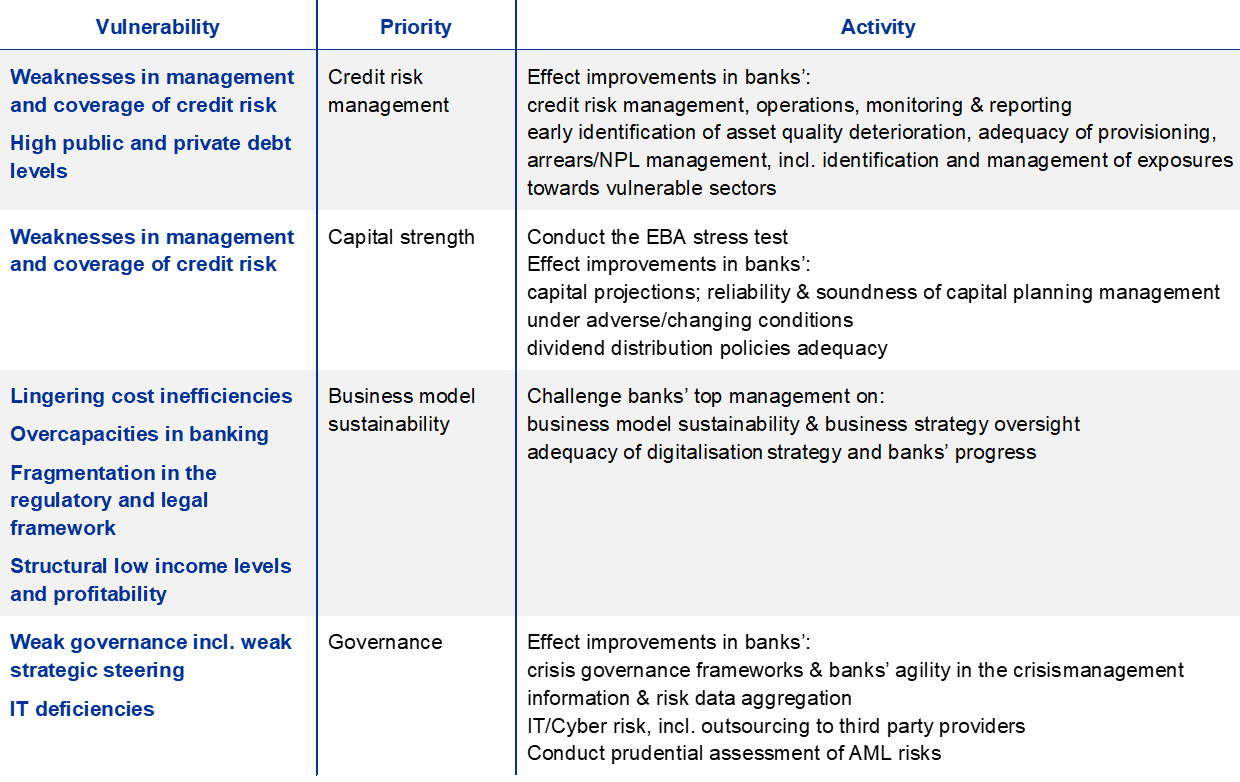
Source: ECB.
Box 3
Public consultation on ECB Guide on climate-related and environmental risks
Climate-related and environmental risks are likely to have a substantial impact on the real economy and on banks.[38] The risks are twofold. “Physical risks” arise from extreme weather events and gradual changes in the climate as well as environmental degradation. “Transition risks” arise from the process of adjusting to a lower carbon and more sustainable economy.[39] As such, the risks are drivers of existing categories of risk.
In this context, in 2020 the ECB published, following a public consultation, its “Guide on climate-related and environmental risks”. During the consultation, the ECB received 49 responses from a broad range of stakeholders, not only from within the banking industry, but also academics and NGOs.
The Guide outlines the ECB’s understanding of the safe and prudent management of climate-related and environmental risks under the current prudential framework. It also outlines how the ECB expects banks to enhance their climate-related and environmental disclosures.
The ECB expects banks to take a strategic, forward-looking and comprehensive approach to considering climate-related and environmental risks, assess whether their current practices are safe and prudent in the light of the expectations and, if necessary, to start adapting them. As regards LSIs, the ECB Guide recommends that the NCAs apply the ECB Guide proportionately.
In 2020 the ECB published its “Report on institutions’ climate-related and environmental risk disclosures”, providing a snapshot of the level of disclosure of these risks in view of the supervisory expectations set out in the ECB Guide, and its “Report on banks’ ICAAP practices”, highlighting areas such as climate-related risks where banks need to further develop their approaches.[40]
As part of the supervisory dialogue, in the first half of 2021 the ECB will ask banks to assess their practices against the supervisory expectations set out in the Guide and to draw up action plans on that basis.
In 2022 the ECB will conduct a fully-fledged supervisory assessment of all the banks directly supervised and take concrete follow-up measures where needed. Moreover, the supervisory stress test in 2022 will focus on climate-related risks.
The ECB is closely following the developments that are likely to affect the banks it supervises and continues to be involved in international fora, including, inter alia, the EBA, the Network of Central Banks and Supervisors for Greening the Financial System and the Basel Committee on Banking Supervision.
2 Authorisations, enforcement and sanctions
2.1 Authorisations
2.1.1 Annual significance assessment
The ECB directly supervises 115 banks from 1 January 2021 following the annual review of significance and ad hoc assessments
The annual assessment, in line with the SSM Framework Regulation[41], of whether a bank or banking group fulfils any of the significance criteria[42] was concluded in November 2020. It was supplemented by ad hoc significance assessments that were carried out following the establishment of close cooperation between the ECB and Българска народна банка (Bulgarian National Bank) and Hrvatska narodna banka, changes in group structures and other developments in banking groups. In addition, a methodological change was introduced to avoid double-counting. Now, entities that are among the three largest credit institutions in a member state and are also subsidiaries of significant institutions (SIs) are only counted once.
As a result, 115 institutions[43] were classified as significant as of 30 November 2020, down from 117 in the previous assessment of significance[44].
In 2020 five banking groups were added to the list of supervised entities.
- As a result of the annual significance assessment, two new banking groups were classified as significant: LP Group B.V., established in the Netherlands, was classified as significant because its assets exceed €30 billion and Agri Europe Cyprus Limited was classified as significant after one of the banks within the group, Gorenjska Banka d.d., Kranj, became the third largest credit institution in Slovenia. Both banking groups have been directly supervised by the ECB since 1 January 2021.
- One bank, AS “Citadele banka”, was classified as significant after it became the third largest credit institution in Latvia. It has been directly supervised by the ECB since 1 January 2021.
- Following the establishment of close cooperation between the ECB, the Bulgarian National Bank and Hrvatska narodna banka, in October 2020 the ECB started directly supervising five banks in Bulgaria and eight banks in Croatia.
- Regarding Bulgaria, on 1 October 2020 the ECB became responsible for directly supervising the credit institution DSK Bank AD and four subsidiaries of existing significant banking groups (UniCredit Bulbank AD, United Bulgarian Bank AD, Eurobank Bulgaria AD, and Raiffeisenbank (Bulgaria) EAD).
- Regarding Croatia, on 1 October 2020 the ECB started directly supervising seven subsidiaries of existing significant banking groups (Zagrebačka banka d.d., Privredna banka Zagreb d.d., Erste & Steiermärkische Bank d.d., PBZ stambena štedionica d.d., Raiffeisenbank Austria d.d., Raiffeisen stambena štedionica d.d. and Sberbank d.d.) and a subsidiary of a new significant banking group (Addiko Bank d.d.).
- Following the establishment of close cooperation between the ECB and Hrvatska narodna banka, as of 7 October 2020 Addiko Bank AG group in Austria was also classified as significant owing to significant cross-border activities. The supervision of Addiko Bank AG group includes the supervision of its subsidiaries Addiko Bank d.d. in Slovenia and Addiko Bank d.d. in Croatia.
Meanwhile, four banks were removed from the list of significant entities.
- Despite meeting the size criterion, Dexia SA and its subsidiaries Dexia Crédit Local and Dexia Crediop S.p.A. (a subsidiary of Dexia Crédit Local) were classified as less significant by the ECB in agreement with the French Prudential Supervision and Resolution Authority (Autorité de contrôle prudentiel et de resolution – ACPR), the Nationale Bank van België/Banque Nationale de Belgique and the Banca d’Italia owing to particular circumstances in accordance with the second sub-paragraph of Article 6(4) of the SSM Regulation and Article 70 of the SSM Framework Regulation, which establish the particular circumstances leading to the classification of a significant supervised entity as less significant.
- Abanka d.d. was acquired by, and later merged into, an existing significant banking group headed by Biser Topco S.à.r.l.
- One bank, AS PNB Banka, had its licence withdrawn following the ECB’s assessment of the bank as failing or likely to fail pursuant to Article 18(1)(a) of the SRM Regulation[45] and the decision by the City of Riga Vidzeme District Court to declare the bank insolvent.
- Unione di Banche Italiane Società per Azioni was acquired by another significant banking group headed by Intesa Sanpaolo S.p.A.
The list of supervised entities is updated on a monthly basis. The most recent version of the list can be found on the ECB’s banking supervision website.
Table 2
Significant and less significant banking groups or stand-alone banks under European banking supervision following the 2020 annual assessment

Source: ECB.
Notes: “Total assets” refers to the total assets of entities included in the list of supervised entities as published in December 2020 (with a reference date of 30 November 2020 for the significance decisions notified to the supervised institutions resulting from the annual significance assessment and of 1 November 2020 for other changes and developments in group structures). The reference date for total assets is 31 December 2019 (or the latest available, as used for the latest significance assessment).
In the context of the United Kingdom’s withdrawal from the EU, in June 2020 the ECB concluded the comprehensive assessments of UBS Europe SE and Bank of America Merrill Lynch International Designated Activity Company. Both banks met the size criterion for being directly supervised by the ECB after relocating their activities to the euro area.
In the same month, the ECB completed a comprehensive assessment of five Croatian banks, following Croatia’s request to establish close cooperation between the ECB and Hrvatska narodna banka. A comprehensive assessment is required as part of the process of establishing close cooperation between the ECB and the national competent authority (NCA) of an EU Member State whose currency is not the euro.
Additionally, in August 2020 the ECB launched a comprehensive assessment of two Italian cooperative banking groups (Iccrea Banca S.p.A. – Istituto Centrale del Credito Cooperativo and Cassa Centrale Banca – Credito Cooperativo Italiano S.p.A.) and two Baltic banks (Luminor Bank AS in Estonia and Akcinė bendrovė Šiaulių bankas in Lithuania).The exercise is due to be completed towards the end of the first half of 2021.
2.1.2 Authorisation procedures
In 2020 a total of 3,385 authorisation procedures were notified to ECB Banking Supervision
Number of procedures
In 2020 a total of 3,385 authorisation procedures were notified to ECB Banking Supervision (Table 3). These notifications comprised 28 licence applications, 18 licence withdrawals, 49 lapsings of authorisation, 101 acquisitions of qualifying holdings, 361 passporting procedures and 2,828 fit and proper procedures[46] (individual assessments for management and supervisory board members, key function holders and third-country branch managers).
Table 3
Authorisation procedures notified to the ECB

Source: ECB.
Some 1,361 authorisation decisions[47] were finalised in 2020. Of these, the Supervisory Board submitted 522 draft decisions which were then approved by the Governing Council. The remaining 839 were approved by senior management within the framework for delegation.[48] These 1,361 authorisation decisions account for 56.6% of all individual supervisory decisions taken by the ECB.
The number of fit and proper procedures decreased slightly compared with 2019
The number of fit and proper procedures, as well as the number of common procedures for licensing, qualifying holdings and passporting, decreased slightly compared with 2019.
Developments in common procedures
Fewer common procedures were notified to the ECB in 2020 than in 2019, as some acquisitions and plans to establish banks were put on hold owing to the macroeconomic uncertainties linked to the COVID-19 crisis. In a small number of qualifying holding procedures, the applicants decided to withdraw their notifications after submitting their first drafts, either because of the uncertain macroeconomic environment in 2020 or for case-specific reasons, including doubts or concerns raised by supervisors during the initial assessment.
The vast majority of licensing procedures in 2020 were associated with the establishment of new LSIs. As in previous years, the two main drivers of new bank applications were the withdrawal of the United Kingdom from the EU and the increasing use of digital innovations to provide services to EU clients (fintech business models).
The licensing procedures concerning SIs resulted primarily from organisational restructuring or the need to extend a bank licence for additional regulated activities being planned by the bank. Two SI licensing procedures related to major corporate transformations; in both cases all the banking services were hived down to the newly established entities.
Withdrawal procedures arose mainly from banks that were voluntarily terminating their business activity or entering into mergers or other types of restructuring. Against this backdrop, licence relinquishments accounted for around half of all withdrawal procedures.
Most of the qualifying holdings procedures notified to the ECB in 2020 related to internal reorganisations of the shareholding structure of supervised entities. Above all, these reorganisations sought to simplify the group structure and/or reduce costs. A small number of procedures concerned acquisitions of stakes in SIs by private equity investors or other supervised entities, although no discernible trend was observed vis-à-vis 2019. The procedures initiated towards the end of 2020 suggest that supervised entities are increasingly aiming to achieve a strong market position or to strengthen their already leading market position in specific countries by merging with other supervised entities. However, despite this emerging trend towards transformation and active consolidation dynamics, only limited cross-border consolidation was observed.
The ECB and the NCAs handled 322 passporting procedures. Following the multilateral agreement on the exchange of information between the ECB and authorities competent in matters relating to anti-money laundering and combating the financing of terrorism (AML/CFT), a dedicated regime now exists for notifying these authorities of passporting procedures.
Following the reorganisation of ECB Banking Supervision in October 2020, all common procedures are assessed within the redesigned Authorisation Division. This ensures even greater consistency between procedures involving SIs or LSIs. The Authorisation Division is also responsible for passporting procedures, the significance assessment and maintaining the list of supervised entities.
Investment firms and (mixed) financial holding companies
In cooperation with NCAs, the ECB has started preparing for the upcoming authorisation of investment firms
In cooperation with NCAs, the ECB has started preparing for the upcoming authorisation of investment firms. A new regulatory framework for the supervision of investment firms will enter into force in June 2021 (Article 4(1)(1)(b) of the CRR in combination with Article 8a of the CRD). This new framework introduces the conditions under which an investment firm requires authorisation as a credit institution. The need for an authorisation is based on both qualitative criteria (activities carried out) and quantitative criteria (asset value), either on a solo basis or a group basis. Alternatively, making use of the discretion provided for in the framework, the consolidating supervisor may decide that an investment firm becomes a credit institution pursuant to certain criteria.
Article 21a of the CRD introduced a new supervisory regime for certain (mixed) financial holding companies[49] in supervised groups. These dedicated (mixed) financial holding companies will be responsible for ensuring that the supervised group complies with the prudential requirements on a consolidated basis. For significant supervised groups, the ECB is responsible for granting approval to these dedicated (mixed) financial holding companies or for exempting them from approval as of the date of transposition of Article 21a of the CRD into the national law of the Member States, which was expected by 28 December 2020.
Developments in fit and proper assessments
In 2020 the ECB was notified of slightly fewer fit and proper procedures than in 2019. The Annual General Meetings of some banking groups were postponed owing to the COVID-19 crisis, so the ECB received a high number of fit and proper applications later than usual.
Around 74% of all fit and proper procedures received in 2020 concerned members of the management body in its supervisory function. The remaining 26% concerned members of the management body in its management function (around 23%), key function holders (2.6%) and third-country branch managers (0.4%).
The ECB follows a stricter approach to fit and proper assessments to strengthen the governance of supervised banks
For around 50% of the members of management bodies that were assessed, the ECB identified concerns regarding one or more of the fit and proper criteria. This is an increase of 19% compared with 2019, reflecting the ECB’s stricter and more intrusive approach to fit and proper assessments and efforts to strengthen the governance of supervised banks. The ECB imposed conditions, obligations or recommendations on the SIs to address the identified concerns. The most common issues related to the experience, conflicts of interest and time commitment of board members.
In its fit and proper assessments, the ECB works with the relevant NCAs and the banks themselves. If there are doubts or concerns raised about the suitability of a candidate, it is often the case that either the candidates themselves or the credit institutions decide to withdraw the application. Therefore, such cases do not result in a negative decision. In 2020 22 applications were withdrawn in this manner, which is an increase of 45% compared with 2019. This can again be attributed to the stricter approach to fit and proper assessments to improve governance in banks under European banking supervision. The ECB also carried out several reassessments in 2020, which led to a number of board member resignations.
The ECB’s new Fit and Proper Division has been operational since October 2020 and the Supervisory Board recently approved a comprehensive package of measures to further enhance fit and proper supervision within the SSM.
First, the ECB will be more transparent about its supervisory expectations regarding the quality of appointees. To this end, the ECB plans to publish a revised handbook to replace the current Guide to fit and proper assessments and a new ECB fit and proper questionnaire.
Second, the ECB will increase its influence early on in suitability assessments that, under some national laws, are conducted after the respective appointee has taken up the vacant position (known as ex post assessments). To do so, the ECB plans to implement a new approach that will encourage banks to provide the ECB with their suitability assessment applications for executive board members before making appointments.
Third, greater consideration will be given to individual accountability in the assessment of a board member’s suitability, for example in cases where an appointee has held board positions at banks that received severe supervisory findings. An appointee should be capable of challenging decisions and avoiding groupthink because board members should not be able to hide behind the collective responsibility of the board. These considerations will be incorporated into a new assessment approach.
Fourth, the package will clarify the process for reassessing suitability. To this end, the ECB will provide more detailed guidance on how the emergence of new material facts and, in particular, findings relating to money laundering could affect the suitability of board members.
IMAS portal
Banks can now use the IMAS portal to submit their applications for fit and proper assessments
Authorisation procedures require a lot of communication between banks and supervisors. To facilitate this communication and to make it faster and more secure, the ECB and the NCAs have developed a digital gateway called the IMAS portal. Banks can now use the online portal to submit their applications for fit and proper assessments, track the status of their applications, and receive updates. The supporting documentation can also be easily uploaded by the applicants.
A number of significant banks were involved in the design of the portal and participated in a three-month phase-in which started on 20 October 2020. This support was instrumental in further improving the portal and preparing for the public go-live on 27 January 2021. More procedures will be added to the portal in the course of 2021, such as passporting, qualifying holdings and licensing.
Box 4
The ECB’s supervisory approach to consolidation
Consolidation may help euro area banks achieve economies of scale, become more efficient and improve their capacity to face new challenges such as digitalisation. The profitability and sustainability of banks’ business models were among the ECB’s supervisory priorities for 2020 and are important for increasing the resilience of banks and their capacity to support the economy, including in the context of the COVID-19 pandemic. Nevertheless, while consolidation can bring benefits, it also entails execution risks and, in some cases, could pose challenges related to resolvability, which also need to be considered.
Preparation of an ECB guide on the supervisory approach to consolidation
In 2020 the ECB drafted a guide on the supervisory approach to consolidation in the banking sector (the Guide) to clarify its supervisory approach to consolidation projects involving banks in participating Member States. This is part of a broader effort by ECB Banking Supervision to increase the transparency and predictability of its supervisory process.[50] The Guide sets out the supervisory expectations concerning the business plan, capital requirements, governance arrangements, internal models and IT systems of the newly formed entities and describes how the supervisory framework will be used to assess consolidation projects.
The Guide invites parties intending to carry out a consolidation process to liaise with ECB Banking Supervision at an early stage, and whenever possible before publicly informing market participants. The ECB will make use of its supervisory tools to facilitate consolidation projects that are deemed sustainable. These projects must be based on a credible business and integration plan, preserve or improve the sustainability of the business model and respect high standards of governance and risk management. All consolidation projects will continue to be assessed on a case-by-case basis and in all cases the implementation of the integration plan will be closely monitored to ensure that the newly created entity rapidly converges towards standard supervisory activities. Swift supervisory actions will be taken if there is a clear deviation from the consolidation plan. The ECB will liaise with the Single Resolution Board and the relevant macroprudential authorities to assess potential issues around resolvability and financial stability.
Under the dedicated supervisory approach to sustainable consolidation projects, the starting point for the capital requirements of the newly formed entity will be the weighted average of the merging banks’ Pillar 2 capital requirements and Pillar 2 guidance prior to consolidation. Upward or downward adjustments can then be made on a case-by-case basis to reflect consolidation risks or benefits. Duly verified accounting badwill will be recognised from a prudential perspective. The ECB expects badwill reflecting the existence of weaknesses in the new combined entity to be used to increase the sustainability of the business model. Against this backdrop, ECB Banking Supervision expects profits from badwill not to be distributed to shareholders of the combined entity until the sustainability of the business model has been firmly established.
The Guide also sets out the terms under which ECB Banking Supervision will accept the temporary use by the combined entity of the existing internal models of the consolidating entities, subject to a credible and concrete roll-out plan.
Public consultation on the ECB Guide on the supervisory approach to consolidation in the banking sector
On 1 July 2020 the ECB published for consultation[51] the draft ECB Guide on the supervisory approach to consolidation in the banking sector with a view to collecting feedback from market participants and other interested parties. The public consultation ended on 1 October 2020. Respondents to the public consultation included banks, other financial institutions, law firms, industry associations, investors and analysts, academics and think-tanks, credit rating agencies, consulting firms, and some public organisations. The final Guide, which gives due consideration to the feedback received, was published on 12 January 2021.
2.2 Whistleblowing, enforcement and sanctioning
2.2.1 Enforcement and sanctioning
The ECB handled eight proceedings in 2020, four of which were finalised with one ECB decision
Under the SSM Regulation and the SSM Framework Regulation, the allocation of enforcement and sanctioning powers between the ECB and the NCAs depends on the nature of the alleged breach, the person responsible and the measure to be adopted (see ECB Annual Report on supervisory activities 2014). In accordance with the applicable legal framework, the penalties imposed by the ECB within the remit of its supervisory tasks are published on the ECB’s banking supervision website. The penalties imposed by the NCAs following proceedings opened at the request of the ECB are published on the same website.
In 2020 the ECB handled eight sanctioning proceedings that had been ongoing in 2019 (Table 4). All of these proceedings were related to suspected breaches of directly applicable EU law (ECB decisions and regulations included) committed by five SIs. Four of these eight proceedings were closed in 2020 by means of one specific ECB decision, owing to proportionality considerations applicable to the specific proceedings. The four remaining proceedings were still ongoing at the end of 2020.
Table 4
ECB enforcement and sanctioning activity in 2020

Source: ECB.
Note: Four proceedings were addressed in a single ECB decision.
Following previous requests to open proceedings, and having assessed the cases in accordance with their national law, in 2020 the relevant NCAs imposed three pecuniary penalties amounting to €6.8 million
Following previous requests from the ECB to open proceedings, and having assessed the cases in accordance with their national law, the relevant NCAs imposed three pecuniary penalties amounting to €6.8 million in 2020.
A complete breakdown by area of infringement of the suspected breaches subject to the enforcement and sanctioning proceedings handled by the ECB in 2020 is shown in Chart 26. As can be seen, the proceedings mostly relate to capital requirements and large exposures.
Chart 26
Suspected breaches subject to enforcement and sanctioning proceedings
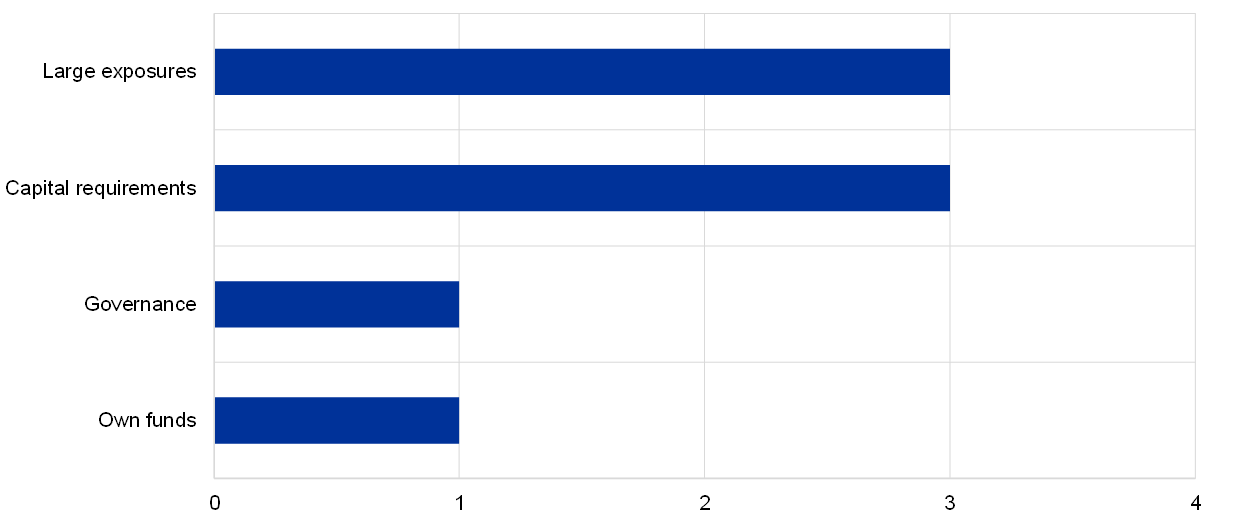
Source: ECB.
If the ECB has reason to suspect that a criminal offence may have been committed, it asks the relevant NCA to refer the matter to the appropriate authorities for investigation and possible criminal prosecution, in accordance with national law. In this context, three such requests were submitted to the relevant NCAs in 2020.
2.2.2 Whistleblowing
In 2020 the ECB received 208 whistleblowing reports, a 56% increase on the previous year
Under Article 23 of the SSM Regulation, the ECB is required to ensure that effective mechanisms are put in place to enable any person to report breaches of relevant EU law (a process commonly referred to as whistleblowing). Accordingly, the ECB set up a whistleblowing mechanism which includes a pre-structured web platform that is accessible through the ECB’s banking supervision website.
The ECB ensures full confidentiality of the whistleblowing reports received through the web platform or other channels (e.g. email or post) and takes into account all available information when carrying out its supervisory tasks.
The ECB received 208 whistleblowing reports in 2020, an increase of 56% compared with the previous year. Of these, 126 referred to alleged breaches of relevant EU law, 113 of which were considered to be within the ECB’s supervisory remit and 13 within that of the NCAs. The remainder referred mainly to alleged breaches of non-prudential requirements (e.g. consumer protection) and therefore fell outside the scope of the whistleblowing mechanism.
Among the most common alleged breaches reported were governance issues (76.9%) and inadequate calculation of own funds and capital requirements (5%). The complete breakdown is shown in Chart 27. Governance-related issues referred mainly to risk management and internal controls, management body functions, fit and proper requirements and organisational structure.[52]
Chart 27
Alleged breaches reported via the whistleblowing mechanism
(percentages)
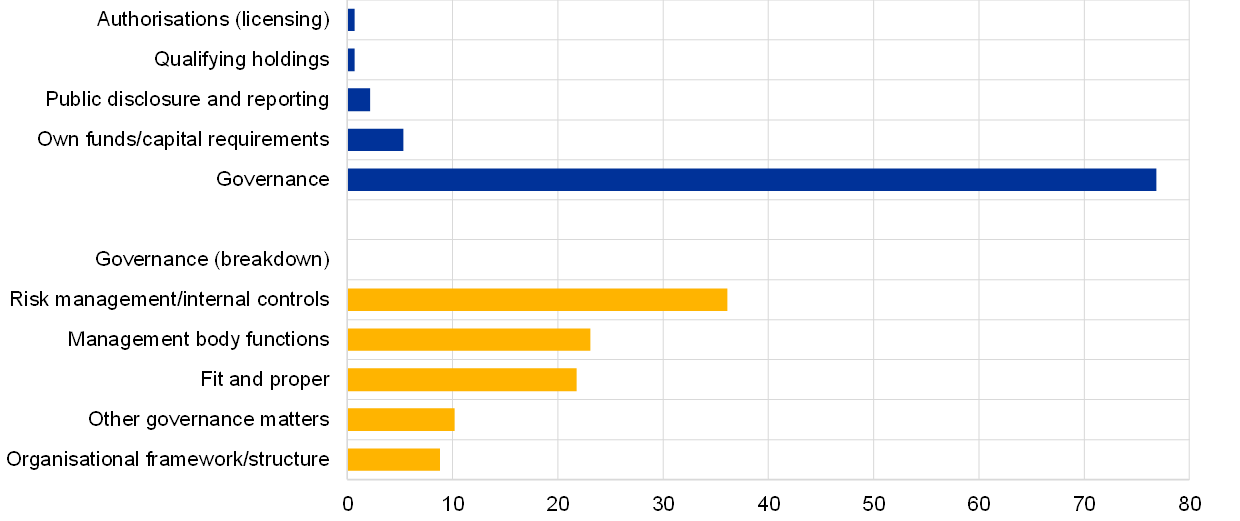
Source: ECB.
The relevant Joint Supervisory Teams were made aware of the information reported through the whistleblowing mechanism. The information was given appropriate consideration (e.g. by assessing its impact on the risk profile of supervised entities) and followed up on by the ECB as part of its supervisory tasks. The main investigatory actions taken in 2020 in relation to whistleblowing reports on breaches of relevant EU law included:
- internal assessment based on existing documentation (75% of the cases);
- request for an internal audit or on-site inspection (23% of the cases);
- request for documents or explanations from the supervised entity (2% of the cases).
3 Contributing to crisis management
3.1 Interaction with the Single Resolution Board
In 2020 ECB Banking Supervision and the Single Resolution Board (SRB) continued to cooperate closely at all levels. The ECB’s Supervisory Board invited the Chair of the SRB to participate as an observer in its meetings for items relating to the tasks and responsibilities of the SRB, while an ECB representative participated as an observer in the SRB’s Executive and Plenary Sessions. Moreover, there were regular exchanges between the Chairs and senior management of the ECB and SRB on crisis management topics and arrangements for cooperation and information exchange between the ECB and the SRB. Finally, in line with the Memorandum of Understanding in place between the ECB and the SRB, ECB Banking Supervision shared a broad set of relevant data and information with the SRB, helping to ease the reporting burden on banks.
In line with the regulatory framework, in 2020 ECB Banking Supervision consulted the SRB on 96 recovery plans submitted by the SIs for which the ECB is the consolidating supervisor. ECB Banking Supervision took the SRB’s feedback into account when assessing these plans and preparing its own feedback to banks.
When consulted on the SRB’s resolution plans, ECB Banking Supervision offers feedback from a supervisory and going-concern perspective
Moreover, the SRB consulted ECB Banking Supervision on 100 draft resolution plans. This consultation also covered the determination of the minimum requirement for own funds and eligible liabilities (MREL), resolvability assessments and, where relevant, decisions to grant an internal MREL waiver. ECB Banking Supervision’s feedback to the SRB focused on how resolution plans might affect banks’ ability to continue operating.
In 2020 the ECB and SRB participated in two crisis simulation exercises aimed at (i) testing the coordination and timeliness of information sharing between relevant authorities before and during resolution, and (ii) enhancing understanding of each authority’s decision-making and operational processes in resolution cases.
Cooperation with the SRB also included exchanges of views on potential improvements to the crisis management policy framework. As in previous years, the SRB also consulted ECB Banking Supervision on the calculation of the ex ante contributions to the Single Resolution Fund, with the ECB’s assessment focusing on the potential impact on SIs from a going-concern perspective.
3.2 Work on recovery planning
Recovery plans are intended to ensure that banks are resilient to severe financial stress
When assessing recovery plans, the ECB’s main focus is to ensure that banks are prepared and able to restore their viability in periods of severe financial stress. Therefore, the plans need to include credible recovery options that can be implemented by banks in a timely manner. The financial stress caused by the COVID-19 pandemic highlights how important it is for banks to have sound recovery plans as a crisis management tool in such stress situations.
The pandemic had a significant impact on the ECB’s work on recovery planning in 2020. In April the ECB granted substantial operational relief to banks for non-core parts of their recovery plans.[53] At the same time, as crisis preparedness is key to weathering financial stress, the ECB encouraged banks to review and strengthen the core elements of their recovery plans, such as recovery indicators, recovery options and overall recovery capacity (ORC)[54], and to document this in the recovery plans submitted during the last quarter of 2020.
A key finding from the ECB analysis of the impact of COVID-19 on banks’ recovery options and ORC and their ability to react to such an extraordinary event based on their 2019 recovery plans was that developments related to COVID-19 could significantly reduce banks’ ORC. If capital raising and sales of subsidiaries are not possible owing to adverse market conditions, banks’ ORC could drop by around 60% (Chart 28). The findings are similar for liquidity; if wholesale funding became unavailable in a crisis situation the liquidity recovery capacity would fall by 27%.[55] Also, some banks rely on a very small number of recovery options; for 16% of SIs, the main recovery option is responsible for over 80% of their ORC.
The ECB also found that the calibration of some indicators was not effective to deal with the COVID‑19-related stress. Despite the fact that there have been numerous breaches of recovery indicators since the start of the COVID‑19 pandemic, the macroeconomic and market-based indicators were too backward-looking to result in a timely breach of the indicators.
Consequently, when assessing recovery plans in 2021, the ECB will focus on challenging banks’ recovery options and ORC, identifying areas for improvement (such as enhancing the feasibility of options and the time required to implement them) and encouraging banks to include more robust, forward-looking indicators in their recovery frameworks. The objective is to obtain a more realistic view of banks’ ORC in stress scenarios and to help improve the usability of banks’ recovery plans in crisis situations.
Chart 28
Capital recovery capacity under pandemic stress conditions and under banks’ original assumptions
(x-axis: time in months; y-axis: CET1 in percentage points)
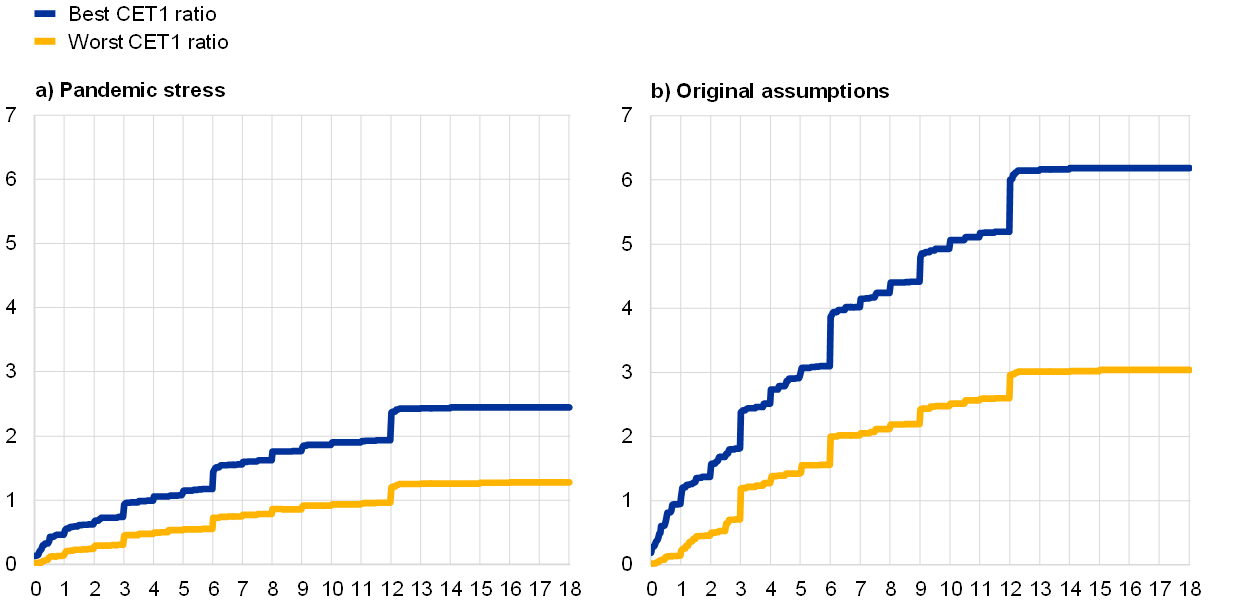
Source: Recovery plans submitted by SIs in 2019.
Note: Capital recovery capacity is measured in terms of the CET1 ratio. The pandemic stress scenario assumes that capital increases and sales of subsidiaries are not possible owing to the COVID-19 stress.
3.3 Crisis management and European integration
Improvements to the crisis management framework can lead to greater integration of the European banking market
In 2020 ECB Banking Supervision contributed to the policy discussion on possible improvements to the crisis management framework, focusing on topics relevant to banking supervision and those which can lead to greater integration of the European banking market.
In this context, the ECB continued to highlight the importance of removing the overlap between supervisory measures and early intervention measures and of introducing the ECB’s early intervention powers into EU regulation, which would make them directly applicable. It also stressed the need to ensure that non-viable banks which have been declared failing or likely to fail and are not subject to resolution exit the banking sector within a relatively short time frame and that the supervisor is granted the power to withdraw their banking licences in all cases.
On the topic of cross-border integration of banking groups, in a joint blog post[56] the Chair of the ECB’s Supervisory Board and Edouard Fernandez-Bollo, Member of the Supervisory Board, made some concrete proposals to facilitate an efficient allocation of liquidity resources within banking groups while providing safeguards to host authorities. The granting of cross-border liquidity waivers could be linked to the existence of adequate intragroup financial support agreements included in banking groups’ recovery plans. In these agreements the parent and subsidiaries would commit to providing each other with liquidity support when certain recovery indicators are breached. This stronger link with the group recovery plan would provide additional reassurance about the application of group support both at the level of the parent and at the level of the subsidiary, as ECB Banking Supervision assesses the recovery plans and could be empowered to enforce the agreements included in those plans.
Finally, ECB Banking Supervision contributed to the policy discussion on how non-viable banks currently not subject to resolution could be better handled through the use of tools at the European level, or at least by adopting a harmonised approach across the banking union. Setting up an EU administrative bank liquidation regime supplemented with a single deposit insurance scheme for the banking union, similar to the Federal Deposit Insurance Corporation model in the United States, could be one possible solution. In this context, further progress is required to establish a European deposit insurance scheme (EDIS), which is the crucial third pillar of the banking union. EDIS would further enhance depositor protection and support financial stability, thus contributing to deeper integration of the Single Market.
The policy discussions and proposals mentioned above also benefited from technical exchanges and staff discussions between the ECB and the SRB.[57]
3.4 Crisis management involving less significant institutions
Managing the crisis of a less significant institution (LSI) requires close cooperation between the relevant national competent authority (NCA) and the ECB – the NCA as the authority directly responsible for supervisory tasks relating to the LSI and the ECB in its oversight function and in its direct role for decisions on common procedures. The need for intensified cooperation arises when an LSI is identified as facing financial deterioration and approaching the point of non-viability. At this stage, the ECB and the NCA have to liaise on a potential withdrawal of the authorisation, the assessment of acquisitions or increases in qualifying holdings and the granting of new authorisations (e.g. for a bridge institution).
Such close cooperation in the area of LSI crisis management aims to support the NCAs and the ECB in their respective tasks and ensure that the required information is available when urgent decisions need to be taken. The information exchanged, actions taken and the cooperation between the ECB and the NCAs are proportionate to the risks posed by an LSI and the potential negative impact, also taking into account private sector solutions already identified by the NCA.
In 2020 crisis management coordination groups were set up between the ECB and the NCAs
Throughout 2020 cooperation between the NCAs and the ECB was characterised by a regular and smooth exchange of information. Among other things, this included setting up dedicated crisis management coordination groups made up of ECB and NCA staff to ensure effective cooperation and coordination between institutions. The intensified cooperation ensures that supervisory actions and decisions can be taken in a timely and coordinated manner whenever needed.
In 2020 the NCAs notified the ECB of 12 new cases concerning the financial deterioration of LSIs. Furthermore, the ECB and the NCAs continued to work closely together and exchange information on approximately 40 active cases of financial deterioration of LSIs across European banking supervision. Six cases of more severe financial deterioration were identified as crisis cases and were subject to intensified cooperation between the ECB and the NCAs. In 2020 the NCAs also notified the ECB of ten cases related to withdrawals of authorisation. In seven of these cases, the ECB adopted a decision on the licence withdrawal, while the remaining three cases are still under assessment.
Unviable business models, continuously low profitability leading to breaches of the regulatory requirements (e.g. the minimum capital and liquidity requirements and the large exposure limit) and deficient governance systems (including inadequate frameworks against money laundering) were the main causes of financial deterioration of LSIs in 2020. In addition, accounting fraud emerged as a strong driver of financial deterioration. The outbreak of the COVID-19 pandemic and the market volatility in early 2020 had a substantial negative impact on some LSIs, leading to a deterioration of their financial situation.
4 Cooperating across borders
4.1 Enlarging the SSM through close cooperation
In 2020 close cooperation was established with the Bulgarian National Bank and Hrvatska narodna banka
EU Member States whose currency is not the euro can participate in the SSM by requesting the establishment of close cooperation between the ECB and their national competent authority (NCA). This concept came to fruition in 2020, when the ECB established close cooperation with Българска народна банка (Bulgarian National Bank) and Hrvatska narodna banka, following the fulfilment of the necessary supervisory and legislative prerequisites.[58] This has increased the size of the SSM, bringing the total number of participating EU Member States to 21, and will support more integrated banking supervision, while also contributing to maintaining and deepening the Internal Market.
Completion of the comprehensive assessment was a key milestone in the process
Entering into close cooperation marked the successful completion of a process that was launched with requests from Bulgaria and Croatia in 2018 and 2019, respectively. On 5 June 2020 the ECB announced[59] that it had completed the comprehensive assessment of five Croatian banks.[60] On 11 September 2020 the ECB announced[61] that five banks in Bulgaria and eight banks in Croatia had been identified as significant institutions and would therefore be subject to direct supervision by the ECB.
Since October 2020 the ECB has been in charge of supervising significant institutions in Bulgaria and Croatia and of common procedures
Representatives from the two NCAs were appointed to the Supervisory Board with the same rights and obligations as all other members and direct supervision of the significant institutions of these two Member States started on 1 October 2020. In addition, the ECB became the supervisor in charge of common procedures for all supervised institutions and took on responsibility for the oversight of the less significant institutions in the two countries. Under close cooperation, the ECB carries out its supervisory tasks by addressing instructions to the two NCAs, which then address supervisory decisions to the banks. ECB Banking Supervision, the Bulgarian National Bank and Hrvatska narodna banka have collaborated very closely to ensure the smooth integration of the two NCAs into the SSM.
4.2 European and international cooperation
4.2.1 Cooperation with other EU supervisory authorities and authorities from non-EU countries
ECB Banking Supervision cooperates extensively with other supervisory authorities inside and outside the EU
The ECB cooperates and regularly exchanges information with the authorities of EU Member States in compliance with the provisions of the CRD on cooperation and exchange of information between competent authorities in the EU. It also negotiates and enters into Memoranda of Understanding (MoUs) with national market authorities of EU Member States, where necessary.
In addition, the ECB cooperates with the prudential authorities of non-EU countries through MoUs, participation in supervisory colleges or agreements concluded on a case-by-case basis. So far, the ECB has concluded MoUs with 18 supervisory authorities of non-EU countries. In 2020 the ECB concluded MoUs with five supervisory authorities in non-EU countries, including one with the three US prudential authorities, namely the Board of Governors of the Federal Reserve System, the Office of the Comptroller of the Currency and the Federal Deposit Insurance Corporation. These MoUs covered the sharing of supervisory information and other forms of cooperation relevant for the performance of the parties’ respective tasks related to the prudential supervision of banks and banking organisations in their respective jurisdictions.
Moreover, with a view to further enhancing its transparency and accountability framework, the ECB has approved a publication policy that covers all existing and future supervisory MoUs that the ECB has concluded or will conclude in its capacity as prudential supervisor. The ECB is working on the implementation of this new policy.
Finally, following the internal reorganisation of ECB Banking Supervision, as of 1 October 2020 a dedicated accountability and cooperation section was established in the SSM Secretariat of the Directorate General SSM Governance and Operations. Among the tasks entrusted to the new section is to negotiate and conclude MoUs and handle ad hoc requests for exchanges of information with European and non-EU authorities.
4.2.2 IMF Financial Sector Assessment Programs
The IMF’s Financial Sector Assessment Programs (FSAPs) are comprehensive, in-depth assessments of a country’s financial sector.
ECB Banking Supervision implemented many of the recommendations of the IMF FSAP for the euro area
The 2018 IMF euro area FSAP examined the banking supervision and resolution architecture in the euro area. ECB Banking Supervision has already incorporated many of the IMF’s recommendations into its supervisory practices, while EU co‑legislators are currently addressing the recommendations that require modifications to EU law.
National FSAPs do not include assessments of European banking supervision
In 2020 the IMF concluded the national FSAPs for Austria and Italy and continued its work on the FSAP for Latvia. These national FSAPs assess non-banking topics, such as domestic insurance and macroprudential frameworks, and entail a holistic assessment of banking issues, especially those that fall under the remit of national authorities supervising less significant institutions or aspects related to anti-money laundering and combating the financing of terrorism.
The ECB is involved in national IMF Article IV consultations
The ECB’s involvement in national IMF Article IV consultations for countries participating in European banking supervision relates to microprudential and macroprudential issues, in line with the ECB’s responsibilities in these areas.
Following the outbreak of COVID-19, the IMF suspended its work on FSAPs and Article IV consultations. The IMF is planning a gradual resumption of its surveillance activities, and ECB Banking Supervision will remain engaged in these exercises, in line with its responsibilities.
4.3 Contribution to developing the European and international regulatory framework
4.3.1 Contributing to the work of the Financial Stability Board
In 2020 ECB Banking Supervision actively contributed to the work of the Financial Stability Board
In 2020 the Financial Stability Board (FSB) focused on ensuring that a quick and coordinated response to the financial stability challenges resulting from the COVID‑19 pandemic could be agreed at international level, so as to support the continued flow of financing and other key financial services to the real economy.
As a member of the FSB, ECB Banking Supervision actively contributed to the design and implementation of the COVID-19 response as well as the delivery of important milestones of the G20 Presidency. Work was carried out to synthesise measures taken across G20 countries, identify the most effective policy responses, and analyse the flexibility of standards and the consistency of policy measures with international standards.
In addition to the COVID-19 response, ECB Banking Supervision also contributed to the broader issues on the FSB agenda, such as (i) the annual identification of global systemically important banks in consultation with the Basel Committee on Banking Supervision; (ii) the completion of the toolkit of effective practices for cyber incident response and recovery; (iii) the evaluation of the effects of too-big-to-fail reforms; (iv) supervisory issues related to the transition to new, more robust benchmark rates in financial contracts; (v) in the context of the work on addressing market fragmentation in relation to international banking groups, pre-positioning of capital and liquidity resources in host jurisdictions; and (vi) the implications of climate change for financial stability. In this context, ECB Banking Supervision participated in the meetings of the FSB Plenary, the Standing Committee on Standards Implementation and the Standing Committee on Supervisory and Regulatory Cooperation, as well as the Resolution Steering Group and the FSB’s Regional Consultative Group for Europe.
ECB Banking Supervision will continue to contribute to the FSB work programme in a number of areas, including the COVID-19 response, the follow-up work on cyber resilience, the completion of the too-big-to fail evaluation, climate change, and progress on total loss-absorbing capacity and bail-in issues.
4.3.2 Contributing to the Basel process
As a member of the BCBS, ECB Banking Supervision promoted international cooperation and the coordination of policy measures, also during crisis times
In 2020 the Basel Committee on Banking Supervision (BCBS) focused on ensuring a rapid and internationally coordinated response to the COVID-19 pandemic. BCBS members adopted a range of regulatory and supervisory measures to ensure that banks could continue to lend and provide other key financial services to the real economy, while facilitating their ability to absorb losses in an orderly manner.[62] In this context, the Basel Committee’s oversight body, the Group of Central Bank Governors and Heads of Supervision (GHOS), announced a deferral of Basel III implementation to increase the operational capacity of banks and supervisors to respond to COVID‑19.[63] The Committee adopted additional measures to alleviate the economic impact of the coronavirus, notably with regard to the transitional arrangements for the regulatory capital treatment of expected credit loss accounting.[64] The ECB actively contributed to these efforts.
In addition, the Basel Committee continued its strategic review aimed at strengthening its capacity to respond to future challenges and opportunities. This review was completed in October 2020 and was subsequently endorsed by the GHOS.[65] The ECB contributed to this exercise by drawing on its experience in other European and international fora and encouraged BCBS to adopt a more strategic focus on the main risks and lessons learned.
ECB Banking Supervision also participated in regular policy discussions, providing expertise in BCBS working groups, cooperating with BCBS members within the EU and across the globe, and supporting relevant impact analyses. In addition to the various COVID-19 related work streams, this work included (i) the launch of the consultation on principles for operational risk and operational resilience; (ii) a joint report by the BCBS and the FSB on supervisory recommendations for benchmark rate transition; and (iii) the finalisation of AML/CFT guidelines on supervisory cooperation.
4.3.3 Contributing to the work of the EBA
In 2020 ECB Banking Supervision continued to work closely with the European Banking Authority (EBA) to promote consistent supervision across the European banking sector and increase financial stability. In 2020 this work focused heavily on the regulatory and supervisory response to the COVID-19 crisis.
Throughout the COVID-19 crisis, the ECB and EBA’s responses were fully aligned
The ECB and EBA were fully aligned in their responses to the crisis, as reflected in the ECB’s early supervisory relief measures announced on 12, 20 and 27 March and the EBA’s stances declared on 12, 25 and 31 March. The ECB fully supported the EBA’s decision to postpone the EU-wide stress test by one year and extended this postponement to all SIs that were subject to the ECB’s 2020 stress test. ECB Banking Supervision also contributed to the development and subsequent implementation of the EBA Guidelines on legislative and non-legislative moratoria on loan repayments in the light of the COVID-19 crisis. In addition, the ECB contributed to the update of the EBA’s reply to the European Commission’s Call for advice on the implementation of the final Basel III reforms in the light of the impact of the COVID‑19 pandemic.
Regarding the EBA’s comply-or-explain procedure[66], in 2020 ECB Banking Supervision notified the EBA of its intentions with respect to nine guidelines, as documented on the ECB’s banking supervision website. So far, ECB Banking Supervision has consistently informed the EBA that it complies or intends to comply with all applicable guidelines as issued by the EBA or the Joint Committee of the European Supervisory Authorities.
The ECB also played a part in the successful conclusion of two EU-wide transparency exercises carried out by the EBA in 2020, by ensuring the timely provision of accurate supervisory data for participating SIs. The spring exercise covered 93 SIs and provided market participants with detailed information on the financial conditions of EU banks as at year-end 2019. The autumn exercise included 100 SIs and provided market participants with updated information on the financial conditions of EU banks, including the initial impact of the COVID-19 crisis on the banking sector.
The ECB also contributed to two EBA mandates in the area of reporting. The first mandate is to prepare a feasibility report on the integration of statistical, resolution and prudential reporting. After consulting the Supervisory Board, the European System of Central Banks (ESCB) published its contribution to the EBA report in September.[67] The report considers a common data dictionary and a common data model across all reporting domains to be prerequisites to reducing the reporting burden, improving data quality and paving the way for further integration of the reporting framework. The report also recommends establishing a joint committee comprising European authorities and, where appropriate, the banking industry, to steer the integration process. The second EBA mandate concerns a study on the cost for banks of complying with reporting requirements, as mandated by Article 430(8) of the CRR, which aims to reduce the supervisory reporting burden at least for small and non-complex institutions. In its advice, the ECB noted that the envisaged common data dictionary and common data model could reduce the reporting burden without sacrificing the data needs of supervisors.
Box 5
The ECB and anti-money laundering/combating the financing of terrorism
The responsibility for the supervision of credit and financial institutions in the area of anti-money laundering and combating the financing of terrorism (AML/CFT) lies at the national level. The ECB’s supervisory tasks explicitly exclude AML/CFT supervision, and under the Treaty on the Functioning of the European Union the ECB cannot exercise this task.
However, it is important for the ECB to consider the outcomes of AML/CFT supervision when performing its prudential supervisory tasks; this is in line with the SSM Regulation and the new requirements introduced in the revised Capital Requirements Directive, which was adopted by the EU co-legislators in May 2019 and was required to be transposed into the national legal frameworks by December 2020.
Based on the multilateral agreement signed by the ECB and the national AML/CFT supervisors of credit and financial institutions pursuant to the fifth AML Directive[68], ECB Banking Supervision actively exchanges information with the national AML/CFT supervisors, both on a regular basis and on an ad hoc basis. For example, supervisory information collected via on-site inspections is sent, when the related findings are deemed relevant, to the competent AML/CFT authority supervising the entity concerned. Likewise, the AML/CFT authorities send the ECB information that they deem relevant and necessary for the performance of the tasks laid down by the SSM Regulation.
The internal AML coordination function, created within ECB Banking Supervision at the end of 2018, plays a key role in this process. The methodological framework of ECB Banking Supervision has been further enhanced over the past two years to better take money laundering and terrorism financing risks into account in the supervisory processes related to off-site and on-site supervision, authorisation procedures and fit and proper assessments. JSTs considered AML/CFT-related findings in the 2020 SREP, particularly in relation to the assessment of banks’ internal governance and risk management, operational risk, business models and liquidity risk.
Recent regulatory initiatives have aimed to further strengthen the EU-wide framework for AML/CFT. In May 2020 the European Commission published an action plan for a comprehensive Union policy on preventing money laundering and terrorist financing[69], which was followed by the Council conclusions adopted in November 2020. The corresponding legislative proposal by the Commission is expected to be published in the first quarter of 2021.
ECB Banking Supervision will ensure that its methodologies are reviewed and updated after the relevant EBA Guidelines have been agreed. In this respect, the ECB has been actively involved in enhancing the policy framework at European level in its capacity as prudential supervisor.
5 Organisational set-up of ECB Banking Supervision
5.1 Reorganisation of ECB Banking Supervision
5.1.1 Context and strategic direction
The previous organisational structure allowed the ECB to establish its reputation as a strong and demanding supervisor
The initial organisational structure of ECB Banking Supervision was set up in 2013 when the SSM was established and microprudential supervisory tasks were conferred upon the ECB by the SSM Regulation. In terms of staffing, in 2020 the total number of approved full-time equivalent (FTE) positions for the ECB’s banking supervision arm reached 1,230.5, an increase of 41.5 positions compared with 2019.
In terms of gender diversity, the percentage of female staff increased from 40.7% to 41.6% of all permanent and fixed-term staff in core ECB Banking Supervision business areas in 2020. The proportion of female staff in managerial positions decreased slightly from 32.2% in 2019 to 31.6% in 2020. In non-managerial positions the proportion of female staff increased year on year from 38.1% to 40%; in support positions it decreased from 98.5% in 2019 to 96.8% in 2020.
While the previous structure was effective in helping the ECB establish its reputation as a strong and demanding supervisor, ECB Banking Supervision is now transitioning into a more mature organisation.
Launched in January 2020, the reorganisation of ECB Banking Supervision had three overarching objectives: (i) to increase engagement and cooperation across all functions and staff levels and focus on strategic priorities and addressing the shortcomings highlighted by banking supervision management and staff; (ii) to simplify key supervisory processes and streamline administrative procedures and make them more risk-focused, while paying attention to the compliance burden for banks; and (iii) to improve transparency, predictability, clarity about supervisory actions, and effective communication.
In support of these overarching objectives, the reorganisation sought to:
- build on synergies and gain efficiency by pooling expertise and grouping key tasks where possible;
- enhance collaboration and knowledge-sharing in day-to-day line supervision by combining firm-specific and horizontal supervisory functions, for example by creating dedicated pools of experts;
- foster consistency and robustness of outcomes by formalising a second line of defence;
- align the span of control across ECB Banking Supervision by structuring the organisational units based on organisational design guidelines.[70]
The reorganisation, which was completed without recourse to external consultancy, benefited from the close involvement of ECB Banking Supervision staff, including through dedicated workshops.
Figure 1
Reorganisation of ECB Banking Supervision

5.1.2 New organisational structure
The new organisational structure has seven business areas
The new high-level organisational structure, including the divisions in each business area and the distribution of approved headcount per area, is presented below. When implementing the new structure, particular attention was paid to preserving the strong cooperation between the different ECB Banking Supervision business areas and their counterparts at the national competent authorities (NCAs).
Figure 2
New organisational structure of ECB Banking Supervision
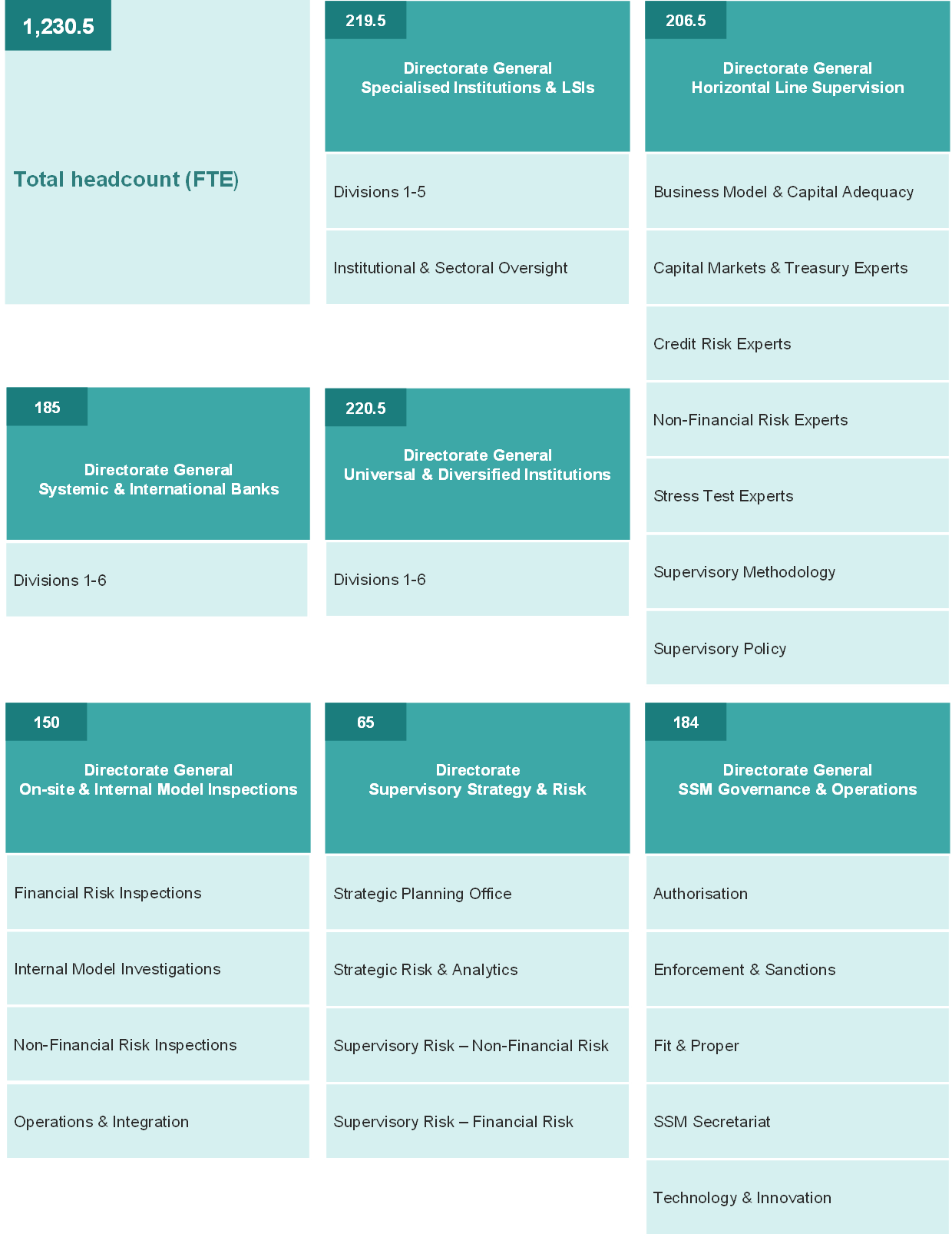
Line supervision
In the new structure, line supervision is exercised through the combination of firm‑specific supervision and horizontal line supervision. The day-to-day supervision of individual banking groups and credit institutions is based on collaboration between Joint Supervisory Teams (JSTs), the less significant institution (LSI) oversight teams and the horizontal line supervision expert teams.
Firm-specific supervision
Three Directorates General are responsible for firm-specific supervision: Directorate General Systemic and International Banks; Directorate General Universal and Diversified Institutions; and Directorate General Specialised Institutions and LSIs.
Supervised banks and institutions are clustered by business model to create more synergies and efficiency gains within the JSTs and to foster knowledge-sharing.
Horizontal line supervision
The Directorate General Horizontal Line Supervision is responsible for conducting horizontal line supervision (including crisis management), focusing on risk-based supervision and policy outcomes and strengthening the support offered by risk experts to JSTs and LSI oversight teams. Pooling risk experts in this area should result in further efficiency gains and consistency.
On-site and internal model inspections
All functions relating to the planning and performance of on-site supervisory activities – including on-site inspections (either institution-specific or through campaigns), internal model investigations, asset quality reviews and the project management office of comprehensive assessments – are brought together in the Directorate General On-site and Internal Model Inspections.
Supervisory strategy and risk
The Directorate Supervisory Strategy and Risk comprises the functions of a supervisory risk office and acts as a second line of defence and the strategic planning and priority-setting function for banking supervision. These tasks are independent from the first-line supervision functions, and the Directorate reports directly to the Chair and Vice-Chair of the Supervisory Board. This set-up ensures the necessary credibility to support strategic planning and challenge supervisory outcomes by combining in-depth knowledge of the banking sector, thorough understanding of the challenges encountered in banking supervision, and high-quality critical analyses.
The Directorate is in charge of ensuring that key supervisory outcomes are consistent with supervisory priorities and supervisory risk tolerance. It does this through a combination of ex ante assessments or advice and ex post reviews. This function plays a key role in a steady-state, risk-focused supervisory organisation, where supervisory judgement is essential and processes are streamlined.
Governance and operations services
The Directorate General SSM Governance and Operations oversees the high volume of processes and services related to supervisory governance and operations.
This new Directorate General carries out the tasks typically allocated to a Chief Operating Officer. It is responsible for the large number of operations related to the decision-making of the Supervisory Board and its substructures and to authorisation procedures. From a business perspective, the Directorate General leads the development and running of the supervisory technological infrastructure, including the SSM information management system (see Section 5.7.2). It is tasked with promoting collaboration within European banking supervision, simplifying supervisory procedures, encouraging knowledge management, including training, and carrying out prudential investigations.
5.1.3 Implementation process
The allocation of staff members in the new structure was based on three principles – business need, continuity and equal treatment – with the aim of moving whole teams as far as possible so as to maximise efficiency and allow for a smooth transition of operations. Following their reallocation, staff were given the opportunity to express an interest in mobility or a facilitated job swap.
The new organisational structure became effective as of 1 October 2020. Beyond the change of structure and allocation of staff members, there were a number of change management activities, which are still under way, to foster the desired change in the corporate culture. The ongoing change journey is mainly based on three pillars: fostering role modelling from senior managers, enabling bottom up initiatives by inviting staff to become change agents, and periodically measuring change effectiveness.
5.1.4 Supervisors Connect
1,000 people participated in Supervisors Connect, 700 of whom came from NCAs and NCBs
The reorganisation was one of the topics discussed at the second Supervisors Connect event. This SSM-wide event, which is held every two years, took place on 7-8 October 2020.
Supervisors Connect was introduced in 2018 with the purpose of promoting a family spirit within European banking supervision and further shaping the common supervisory culture. Originally designed as a physical event to be held on the ECB premises in April 2020, the second Supervisors Connect was postponed and reformatted owing to COVID-19. The event eventually took place online (via videoconference) and brought together more than 1,000 supervisors from the ECB, the NCAs and the national central banks (NCBs), including newcomers from the Bulgarian and Croatian supervisory authorities. The event focused on analysing the achievements of the SSM and the lessons learned from the COVID-19 crisis (including the supervisory strategy in a new normal). Participants also discussed new forms of collaboration between NCAs.
5.2 Discharging of accountability requirements
In 2020 ECB Banking Supervision continued to engage closely with the European Parliament and the EU Council
This Annual Report constitutes one of the main accountability channels for ECB Banking Supervision vis-à-vis the European Parliament and the Council of the European Union, as stipulated in the SSM Regulation. The Regulation provides that the ECB’s supervisory tasks be subject to appropriate transparency and accountability requirements. The ECB attaches great importance to maintaining and fully applying the accountability framework that is set out in further detail in the Interinstitutional Agreement between the European Parliament and the ECB and in the Memorandum of Understanding (MoU) between the EU Council and the ECB.
With regard to interactions with the European Parliament in 2020, which took place via videoconference as a consequence of the COVID-19 pandemic, the Chair of the Supervisory Board spoke before the Parliament’s Committee on Economic and Monetary Affairs in two ordinary public hearings (on 5 May and 27 October) and two ad hoc exchanges of views (on 14 January and 26 March). The discussions with the European Parliament mainly focused on ECB Banking Supervision’s measures in response to the COVID-19 pandemic and the degree of leeway afforded to banks to allow them to further support households and small and medium enterprises. Other issues included the impact of Brexit on the banking sector and the supervisory approach to climate-related risks.
In accordance with the SSM Regulation and the Interinstitutional Agreement between the European Parliament and the ECB, following the ECB’s proposal for his appointment as Vice-Chair of the ECB’s Supervisory Board, Mr Frank Elderson was heard by the Parliament’s Committee on Economic and Monetary Affairs on 25 January 2021. The European Parliament approved the ECB’s proposal in a plenary vote on 8 February and Mr Elderson was appointed by means of an implementing decision of the EU Council with effect from 24 February 2021.
The ECB published 22 replies to written questions from MEPs in 2020
In 2020 the ECB published 22 replies to written questions from MEPs on banking supervision matters and, in line with its reporting requirement to national parliaments, eight replies to written questions from members of national parliaments. The replies addressed, among other things, questions on the supervisory measures taken by the ECB to counter the effects of the COVID-19 pandemic, the relevance of anti-money laundering/combating the financing of terrorism risk for prudential supervision, credit risk, and governance and conduct issues in the banking sector.
In addition, the ECB sent the records of proceedings of its Supervisory Board meetings to the European Parliament, as required under the Interinstitutional Agreement.
The COVID-19 pandemic also influenced the focus of interactions with the EU Council. The Chair of the Supervisory Board attended, via videoconference, two Eurogroup meetings in 2020, which were held on 11 June and 3 November. In these meetings, the Chair participated in an exchange of views on the execution of the ECB’s supervisory tasks, focusing on the supervisory actions and decisions taken to support households, companies and banks in tackling the fallout from the pandemic.
In 2020 the ECB also contributed to the European Court of Auditors’ audits related to banking supervision. The MoU signed by the ECB and the European Court of Auditors (ECA) in 2019 facilitated information sharing between the two institutions in the context of the follow-up to ECA audits on ECB Banking Supervision.
The ECB took action to address the findings and recommendations made by the ECA in its audit reports
Moreover, the ECB continued to work on addressing the recommendations made in the ECA report on crisis management. In this regard, ECB Banking Supervision has developed precise action plans and follow-up measures[71] for most of the eight recommendations issued by the ECA on various issues, including cooperation with external actors, the use of recovery plans for crisis identification and management, and guidance on early intervention assessments. More precisely, ECB Banking Supervision further developed its guidance on early intervention assessments and enhanced the relevant indicators and thresholds for determining a potential deterioration in the financial condition of a bank. With regard to recovery planning, additional guidance was provided to supervisors to promote a consistent approach across banks with similar business models.
The ECB further contributed to the ongoing ECA audit of the European Union’s anti-money laundering policy in the banking sector, together with the Commission and the European Banking Authority (EBA). The ECB also reported to the ECA on the actions it had taken to address the findings and recommendations from the first ECA report on the functioning of the SSM. The implementation status of all ECA recommendations is monitored regularly by the ECB, and the ECA also conducts follow-up exercises.
5.3 Transparency and communication
In 2020 ECB Banking Supervision continued to employ and expand its communications tools and channels in an effort to disseminate information in a timely, transparent and effective way. Given the changed operational circumstances caused by the COVID-19 pandemic, it was particularly important to find innovative ways to communicate. One such way was the newly created Supervision Blog, which featured nine blog posts by the Chair, Vice-Chair and the ECB representatives to the Supervisory Board to inform stakeholders about the latest developments and the supervisory measures adopted by the ECB in response to the COVID-19 pandemic. Furthermore, ECB Banking Supervision expanded its use of social media tools, such as Twitter threads, Instagram stories and the new ECB podcast, to explain the supervisory measures and banking concepts to audiences with different levels of knowledge. This layered communication approach aims to reach interested groups with varied educational and professional backgrounds and different levels of knowledge and understanding.
In addition to using new communication tools, the Chair and Vice-Chair gave 23 speeches and the ECB representatives to the Supervisory Board gave 19 speeches in 2020. Together, they gave more than 20 one-on-one media interviews and published three opinion pieces, of which one appeared in 12 national newspapers across Europe. ECB Banking Supervision published 33 press releases and 65 other items, including letters to MEPs, guidance to banks and quarterly supervisory statistics. Four further editions of the Supervision Newsletter, a quarterly digital publication with more than 8,000 subscribers, were also published in 2020, providing regular information and updates on ongoing supervisory projects, findings and reports.
ECB Banking Supervision also published the outcomes of its core activities, such as the aggregate results of the Supervisory Review and Evaluation Process (SREP), and, continuing the practice that began in 2019, disclosed the Pillar 2 requirements for each directly supervised bank. It also published and communicated the results of its COVID-19 vulnerability analysis, as well as the results of the comprehensive assessments of seven Croatian banks and two additional banks that came under its supervision as a result of Brexit.
ECB Banking Supervision held several media and analyst briefings, including press conferences by the Chair of the Supervisory Board on the 2019 SREP results and on the latest developments related to the COVID-19 situation. ECB Banking Supervision also launched four public consultations, including on the supervisory expectations for managing and reporting climate-related and environmental risks and the supervisory approach to consolidation in the banking sector.
In 2020 the ECB responded to approximately 1,500 public enquiries on banking supervision topics, such as general supervisory information, individual banks, complaints or breach reports and the response to the COVID-19 crisis. Owing to the pandemic, the ECB hosted only two lectures on banking supervision in 2020 (compared with 32 in 2019). However, the Visitor Centre welcomed more than 2,100 visitors from January to March 2020, introducing them to the basics of European banking supervision as well as the other key tasks of the ECB.
5.4 Decision-making
5.4.1 Meetings and decisions of the Supervisory Board and Steering Committee
The ECB’s Supervisory Board is composed of a Chair (appointed for a non-renewable term of five years), a Vice-Chair (chosen from among the members of the ECB’s Executive Board), four ECB representatives and the representatives of the NCAs. If the NCA is not a national central bank, the representative of the NCA may be accompanied by a representative from their national central bank. In such cases, the representatives are together considered as one member for the purposes of the voting procedure.
In October 2020 the Supervisory Board welcomed two new members following the establishment of close cooperation with Bulgaria and Croatia: Radoslav Milenkov from Българска народна банка (Bulgarian National Bank) and Martina Drvar from Hrvatska narodna banka. Both representatives have the same rights and obligations as all other members, including voting rights.
In December 2020, following the end of the mandate of Yves Mersch, the Governing Council of the ECB proposed the appointment of ECB Executive Board member Frank Elderson as Vice-Chair of the ECB’s Supervisory Board. The appointment was confirmed by the EU Council on 24 February 2021.
The ECB’s Supervisory Board met 24 times in 2020. Owing to the COVID-19 pandemic, only the January and February meetings were held in Frankfurt am Main; all other meetings were held via videoconference. Holding the meetings remotely from March 2020 did not impair the efficient decision-making of the Supervisory Board.
Supervisory Board
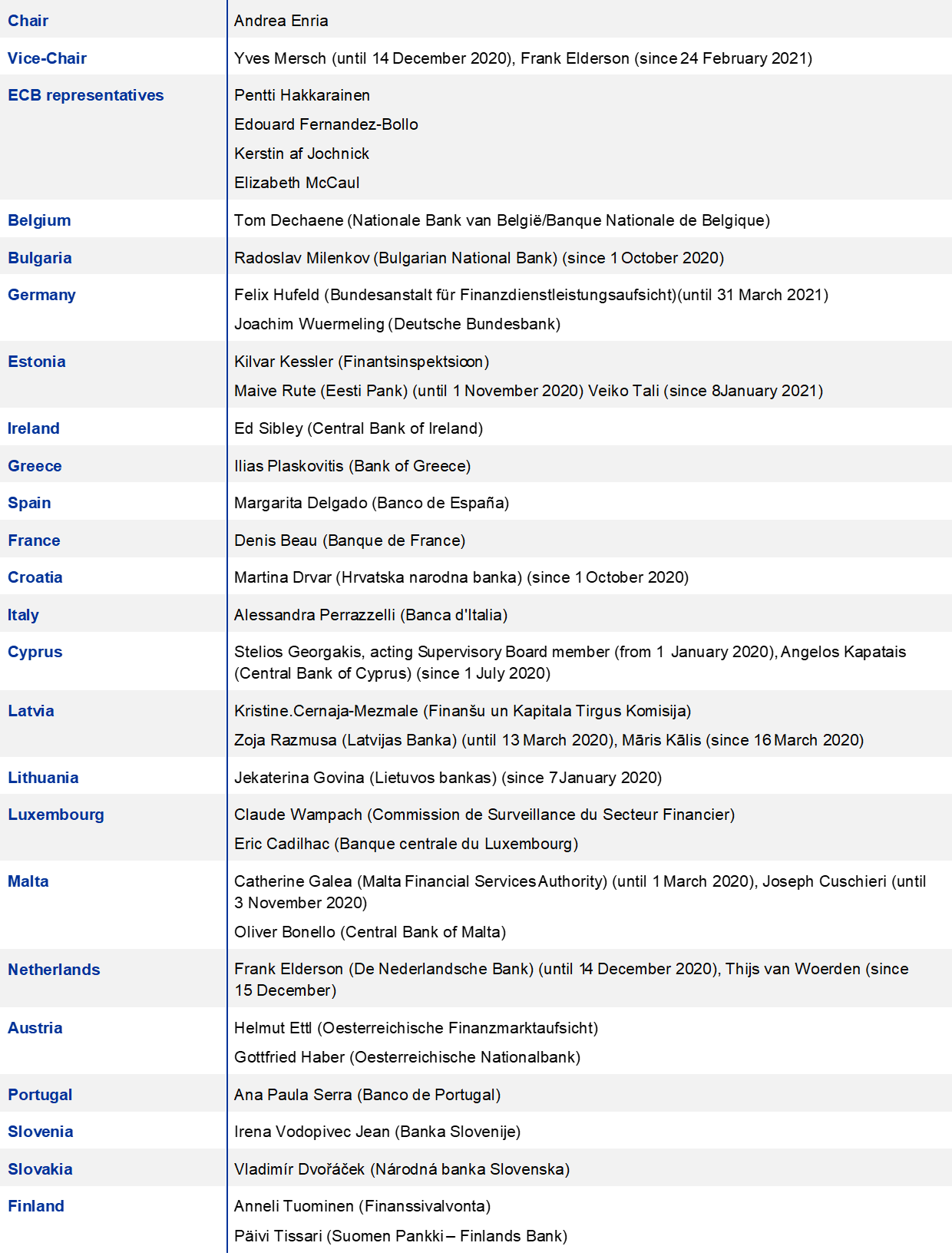
The Steering Committee[72] of the Supervisory Board held seven meetings in 2020. Of these meetings, three were held in Frankfurt am Main and four were held via videoconference.
The Steering Committee held seven additional meetings with a focus on digitalisation and simplification of SSM processes. All of these meetings were held via teleconference and participation was open to all Supervisory Board members who expressed an interest.
In 2020 the ECB issued 2,643 supervisory decisions[73] addressed to specific supervised entities (Figure 3). Of these, 1,019 decisions were adopted by the ECB heads of work units in line with the general framework for delegating decision-making powers for legal instruments related to supervisory tasks. 1,387 decisions were adopted by the Governing Council under the non-objection procedure on the basis of a draft proposal of the Supervisory Board. In addition to these supervisory decisions, the ECB also implicitly approved 237[74] operations (such as the establishment of branches) by not objecting within the legal deadlines
The bulk of the supervisory decisions related to fit and proper assessments (44.1%), internal models (9.3%), own funds (6.2%), and qualifying holdings (3.2%) procedures.
In response to the COVID-19 crisis, the ECB also had to adopt bank-specific decisions to implement some of the policy measures aimed at providing relief to credit institutions (see Box 1). This included 141 decisions granting capital relief by amending the calculation or composition of own funds requirements and 116 decisions granting operational relief by extending deadlines set out in previous supervisory decisions and operational acts.
In addition to the bank-specific final draft decisions submitted to the Governing Council for non-objection, the Supervisory Board decided on several horizontal issues, most notably the application of common methodologies and frameworks in specific areas of supervision. Some of these decisions were prepared by temporary structures mandated by the Supervisory Board. These structures comprised senior representatives from the ECB and the NCAs. They carried out preparatory work on topics such as a long-term stress test strategy and the methodology for determining Pillar 2 capital requirements based on a risk-by-risk approach.
Moreover, some decisions by the Supervisory Board resulted in public guides, such as the ECB Guide on climate-related and environmental risks, the ECB Guide on the supervisory approach to consolidation in the banking sector and the ECB Guide on assessment methodology (EGAM).
The Supervisory Board took the majority of its decisions by written procedure.[75]
Of the 115 banking groups directly supervised by the ECB in 2020, 33 asked to receive formal ECB decisions in an EU official language other than English (compared with 34 in 2019).
Figure 3
Decisions by the Supervisory Board in 2020
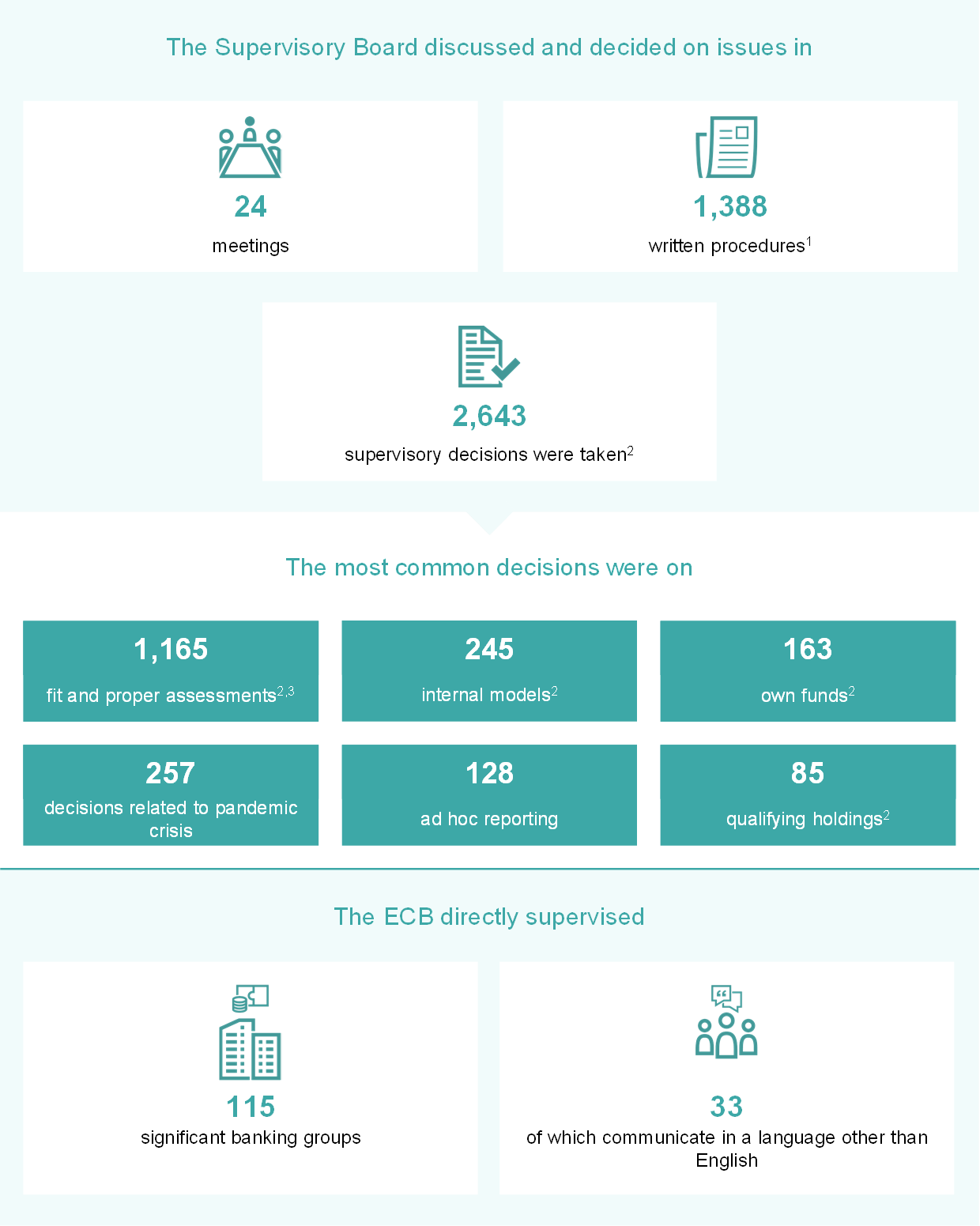
Notes:
1) This figure includes written procedures for individual supervisory decisions and for other issues such as common methodologies and consultations of the Supervisory Board. One written procedure may contain several supervisory decisions.
2) This is the number of individual supervisory decisions addressed to supervised entities, or their potential acquirers, and instructions to national competent authorities on significant institutions or less significant institutions. One decision may contain several supervisory approvals. With the application of the delegation framework, not all of the supervisory decisions included in this number were approved by the Supervisory Board and adopted by the Governing Council. In addition, the Supervisory Board took other decisions on a number of horizontal issues (e.g. common methodologies) and institutional issues.
3) The 1,165 decisions on fit and proper assessments cover 2,828 individual procedures (see Section 2.1.2).
5.4.2 Activities of the Administrative Board of Review
In 2020 the Administrative Board of Review (ABoR)[76] adopted two opinions on new requests for an administrative review filed with the ABoR (Table 5). In one opinion, it found that the request was inadmissible. In the other opinion, the ABoR proposed replacing the decision by a decision of identical content.[77] In that review procedure, based on a request from the applicant, the ABoR proposed that the Governing Council suspend parts of the contested decision until the ABoR procedure had been concluded and a new ECB decision abrogating or replacing the contested decision had been adopted. Subsequently, a hearing was conducted as part of the investigation phase, which gave the applicant and the ECB an additional opportunity to comment on the contested decision. In the light of the COVID-19 pandemic, this hearing was conducted via videoconference.
In addition, the ABoR published on the ECB’s website an adjustment to its working arrangements in the light of the COVID-19 pandemic. In particular, where the ECB decided to suspend the application of a supervisory decision, the ABoR would generally also suspend the corresponding proceedings before it, if any, for the duration of that suspension. Moreover, in the interests of due process, the ABoR may adapt its procedures, which may include an extension of the review period.
Table 5
Number of reviews performed by the ABoR

Source: ECB.
* One opinion covered two ECB decisions.
The opinions finalised by the ABoR in 2020 addressed issues concerning the ECB’s TRIM and an on-site inspection which had not led to a follow-up letter or a supervisory decision.
5.5 Implementing the Code of Conduct
In accordance with Article 19(3) of the SSM Regulation, the ECB has established an ethics framework for high-level ECB officials, management and staff. It comprises the single Code of Conduct for high-level ECB officials, a dedicated chapter in the ECB Staff Rules and the Guideline establishing the SSM Ethics Framework[78]. The implementation and further development of the framework is supported by the ECB Ethics Committee, the Compliance and Governance Office (CGO) and the Ethics and Compliance Officers Task Force (ECTF).
The Ethics Committee assessed the Declarations of Interest submitted by all members of the Supervisory Board; the completed declarations were then published on the ECB’s banking supervision website. In September 2020 the ECB began to publish on its website the opinions of the Ethics Committee in cases of conflict of interest and post‑mandate gainful employment.[79]
In addition to organising training, e-learning programmes and information campaigns on the ethics framework, the CGO responded to around 1,920 requests on a wide range of topics, approximately 48% of which were submitted by ECB Banking Supervision staff. Almost 55% of these requests concerned staff members’ private financial transactions, followed by requests on post-employment restrictions and conflict of interest issues (Chart 29).
Chart 29
Overview of requests received from ECB Banking Supervision staff in 2020
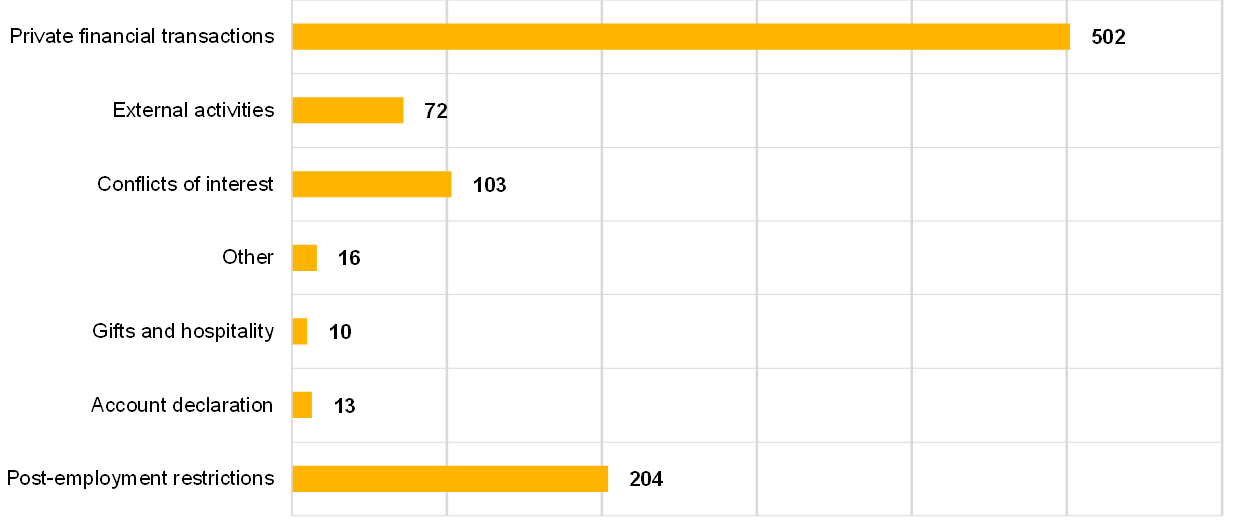
Source: ECB.
The CGO also organised its regular compliance monitoring exercise on staff members’ private financial transactions. While the exercise did identify a limited number of instances of non-compliance, around 36% of which related to ECB Banking Supervision staff, none of these instances involved intentional misconduct or other serious cases of non-compliance.
Of those members of staff involved in banking supervision who resigned from their post in 2020, one case triggered a cooling-off period in line with the ethics framework.
As part of its efforts to build a strong common ethics culture, in 2020 the ECTF focused on harmonising the ethics regimes in place in the NCAs.
5.6 Applying the principle of separation between monetary policy and supervisory tasks
In 2020 the principle of separation between monetary policy and supervisory tasks was mainly applied to the exchange of information between different policy areas.[80]
In line with Decision ECB/2014/39 on the implementation of separation between the monetary policy and supervision functions of the ECB[81], this exchange of information was subject to a need-to-know requirement: each policy area had to demonstrate that the information requested was necessary to achieve its policy objectives. In most cases, access to confidential information was granted directly by the ECB policy function that owned the information. This was done in line with Decision ECB/2014/39, which allows access to information pertaining to anonymised data or non-policy sensitive information to be granted by the policy functions directly. Intervention by the Executive Board to resolve possible conflicts of interest was not necessary.
Under Decision ECB/2014/39, the involvement of the Executive Board was nonetheless required in a few instances to allow for the exchange of non‑anonymised information relating to individual banks or policy-sensitive assessments. Access to the data was granted on a “need-to-know” basis after assessing the business case, and for a limited period of time, to ensure that the need-to-know requirement was met at all relevant points in time.
As regards information related to COVID-19, in March 2020 the Executive Board activated the emergency provision of Article 8 of Decision ECB/2014/39, which provides that no Executive Board approval is necessary for information relating to the particular emergency at hand. This activation removed the need for Executive Board approval for the sharing of COVID-19-related information, subject to a strict need-to-know requirement. This exemption was applied to several exchanges of bank data collected in the context of the COVID-19 pandemic, which were necessary for the fulfilment of the requesting business area’s tasks.
Separation at the decision-making level did not raise concerns and no intervention by the Mediation Panel was required.
5.7 Data reporting framework and information management
5.7.1 Developments in the data reporting framework
In accordance with Article 140(4) of the SSM Framework Regulation, the ECB is responsible for organising the processes relating to the collection and quality review of data reported by supervised entities.[82] The main objective is to ensure that the SSM uses reliable and timely supervisory data.
The ECB regularly assesses the quality of the reported data, including the punctuality of submission, completeness and accuracy. To this end, the ECB develops additional data quality checks together with the NCAs, with the aim of complementing the validation rules published by the EBA. In November 2020 the ECB published the updated and extended list of additional data quality checks, which came into effect from the reference period covering the fourth quarter of 2020.
Aggregated supervisory data and selected Pillar 3 disclosures are published on the ECB’s banking supervision website
In 2020 the ECB further increased the transparency and availability of supervisory data published in the supervisory data section of the ECB’s banking supervision website. First, an interactive layout was introduced, allowing users to analyse and visualise the aggregated supervisory data. The scope of the quarterly publication was further expanded to include tables in which data are broken down by business model classification. In October 2020 the ECB also published for the first time bank-level Pillar 3 information on encumbered and unencumbered assets and collateral received, in addition to the three solvency and leverage ratios. Before publication, the selected Pillar 3 disclosures and regulatory reporting were reconciled, which resulted in substantial improvements in data consistency. This enhanced level of transparency allows stakeholders to perform meaningful comparisons of prudential metrics.
Additional prudential information was collected in 2020 following the COVID-19 outbreak
Following the outbreak of COVID-19, the need to closely monitor institutions’ financial and prudential situation was addressed by requesting selected prudential information at an increased frequency and by slightly extending reporting on certain relevant dimensions. Extended reporting focused on the uptake of moratoria measures and public guarantees (using a common ECB-EBA template); the use of committed lines; operational continuity indicators; and projections of key prudential indices. The ECB templates were processed via CASPER, the ECB’s new data collection platform, which provides greater flexibility and robustness when managing the new data collection.
Further work on the SSM-wide data collection database started in October 2020
Further work on the SSM-wide data collection database[83] started in October 2020. The aim of this work is to create a system that identifies duplications in the data requests stemming from the SSM, thus helping to reduce the reporting burden on banks.
In October 2020 the Supervisory Board also approved guiding principles and subsequent high-level business requirements to harmonise national practices on data collection and data quality assessments across the SSM. While the NCAs’ important contribution to the overall supervisory data collection and quality assessment processes remains unchanged, implementation of the requirements is a first step in developing best practices for a sequential approach across the SSM, with a view to levelling the playing field across institutions.
5.7.2 The SSM information management system
Supervised banks can use the IMAS portal to submit information related to supervisory processes, track their status and exchange information with supervisors digitally and securely
The SSM information management system (IMAS) is a common IT platform that supports European banking supervisors’ daily tasks. In 2020 the IMAS workflows used by all JSTs and SSM horizontal and specialised functions were adapted to support the monitoring of the COVID-19 situation and related supervisory measures, ensuring consistency and comparability across banks and in the SREP assessment. There were also other exceptional structural upgrades to increase the usability and performance of the system. IMAS was also adjusted to the new structure of ECB Banking Supervision. The IDRA (IMAS Data Reporting and Analytics) reporting service, which was launched in 2019, was upgraded with new analysis tools for the extraction and exploration of supervisory data needed to support the SREP. In October 2020 a new online service, the IMAS portal, was launched to provide a secure digital space for supervised institutions to interact with supervisors when submitting applications for fit and proper assessments. The IMAS portal increases transparency for supervised institutions about the progress of the supervisory procedures and reduces operational risk and manual work for supervisors.
6 Reporting on budgetary consumption
6.1 Expenditure for 2020
The SSM Regulation requires the ECB to dispose of adequate resources to carry out its supervisory tasks effectively. These resources are financed via a supervisory fee borne by the entities subject to ECB supervision.
The expenditure incurred for supervisory tasks is separately identifiable within the ECB’s budget. The expenditure incurred consists of the direct expenses of the ECB Banking Supervision function. The supervisory function also relies on shared services provided by the ECB’s existing support business areas.[84]
The budgetary authority of the ECB is vested in its Governing Council. The Governing Council adopts the ECB’s annual budget following a proposal by the Executive Board in consultation with the Chair and the Vice-Chair of the Supervisory Board for matters related to banking supervision. The Governing Council is assisted by the Budget Committee (BUCOM), which consists of members from all the NCBs of the Eurosystem and the ECB. BUCOM assists the Governing Council by providing it with evaluations of the ECB’s reports on budget planning and monitoring.
In 2020 the actual annual expenditure for ECB supervisory tasks was €535.3 million, a slight decrease of 0.3% compared with actual expenditure in 2019.
Table 6
Cost of the ECB’s supervisory tasks by function (2018-20)
(EUR millions)

Source: ECB.
Note: Totals and subtotals in the table may not add up owing to rounding.
In the 2019 Annual Report on supervisory activities, published in March 2020, the ECB estimated that expenditure in 2020 could reach €603.7 million. As explained earlier in the current report, the ECB had to significantly reprioritise its activities in 2020 owing to the COVID-19 pandemic. This is reflected in the actual expenditure incurred. There was substantial streamlining of on-site activities, such as regular bank visits and on-site inspections, which resulted in a significant reduction in regular expenditure, e.g. for business travel. Moreover, the planned European-wide stress test exercise led by the European Banking Authority was postponed.
The classifications given in Table 6 are used to identify the split of the annual costs to be recovered through annual supervisory fees from supervised entities based on their supervisory status as significant or less significant. The methodology defined in Article 8 of the Fees Regulation[85] for the split of annual supervisory fees provides that the costs associated with horizontal tasks and specialised services are allocated proportionally, based on the full cost for the supervision of significant institutions and the cost of overseeing the supervision of less significant institutions, respectively. For each grouping, the costs reported include the allocation of shared services provided by the ECB’s support business areas.
In line with the ECB’s commitment to greater transparency and accountability, adjustments have been made to the reporting of the ECB’s expenditure on supervisory tasks. Table 7 provides more granular information on the expenditure based on the activities performed, in particular:
- off-site supervision and surveillance, incorporating the costs of the ECB’s participation in JSTs and the oversight activities of less significant banks or banking groups;
- the ECB’s participation in on-site inspections, including cross-border missions;
- policy, advisory and regulatory functions, including significance assessments, authorisations, cooperation with other agencies, methodology and planning, supervisory quality assurance, enforcement and sanctioning procedures, etc.;
- crisis management;
ECB expenditure reflects the shift in supervisory priorities during the pandemic
- macroprudential tasks, including those related to stress testing and supervisory policies;
- supervisory statistics relating to the data reporting framework;
- decision-making of the Supervisory Board, its Secretariat and legal services.
Table 7
Expenditure incurred for ECB supervisory tasks (granular view)
(EUR millions)
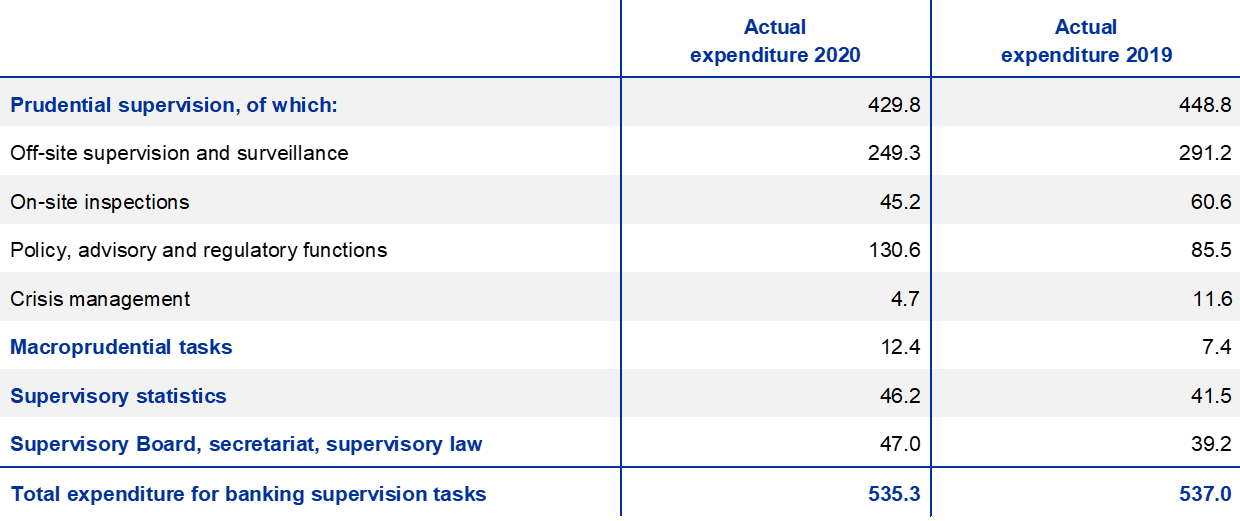
Source: ECB.
Note: Totals and subtotals in the table may not add up owing to rounding.
In 2020 there was a decrease in expenditure for business travel and consultancy support services related to direct supervision activities for SIs and LSIs, while the expenditure for data management, decision-making, policy and oversight functions increased. The decreases in other operating expenditure were partially offset by the growth in approved headcount referred to in Section 5.1.
With respect to business travel, the ECB’s expenditure decreased by over 80% in 2020 to stand at €2.4 million. To supplement its internal resources, the ECB engages the services of external consultants to provide either specialised expertise or integrated consultancy under qualified internal guidance to address temporary resource shortages. In total, the ECB spent €30.4 million on consultancy services for core supervisory tasks in 2020, €38.3 million less than in 2019. The main reason for this decrease was the conclusion of the targeted review of internal models in 2020. External support costs amounted to €3.3 million in 2020, compared with €34.9 million in 2019. In 2020, €14.6 million was spent on external resources for the comprehensive assessments, and a further €0.3 million on Brexit preparations. The ECB spent €4.6 million on external resources for the conduct of regular on-site supervision tasks, including cross-border missions. More information on these activities can be found in Chapter 1.
Chart 30
Cost of ECB supervisory tasks by cost category
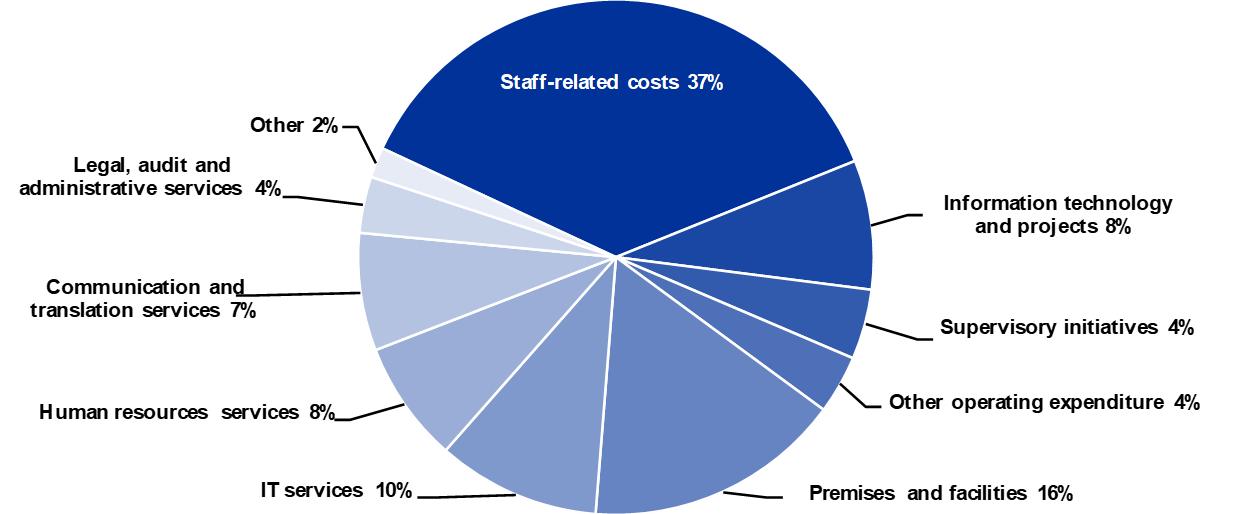
Source: ECB.
Note: Totals and subtotals in the table may not add up owing to rounding.
In addition to the more granular view of expenditure by supervisory activity, the ECB is also introducing new reporting on the split of costs by cost category, based on costs and shared services that are directly attributable to ECB Banking Supervision. This perspective focuses on the purpose of the expenditure and is supported by an improved cost allocation system that delivers enhanced reporting capabilities.
The directly attributable expenditures are composed of core supervisory staff costs; supervisory initiatives (including costs related to Brexit and comprehensive assessments); other operating expenditure, such as business travel and training; and dedicated information technology such as IMAS and the STAR (Stress Test Account Reporting) platform.
The shared services category encompasses services that are used by both the central banking function and the banking supervision function, clustered as follows: premises and facilities services, human resources services, shared information technology services, shared legal, audit and administrative services, communication and translation services, and other. The cost of these shared services is split between each function using a cost allocation mechanism that applies industry standard metrics such as full-time equivalents (FTEs), office space and number of translation requests. As the ECB is committed to rigorously pursuing efficiency improvements, it routinely refines the cost allocation metrics.
Directly attributable expenditure amounted to €284.5 million in 2020, or 53% of actual expenditure incurred, which stood at €535.3 million. Shared services accounted for €250.8 million, or 47% of the total. In 2020 almost all of the underspending in relation to the estimate published the previous year related to directly attributable expenditure. There was sustained high demand for shared services, meaning that the actual costs incurred reached 100% of the planned expenditure. For example, there was significant demand for shared information technology services because most staff worked remotely. Similarly, use of premises and facilities services was high. There is a high level of fixed costs for these services, and some expenditure was reprioritised to ensure that a safe working environment could be maintained at the ECB’s premises.
6.2 Outlook for banking supervision fees in 2021
ECB expenditure for supervisory tasks is expected to return to normal levels in 2021
There is still a lot of uncertainty surrounding supervisory planning and priorities for 2021, as the ECB continues to be flexible in its response to external factors. At this early juncture, a return to more normal expenditure levels for directly attributable core supervisory tasks is anticipated. Therefore, in 2021 expenditure is expected to rise by 11% compared with actual expenditure for 2020, which is nevertheless 2% lower than the published estimate for 2020.
Table 8
Estimated cost of ECB Banking Supervision in 2021 by function
(EUR millions)

Source: ECB.
Note: Totals and subtotals in the table may not add up owing to rounding.
The annual supervisory fee for 2021, to be levied in 2022, will only be known at the end of the fee period and will comprise the actual expenditure for the full year adjusted for amounts reimbursed to or collected from individual banks for previous fee periods, late payment interest received and non-collectible fees. The ratio of the total amount to be levied to each category is estimated to be 93% for significant institutions and 7% for less significant institutions.
Table 9
2021 estimate of expenditure for the ECB’s supervisory tasks
(EUR millions)

Source: ECB.
Note: Totals and subtotals in the table may not add up owing to rounding.
6.3 Fee framework for 2020
Together with the SSM Regulation, the Fees Regulation provides the legal framework within which the ECB levies an annual supervisory fee for the expenditure it incurs in conducting its supervisory tasks. The Fees Regulation and associated Decision[86] establish the methods for: (i) determining the total amount of the annual supervisory fee; (ii) calculating the amount to be paid by each supervised institution; and (iii) collecting the annual supervisory fee.
6.4 Progress on implementing the changes to the ECB supervisory fee framework
The ECB moved to ex post invoicing of actual costs in 2020
2020 was a transitional year as the ECB moved to ex post invoicing of supervisory fees and implemented changes stemming from the review of the ECB’s supervisory fee framework in 2019. Consequently, no annual supervisory fees were invoiced in 2020 for the 2020 fee period. It has been provisionally scheduled to invoice the fees in May 2021. In addition, to transition from an ex ante to an ex post collection of fees, the surplus for the 2019 fee period will be included.
Good progress has been made in implementing the changes to the framework. The technical changes required for the new language regime, under which the ECB will issue the fee notices in all official languages of the EU, are close to being finalised. The reuse of supervisory data available at the ECB, eliminating the separate provision of fee factor data for more than 90% of supervised entities and groups has been implemented. The new process includes an extended commentary period of 15 days, allowing banks to verify and submit any revisions to their data on fee factors. This verification process takes place from mid-January 2021. A new notification procedure was also established for those supervised groups that chose to exclude the assets of subsidiaries established in non-participating Member States and third countries from the calculation of their fees. As provided for in the ECB Decision[87], the groups had to notify the ECB of their decision at the latest by 30 September 2020. On 8 December 2020 the ECB granted a one-off exceptional extension to this deadline, permitting supervised groups to submit notifications until 30 December 2020. This one-off exception for the 2020 supervisory fee cycle was in recognition of the introduction of a new notification procedure within the revised supervisory fee framework at a time when COVID-19 had affected many institutions and disrupted their working processes. For 2021 the deadline will revert back to the standard date of 30 September. To improve the process in future cycles, the ECB is planning to further automate this notification procedure.
6.5 Total amount to be levied for the fee period 2020
The ECB will levy €514.3 million in supervisory fees for 2020
The annual supervisory fee to be levied in 2021 for the fee period 2020 amounts to €514.3 million. This is based on the actual expenditure for 2020, amounting to €535.3 million, as adjusted for: (i) the surplus of €22.0 million carried forward from the 2019 fee period[88] and (ii) €1.0 million (net) reimbursed to individual banks for previous fee periods and other adjustments, including late payment interest received.
The amount to be recovered via annual supervisory fees is split into two parts. This split is related to the status of supervised entities as either significant or less significant, reflecting the varying degrees of supervisory scrutiny by the ECB.
Table 10
Total income from banking supervision tasks
(EUR millions)

Source: ECB.
Note: Totals and subtotals in the table may not add up owing to rounding.
6.6 Individual supervisory fees
At bank level, the fees are calculated according to a bank’s importance and risk profile, using annual fee factors for the supervised banks. For most banks the reference date for the data is 31 December of the previous year. For banks that are newly supervised at the highest level of consolidation within the fee period[89] the ECB takes into account the total assets and the total risk exposure reported by the bank at the reference date closest to 31 December and uses these figures in the calculation of a variable fee component for all months for which a supervisory fee is payable by the fee debtor. The supervisory fee calculated per bank is then charged via annual payments.
Figure 4
The variable fee component is determined by a bank’s importance and risk profile
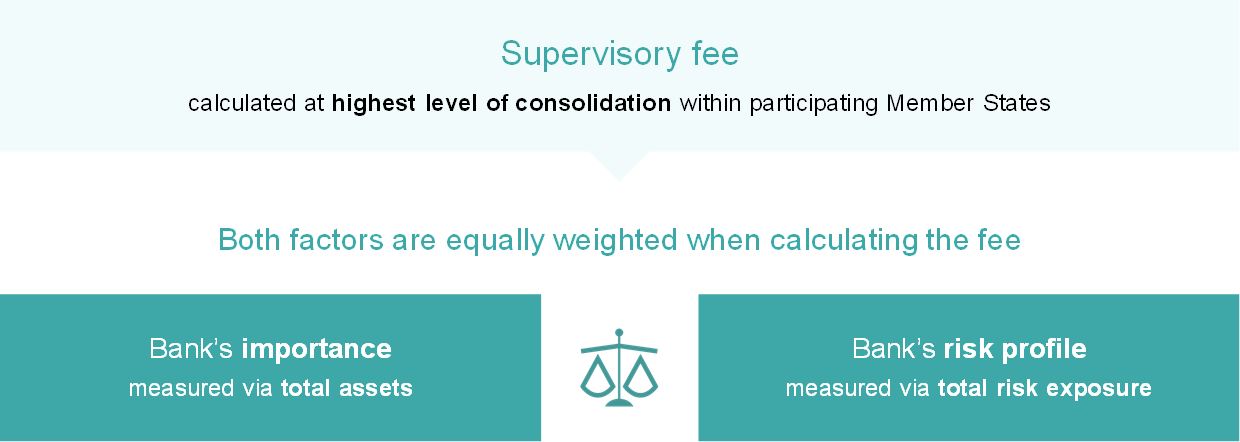
The supervisory fee is set at the highest level of consolidation within Member States participating in the SSM. It contains a variable fee component and a minimum fee component. The latter applies equally to all banks and is based on 10% of the total amount to be recovered. For the smallest significant banks, with total assets of €10 billion or less, the minimum fee component is halved. Since 2020 the minimum fee has also been halved for small less significant institutions with total assets of €1 billion or less.
Article 7 of the Fees Regulation provides that the following changes in the situation of an individual bank require an amendment of the corresponding supervisory fee: (i) a change in the supervisory status of the supervised entity, i.e. the entity is reclassified from significant to less significant or vice versa; (ii) a new supervised entity is authorised; or (iii) an existing authorisation is withdrawn. Changes related to previous fee periods which resulted in new supervisory fee decisions by the ECB totalled €1.0 million in 2020, which will be included in the annual supervisory fees to be invoiced in 2021.
More information on supervisory fees is available on the ECB’s banking supervision website. These pages are updated regularly and are published in all official EU languages.
6.7 Other income related to banking supervisory tasks
The ECB is entitled to impose administrative penalties on supervised entities for failure to comply with obligations under EU banking prudential regulation (including ECB supervisory decisions). The related income is not considered in the calculation of the annual supervisory fees. The Fees Regulation ensures that neither damages payable to third parties nor administrative penalties (sanctions) payable to the ECB by supervised entities have any influence on the supervisory fee.
The administrative penalties on supervised entities are recorded as income in the ECB’s profit and loss account. In 2020 no income arose from penalties on supervised entities, as no sanctions were imposed.[90]
7 Legal instruments adopted by the ECB
The legal instruments adopted by the ECB include regulations, decisions, guidelines, recommendations and instructions to NCAs (mentioned in Article 9(1)(3) of the SSM Regulation and Article 22 of the SSM Framework Regulation). This section lists the legal instruments concerning banking supervision that were adopted in 2020 by the ECB and published in the Official Journal of the European Union and/or on the ECB’s website. It covers legal instruments adopted pursuant to Article 4(3) of the SSM Regulation and other relevant legal instruments.
7.1 ECB regulations
ECB/2020/22Regulation (EU) 2020/605 of the European Central Bank of 9 April 2020 amending Regulation (EU) 2015/534 on reporting of supervisory financial information (OJ L 145, 7.5.2020, p. 1)
7.2 ECB legal instruments other than regulations
ECB/2020/1Recommendation of the European Central Bank of 17 January 2020 on dividend distribution policies (OJ C 30, 29.1.2020, p. 1)
ECB/2020/16Guideline (EU) 2020/497 of the European Central Bank of 20 March 2020 on the recording of certain data by national competent authorities in the Register of Institutions and Affiliates Data (OJ L 106, 6.4.2020, p. 3)
ECB/2020/19Recommendation of the European Central Bank of 27 March 2020 on dividend distributions during the COVID-19 pandemic and repealing Recommendation ECB/2020/1 (OJ C 102I, 30.3.2020, p. 1)
ECB/2020/30Decision (EU) 2020/1015 of the European Central Bank of 24 June 2020 on the establishment of close cooperation between the European Central Bank and Българска народна банка (Bulgarian National Bank) (OJ L 224I, 13.7.2020, p. 1)
ECB/2020/31Decision (EU) 2020/1016 of the European Central Bank of 24 June 2020 on the establishment of close cooperation between the European Central Bank and Hrvatska Narodna Banka (OJ L 224I, 13.7.2020, p. 4)
ECB/2020/32Guideline (EU) 2020/978 of the European Central Bank of 25 June 2020 on the exercise of the discretion under Article 178(2)(d) of Regulation (EU) No 575/2013 of the European Parliament and of the Council by national competent authorities in relation to less significant institutions with regard to the threshold for assessing the materiality of credit obligations past due (OJ L 217, 8.7.2020, p. 5)
ECB/2020/35Recommendation of the European Central Bank of 27 July 2020 on dividend distributions during the COVID-19 pandemic and repealing Recommendation ECB/2020/19 (OJ C 251, 31.7.2020, p. 1)
ECB/2020/39Decision (EU) 2020/1331 of the European Central Bank of 15 September 2020 nominating heads of work units to adopt delegated fit and proper decisions and repealing Decision (EU) 2017/936 (OJ L 312, 25.9.2020, p. 34)
ECB/2020/40Decision (EU) 2020/1332 of the European Central Bank of 15 September 2020 nominating heads of work units to adopt delegated decisions on the significance of supervised entities and repealing Decision (EU) 2017/937 (OJ L 312, 25.9.2020, p. 36)
ECB/2020/41Decision (EU) 2020/1333 of the European Central Bank of 15 September 2020 nominating heads of work units to adopt delegated own funds decisions and repealing Decision (EU) 2018/547 (OJ L 312, 25.9.2020, p. 38)
ECB/2020/42Decision (EU) 2020/1334 of the European Central Bank of 15 September 2020 nominating heads of work units to adopt delegated decisions regarding supervisory powers granted under national law and repealing Decision (EU) 2019/323 (OJ L 312, 25.9.2020, p. 40)
ECB/2020/43Decision (EU) 2020/1335 of the European Central Bank of 15 September 2020 nominating heads of work units to adopt delegated decisions on passporting, acquisition of qualifying holdings and withdrawal of authorisations of credit institutions and repealing Decision (EU) 2019/1377 (OJ L 312, 25.9.2020, p. 42)
ECB/2020/44Decision (EU) 2020/1306 of the European Central Bank of 16 September 2020 on the temporary exclusion of certain exposures to central banks from the total exposure measure in view of the COVID-19 pandemic (OJ L 305, 21.9.2020, p. 30)
ECB/2020/62Recommendation of the European Central Bank of 15 December 2020 on dividend distributions during the COVID-19 pandemic and repealing Recommendation ECB/2020/35 (OJ C 437, 18.12.2020, p. 1)
Amendment 1/2020 of 23 July 2020 to the Rules of Procedure of the Supervisory Board of the European Central Bank (OJ L 241, 27.7.2020, p. 43)
© European Central Bank, 2021
Postal address 60640 Frankfurt am Main, Germany
Telephone +49 69 1344 0
Website www.bankingsupervision.europa.eu
All rights reserved. Reproduction for educational and non-commercial purposes is permitted provided that the source is acknowledged.
The cut-off date for data included in this report was 31 December 2020.
For specific terminology please refer to the SSM glossary (English only).
PDF ISBN 978-92-899-4705-3, ISSN 2443-5805, doi:10.2866/78975, QB-BU-21-001-EN-N
HTML ISBN 978-92-899-4725-1, ISSN 2443-5805, doi:10.2866/217422, QB-BU-21-001-EN-Q
- See “ECB extends recommendation not to pay dividends until January 2021 and clarifies timeline to restore buffers”, ECB press release, 28 July 2020, and “ECB asks banks to refrain from or limit dividends until September 2021”, ECB press release, 15 December 2020. See also Box 1 – Measures taken by ECB Banking Supervision to address the COVID-19 pandemic.
- For more details on capital developments, see the 2020 SREP aggregate results.
- See Box 1 – Measures taken by ECB Banking Supervision to address the COVID-19 pandemic.
- See the ECB’s letters to banks on operational capacity to deal with distressed debtors in the context of the coronavirus (COVID-19) pandemic, July 2020, and identification and measurement of credit risk in the context of the coronavirus (COVID-19) pandemic, December 2020.
- See Section 1.2.6. for more details on IT and cyber risk.
- For further information, see the related press release and accompanying presentation.
- See Section 1.4. for more details on the LSIs sector assessment.
- See also Section 1.2.1 – Supervisory priorities for 2020 and the pragmatic approach to SREP.
- The figure for the third quarter of 2020 is annualised.
- See Box 1 – Measures taken by ECB Banking Supervision to address the COVID-19 pandemic.
- Regulation (EU) 2019/876 of the European Parliament and of the Council of 20 May 2019 amending Regulation (EU) No 575/2013 as regards the leverage ratio, the net stable funding ratio, requirements for own funds and eligible liabilities, counterparty credit risk, market risk, exposures to central counterparties, exposures to collective investment undertakings, large exposures, reporting and disclosure requirements, and Regulation (EU) No 648/2012 (OJ L 150, 7.6.2019, p. 1).
- See the ECB’s letters to banks on operational capacity to deal with distressed debtors in the context of the coronavirus (COVID-19) pandemic, 28 July 2020 and identification and measurement of credit risk in the context of the coronavirus (COVID-19) pandemic, 4 December 2020.
- Guidelines of the European Banking Authority of 23 July 2020 on the pragmatic 2020 supervisory review and evaluation process in light of the COVID-19 crisis (EBA/GL/2020/10).
- See the 2020 SREP aggregate results and Pillar 2 Requirement (P2R).
- “Trends and risks in credit underwriting standards of significant institutions in the Single Supervisory Mechanism – main findings from the credit underwriting data collection 2019”, ECB, June 2020.
- Under the NPL Guidance, SIs with higher levels of NPLs (referred to as “high-NPL banks”) are required to submit their NPL and foreclosed asset reduction strategies and to define their portfolio-level reduction targets over the medium term and update them annually.
- See the ECB’s letters to banks on IFRS 9 in the context of the coronavirus (COVID-19) pandemic, April 2020; operational capacity to deal with distressed debtors in the context of the coronavirus (COVID‑19) pandemic, July 2020; and identification and measurement of credit risk in the context of the coronavirus (COVID-19) pandemic, December 2020.
- Guidelines of the European Banking Authority of 2 April 2020 on legislative and non-legislative moratoria on loan repayments applied in the light of the COVID-19 crisis (EBA/GL/2020/02).
- Guidelines of the European Banking Authority of 31 October 2018 on management of non-performing and forborne exposures (EBA/GL/2018/06).
- A cyber incident – i.e. an identified possible breach of information security (both malicious and accidental) – must be reported to the ECB if at least one of the following conditions is met: (1) there is a potential financial impact of €5 million or 0.1% of CET1 or more; (2) the incident has been publicly reported or causes reputational damage; (3) the incident has been escalated to the Chief Information Officer outside of regular reporting; (4) the bank has notified the incident to the computer emergency response team/computer security incident response team, a security agency or the police; (5) disaster recovery or business continuity procedures have been triggered or a cyber insurance claim has been filed; (6) there has been a breach of legal or regulatory requirements; or (7) the bank uses internal criteria and expert judgement (including a potential systemic impact) and decides to inform the ECB.
- Annual report on the outcome of the SREP IT Risk Questionnaire, Feedback to the industry, June 2020.
- Effective Practices for Cyber Incident Response and Recovery, Consultative Document, FSB, 20 April 2020.
- Principles for operational resilience, Basel Committee on Banking Supervision, August 2020.
- Guidelines of the European Banking Authority of 29 November 2019 on ICT and security risk management (EBA/GL/2019/04).
- See, for example, “Brexit: time to move to post-Brexit business models”, Supervision Newsletter, ECB Banking Supervision, 12 February 2020 and “Brexit: banks should prepare for year-end and beyond”, Supervision Newsletter, ECB Banking Supervision, 18 November 2020.
- Including TRIM decisions and excluding follow-up decisions on ancillary provisions.
- The analysis was conducted on a sample of 134 OSIs for which final reports were released between October 2019 and October 2020.
- Compared with previous years, the overall amounts are smaller given the interruption of the on-site programme following the outbreak of the COVID-19 pandemic.
- Guidelines of the European Banking Authority of 23 July 2020 on the pragmatic 2020 supervisory review and evaluation process in light of the COVID-19 crisis (EBA/GL/2020/10).
- Guidelines of the European Banking Authority of 2 April 2020 on legislative and non-legislative moratoria on loan repayments applied in the light of the COVID-19 crisis (EBA/GL/2020/02).
- The LSI SREP methodology is based on the SREP guidelines developed by the EBA and builds on the ECB’s approach to SIs and on existing national methodologies. In 2019 the methodology was applied to high-priority LSIs and was envisaged to be applied to all LSIs in 2020.
- Council Regulation (EU) No 1024/2013 of 15 October 2013 conferring specific tasks on the European Central Bank concerning policies relating to the prudential supervision of credit institutions (OJ L 287, 29.10.2013, p. 63).
- BNP Paribas, Deutsche Bank, Groupe BPCE, Groupe Crédit Agricole, ING Bank, Santander, Société Générale and UniCredit.
- In line with Article 5(2) of the SSM Regulation, the ECB may apply (i) higher requirements for relevant capital buffers than those applied by the national authorities, and (ii) more stringent measures aimed at addressing systemic or macroprudential risks.
- Recommendation of the European Systemic Risk Board of 27 May 2020 on restriction of distributions during the COVID-19 pandemic (ESRB/2020/7) (OJ C 212, 26.6.2020, p. 1).
- Eurosystem staff macroeconomic projections for the euro area, December 2020.
- See “ECB publishes final guide on climate-related and environmental risks for banks”, ECB press release, 27 November 2020.
- For the third year in a row, the ECB has identified climate-related risks as a key risk driver in the SSM Risk Map for the banking system.
- See also the keynote speech by Andrea Enria, Chair of the Supervisory Board of the ECB, at the European Central Bank Climate and Environmental Risks Webinar on 17 June 2020.
- See the deep-dive on climate-related risk included in the ECB report on banks’ ICAAP practices.
- Regulation (EU) No 468/2014 of the European Central Bank of 16 April 2014 establishing the framework for cooperation within the Single Supervisory Mechanism between the European Central Bank and national competent authorities and with national designated authorities (SSM Framework Regulation) (OJ L 141, 14.5.2014, p. 1).
- These criteria are set out in Article 6(4) of the SSM Regulation.
- The list of SIs and less significant institutions (LSIs) published in December 2020 reflects (i) the significance decisions notified to the supervised institutions up to and including 30 November 2020, and (ii) other changes and developments in group structures effective before 1 November 2020.
- The decrease in the number of supervised entities is the result of the methodological change and refers specifically to the three entities in Slovakia.
- Regulation (EU) No 806/2014 of the European Parliament and of the Council of 15 July 2014 establishing uniform rules and a uniform procedure for the resolution of credit institutions and certain investment firms in the framework of a Single Resolution Mechanism and a Single Resolution Fund and amending Regulation (EU) No 1093/2010 (OJ L 225, 30.7.2014, p. 1). See also “ECB has assessed that AS PNB Banka in Latvia was failing or likely to fail”, ECB press release, 15 August 2019.
- This also includes a small number of requests for additional non-executive directorships.
- Some decisions cover more than one authorisation assessment (e.g. fit and proper assessments of several board members of the same SI or acquisitions of qualifying holdings in different subsidiaries resulting from a single transaction). Some authorisation procedures, such as passporting and lapsing procedures, do not require a formal ECB decision.
- These decisions refer to procedures which are subject to the delegation frameworks approved under Decision (EU) 2017/935 of the European Central Bank of 16 November 2016 on delegation of the power to adopt fit and proper decisions and the assessment of fit and proper requirements (ECB/2016/42) (OJ L 141, 1.6.2017), and Decision (EU) 2019/1376 of the European Central Bank of 23 July 2019 on delegation of the power to adopt decisions on passporting, acquisition of qualifying holdings and withdrawal of authorisations of credit institutions (ECB/2019/23) (OJ L 224, 28.8.2019).
- A “mixed financial holding company” is defined in Article 2(15) of Directive 2002/87/EC of the European Parliament and of the Council of 16 December 2002 on the supplementary supervision of credit institutions, insurance undertakings and investment firms in a financial conglomerate and amending Council Directives 73/239/EEC, 79/267/EEC, 92/49/EEC, 92/96/EEC, 93/6/EEC and 93/22/EEC, and Directives 98/78/EC and 2000/12/EC of the European Parliament and of the Council (OJ L 35, 11.2.2003, p. 1) (the Financial Conglomerates Directive) as “a parent undertaking, other than a regulated entity, which together with its subsidiaries, at least one of which is a regulated entity which has its head office in the Community, and other entities, constitutes a financial conglomerate”. Pursuant to Article 2(20) of the SSM Framework Regulation, a mixed financial holding company qualifies as supervised entity if it fulfils the conditions laid down in Article 2(21)(b) of that Regulation.
- See Section 5.3 – Transparency and communication.
- “ECB launches public consultation on its supervisory approach to consolidation”, ECB press release, 1 July 2020.
- “Risk management and internal controls” comprises the mechanisms or processes that an entity needs to have in place for the adequate identification, management and reporting of the risks it is or might be exposed to. “Management body functions” refers to the extent to which the persons who effectively direct the business of an institution – or those who are empowered to set the institution’s strategy, objectives and overall direction, and oversee and monitor management decision-making – comply with their responsibilities.
- See “FAQs on ECB supervisory measures in reaction to the coronavirus”, last updated 15 December 2020.
- The ORC is the extent to which recovery options would allow a bank to restore its financial position following a stress situation.
- For more details on the impact of COVID-19 on banks’ ORC see the article “COVID-19 exposes weaknesses in banks’ recovery plans” in the February 2021 edition of the Supervision Newsletter.
- See Enria, A. and Fernandez-Bollo, E., “Fostering the cross-border integration of banking groups in the banking union”, The Supervision Blog, ECB Banking Supervision, October 2020.
- See Section 3.1 – Interaction with the Single Resolution Board.
- Decision (EU) 2020/1015 of the ECB of 24 June 2020 on the establishment of close cooperation between the ECB and Българска народна банка (Bulgarian National Bank) (ECB/2020/30) (OJ L 224I, 13.7.2020, p. 1) and Decision (EU) 2020/1016 of the ECB of 24 June 2020 on the establishment of close cooperation between the ECB and Hrvatska Narodna Banka (ECB/2020/31) (OJ L 224I, 13.7.2020, p. 4). The agreement on the inclusion of the Bulgarian lev and the Croatian kuna in the Exchange Rate Mechanism II entered into force simultaneously.
- See “ECB concludes comprehensive assessment of five Croatian banks”, ECB press release, 5 June 2020.
- For Bulgaria, the comprehensive assessment was completed on 26 July 2019, as reported in the 2019 ECB Annual Report on supervisory activities.
- See “ECB lists Bulgarian and Croatian banks it will directly supervise as of October 2020”, ECB press release, 11 September 2020.
- See “Basel Committee coordinates policy and supervisory response to Covid-19”, BCBS press release, 20 March 2020.
- See “Governors and Heads of Supervision announce deferral of Basel III implementation to increase operational capacity of banks and supervisors to respond to Covid-19”, BCBS press release, 27 March 2020.
- See “Basel Committee sets out additional measures to alleviate the impact of Covid-19”, BCBS press release, 3 April 2020.
- See “Governors and Heads of Supervision commit to ongoing coordinated approach to mitigate Covid-19 risks to the global banking system and endorse future direction of Basel Committee work”, BCBS press release, 30 November 2020.
- Article 16 of Regulation 1093/2010 of the European Parliament and of the Council of 24 November 2010 establishing a European Supervisory Authority (European Banking Authority), amending Decision No 716/2009/EC and repealing Commission Decision 2009/78/EC (OJ L 331, 15.12.2010, p. 12).
- “The ESCB input into the EBA feasibility report under article 430c of the Capital Requirements Regulation (CRR 2)”, ECB, Frankfurt am Main, September, 2020.
- Directive (EU) 2018/843 of the European Parliament and of the Council of 30 May 2018 amending Directive (EU) 2015/849 on the prevention of the use of the financial system for the purposes of money laundering or terrorist financing, and amending Directives 2009/138/EC and 2013/36/EU (OJ L 156, 19.6.2018, p. 43).
- “Communication from the Commission on an Action Plan for a comprehensive Union policy on preventing money laundering and terrorist financing”, European Commission, Brussels, 7 May 2020.
- One of the guiding principles for organisational design was that, if a division has more than 15 members of staff from the assigned headcount, the creation of sections should be considered. For business areas working on bank-specific line supervision, a section may be established for six or more staff members. For other business areas in banking supervision, eight to ten members of staff warrant the creation of a separate section. This approach aligns the span of control for the management heading sections and divisions, respectively.
- For further details, see Annex 1 of “The operational efficiency of the ECB’s crisis management for banks”, ECA Special Report, No 2, 2018.
- The Steering Committee supports the activities of the Supervisory Board and prepares the Board’s meetings. It is composed of the Chair of the Supervisory Board, the Vice-Chair of the Supervisory Board, one ECB representative and five representatives of national supervisors. The five representatives of national supervisors are appointed by the Supervisory Board for one year based on a rotation system that ensures a fair representation of countries.
- These decisions refer to decisions that were finalised or adopted in the reporting period (i.e. outgoing decisions). The number of supervisory decisions does not correspond to the number of authorisation procedures that were officially notified to the ECB in the reporting period (i.e. incoming notification procedures).
- Of these, 196 were approved by senior management within the framework for delegation.
- Under Article 6.7 of the Supervisory Board’s Rules of Procedure, decisions may also be taken by written procedure, unless at least three members of the Supervisory Board who have a voting right object. In such cases, the item is put on the agenda of the subsequent Supervisory Board meeting. A written procedure normally requires at least five working days for consideration by the Supervisory Board.
- The ABoR is an ECB body comprising members who are individually and collectively independent from the ECB and are entrusted with the task of reviewing decisions adopted by the Governing Council on supervisory matters upon an admissible request for review. The ABoR is composed of five members: Jean-Paul Redouin (Chair), Concetta Brescia Morra (Vice-Chair), Javier Arístegui, André Camilleri, Gerd Häusler, and two alternates: René Smits and Ivan Šramko.
- See Article 24(7) of the SSM Regulation.
- Guideline (EU) 2015/856 of the European Central Bank of 12 March 2015 laying down the principles of an Ethics Framework for the Single Supervisory Mechanism (ECB/2015/12) (OJ L 135, 2.6.2015, p. 29).
- Articles 11, 12 and 17 of the single Code of Conduct for high-level ECB officials.
- Decision ECB/2014/39 also contains provisions relating to organisational aspects.
- Decision of the European Central Bank of 17 September 2014 on the implementation of separation between the monetary policy and supervision functions of the European Central Bank (ECB/2014/39) (OJ L 300, 18.10.2014, p. 57).
- The Capital Requirements Regulation specifies the reporting obligations under FINREP (FINancial REPorting) and COREP (COmmon REPorting) for credit institutions. These reporting obligations are further detailed in Commission Implementing Regulation (EU) No 680/2014 laying down implementing technical standards with regard to supervisory reporting of institutions according to Regulation (EU) No 575/2013 of the European Parliament and of the Council (OJ L 191, 28.6.2014, p. 1). FINREP is the framework for collecting financial information from banking institutions. COREP is the framework for collecting information relative to the Pillar 1 calculation.
- The SSM-wide data collection database is an initiative to further streamline the supervisory reporting requirements set by the ECB and the NCAs and improve internal governance. It collects information on all of the data requests sent to directly supervised institutions, with this information being used to increase the transparency of data requests sent to banks and analyse the reporting burden.
- These shared services include premises and facilities, human resources management, administrative services, budgeting and controlling, accounting, legal, communication and translation services, internal audit, and statistical and information technology services.
- Regulation (EU) No 1163/2014 of the European Central Bank of 22 October 2014 on supervisory fees (ECB/2014/41).
- Decision (EU) 2019/2158 of the European Central Bank on the methodology and procedures for the determination and collection of data regarding fee factors used to calculate annual supervisory fees (ECB/2019/38) (OJ L 327, 17.12.2019, p. 99).
- See Article 4 of Decision (EU) 2019/2158.
- The carry forward to the 2020 fee period of -€22.0 million comprises -€23.1 million for significant entities or significant groups and +€1.1 million for less significant entities or less significant groups.
- For entities established after 1 October, the supervisory fee charged consists of a minimum fee component only for the number of full months supervised.
- Further information on enforcement and sanctioning can be found in Section 2.2 of this report.

